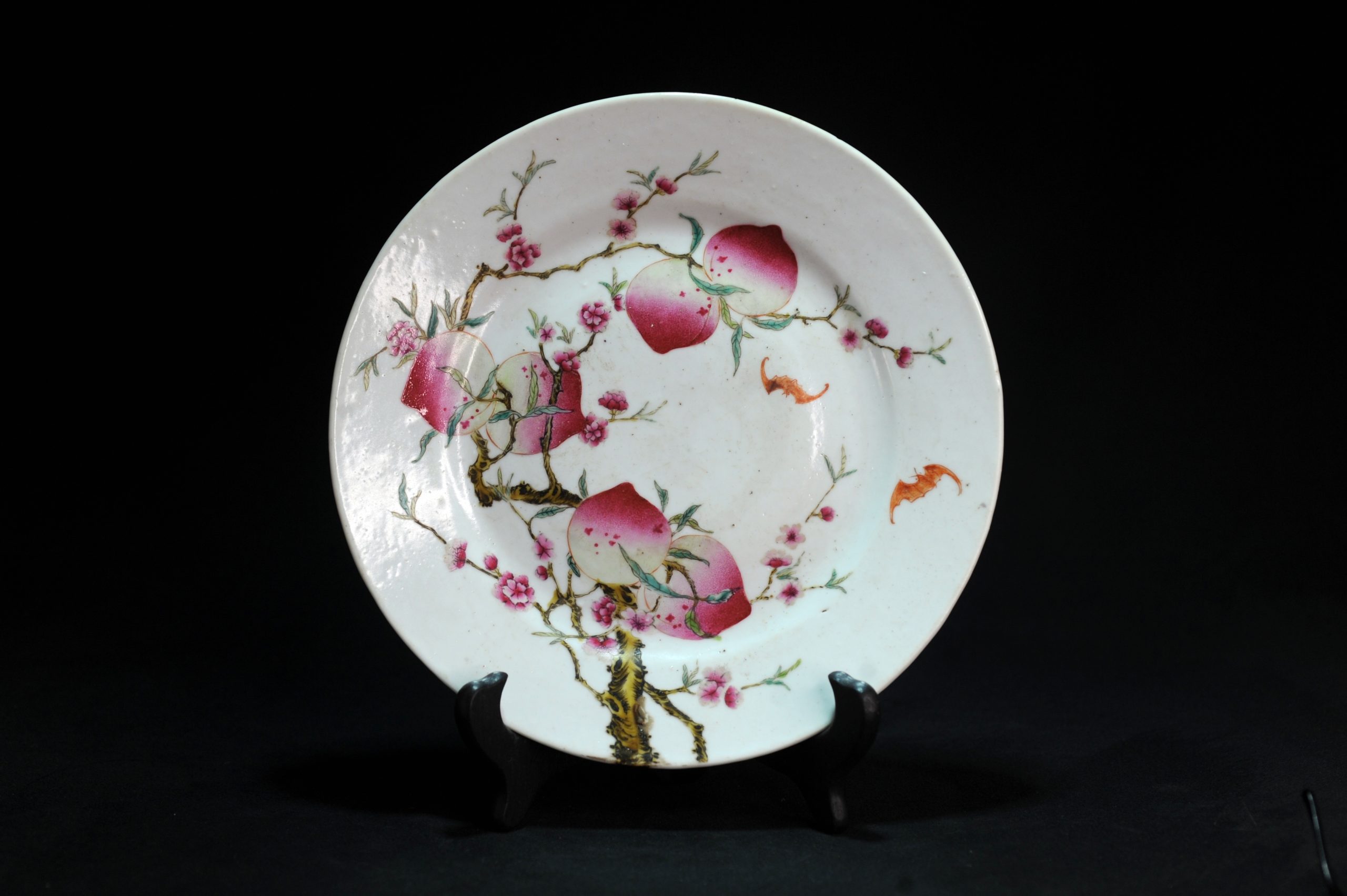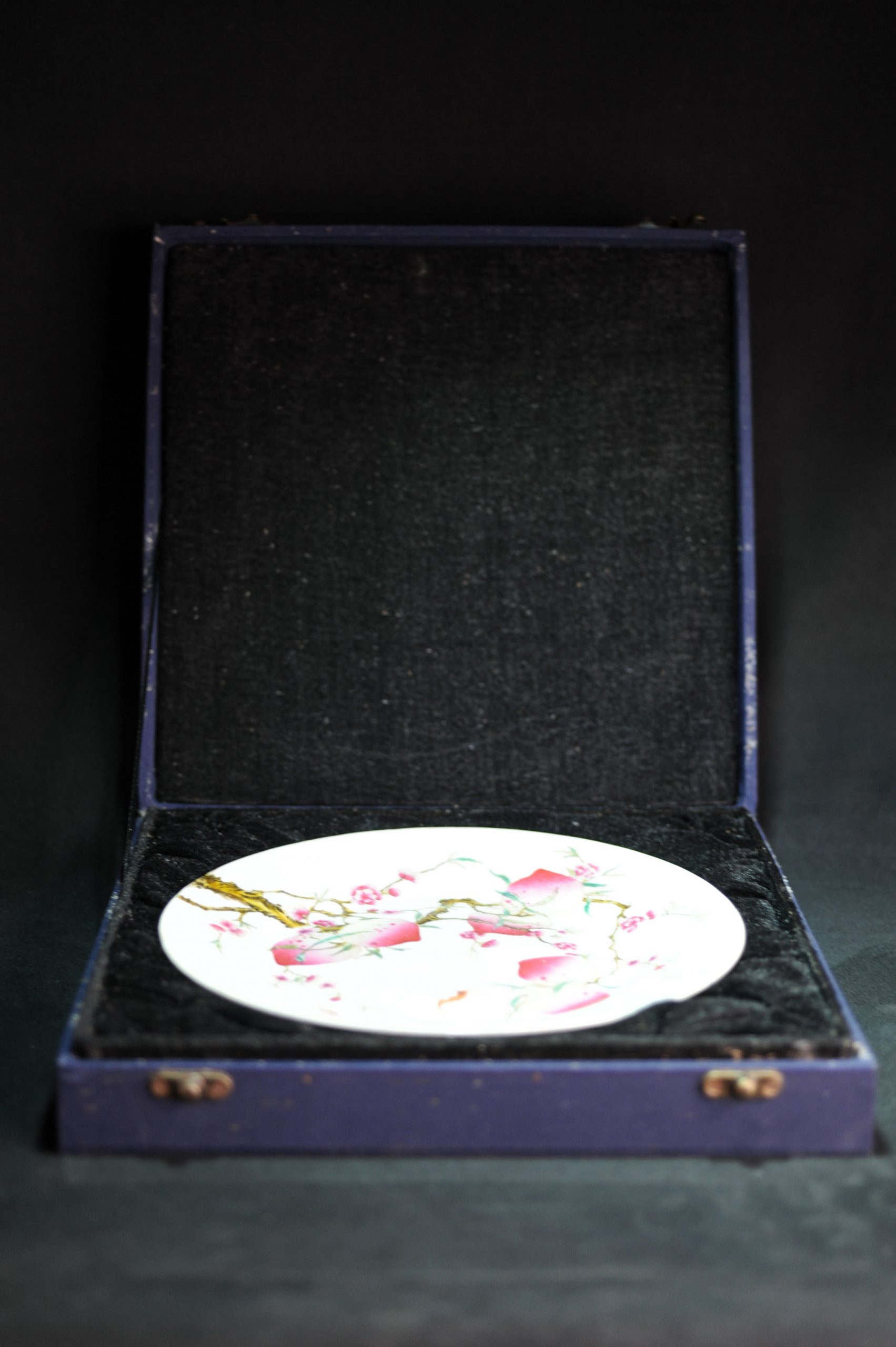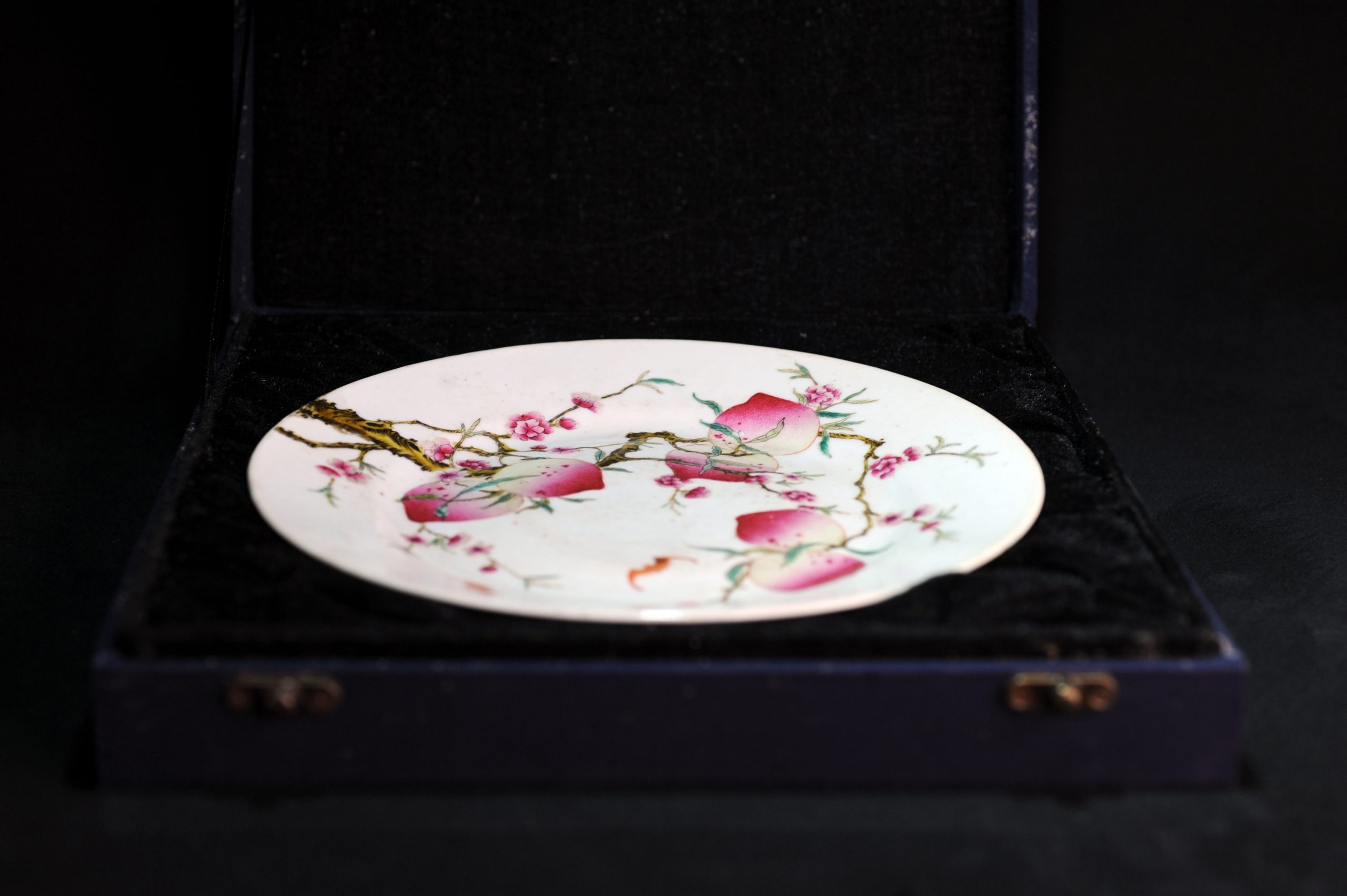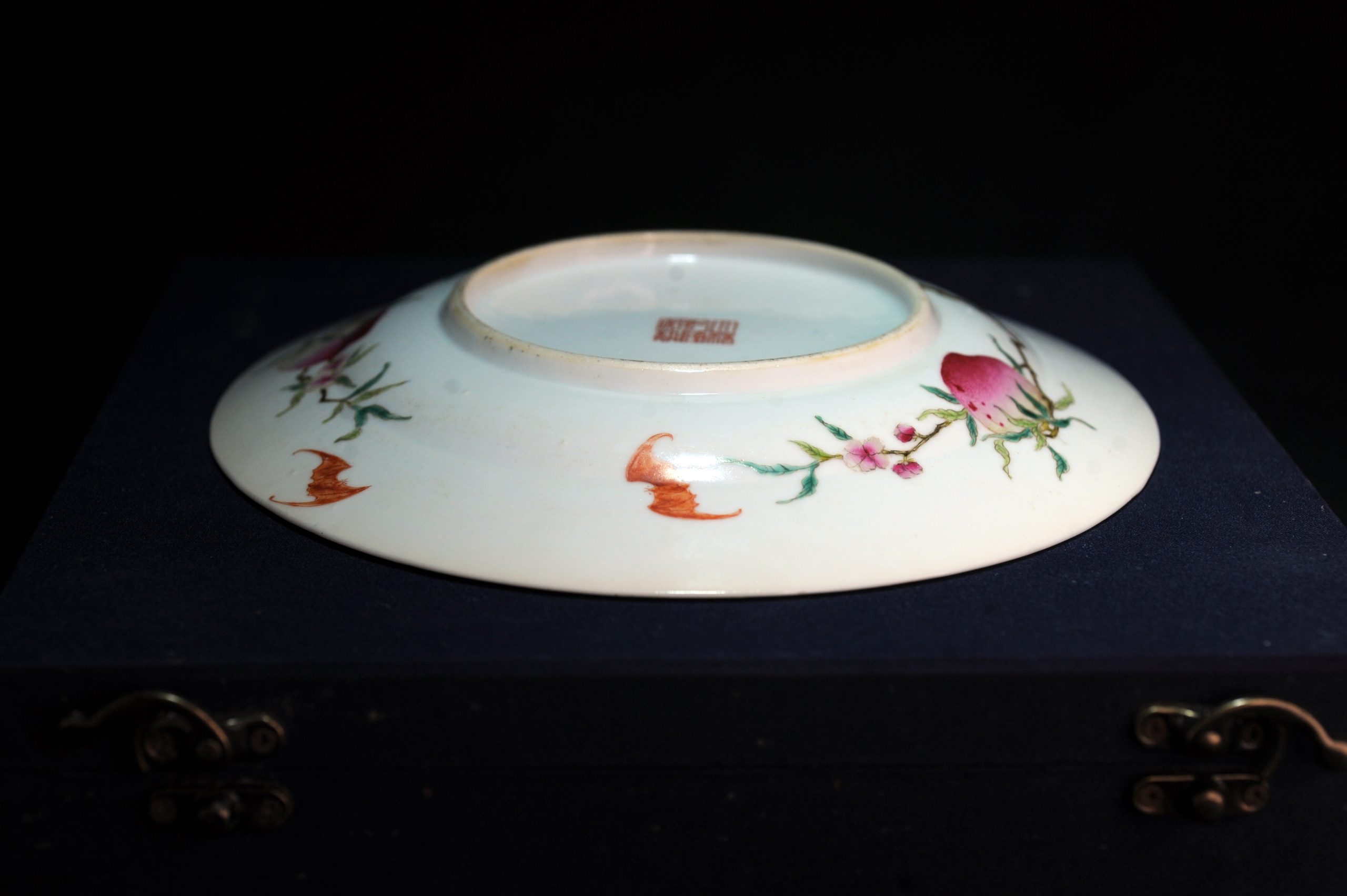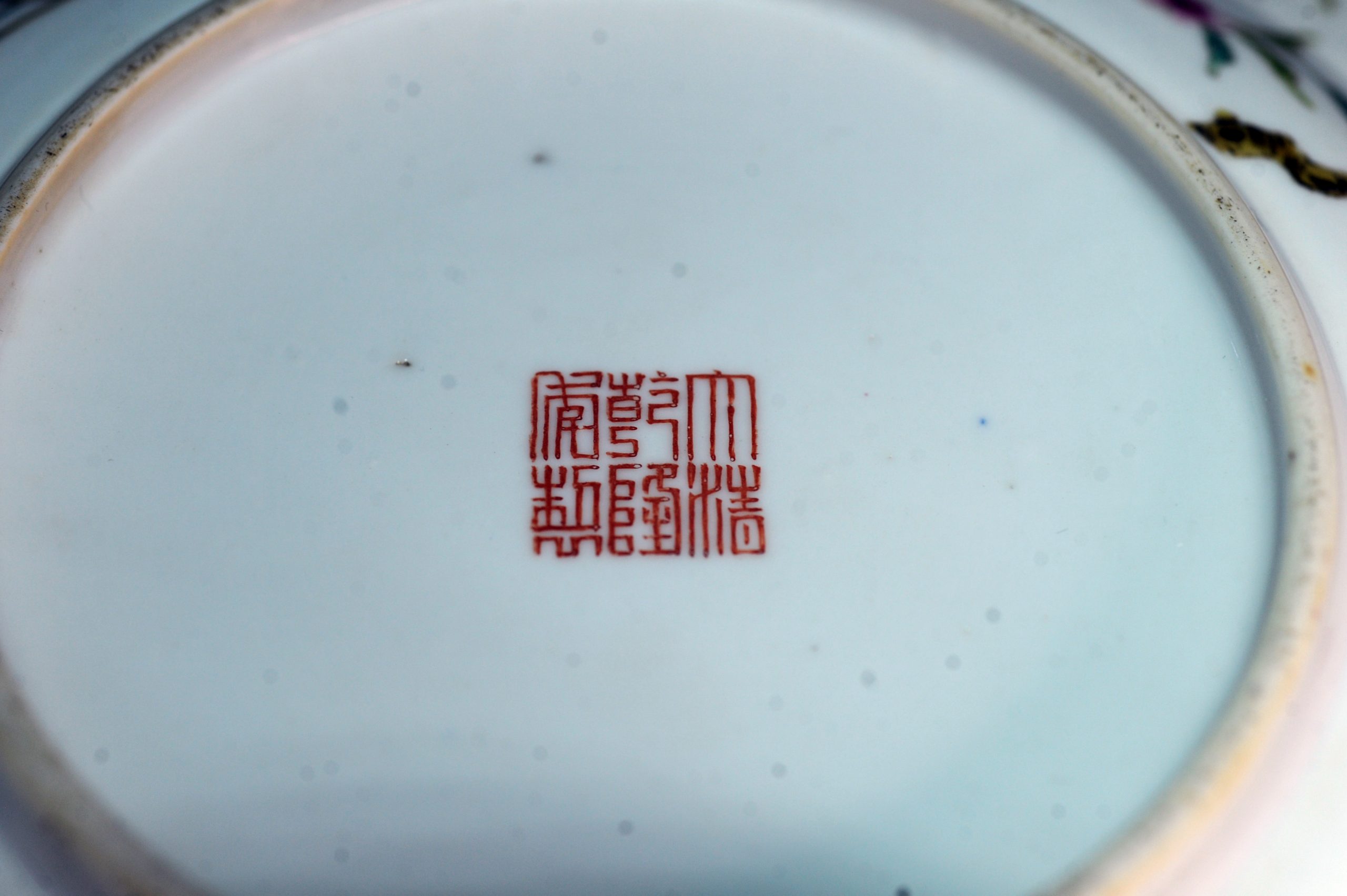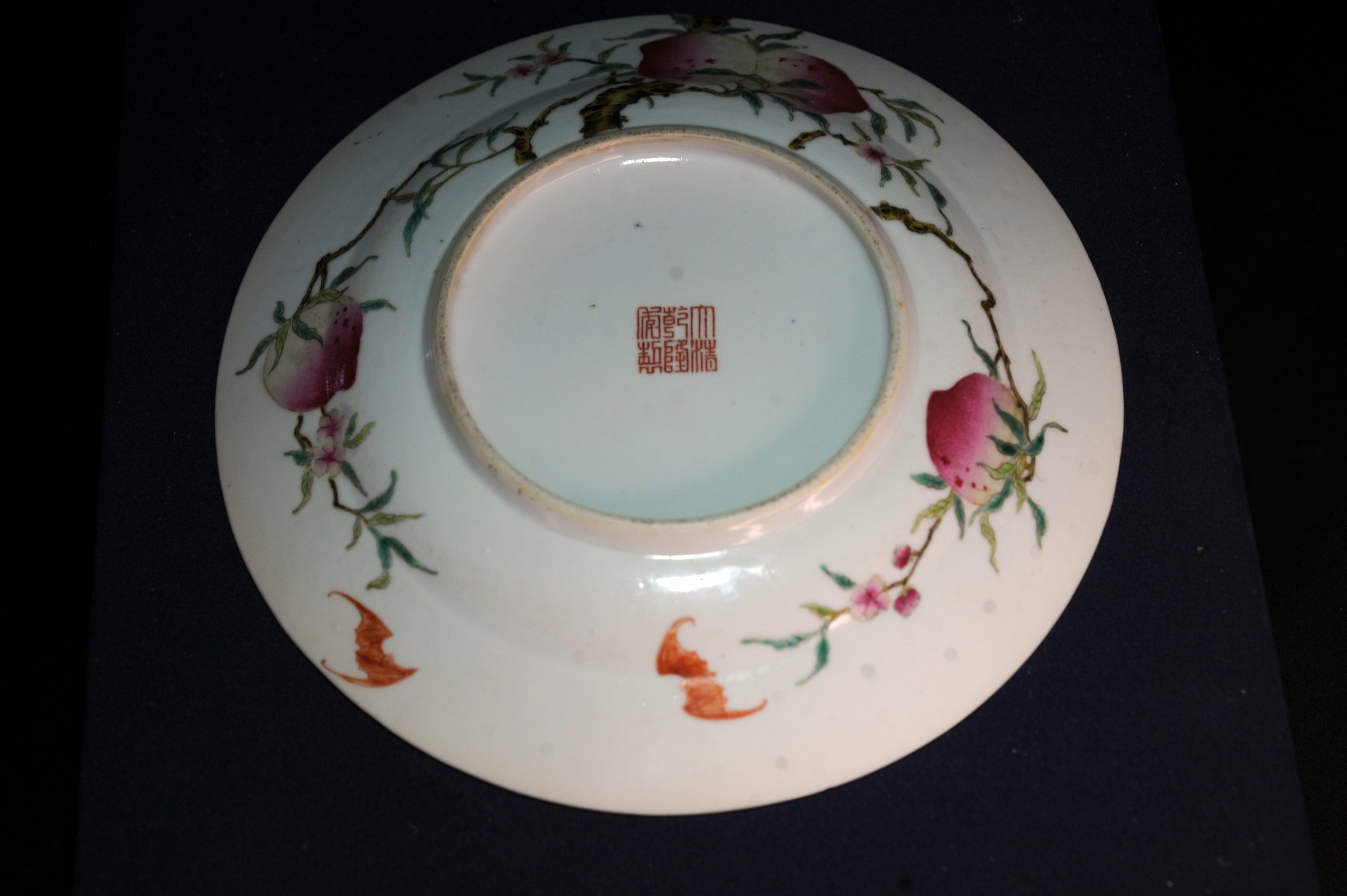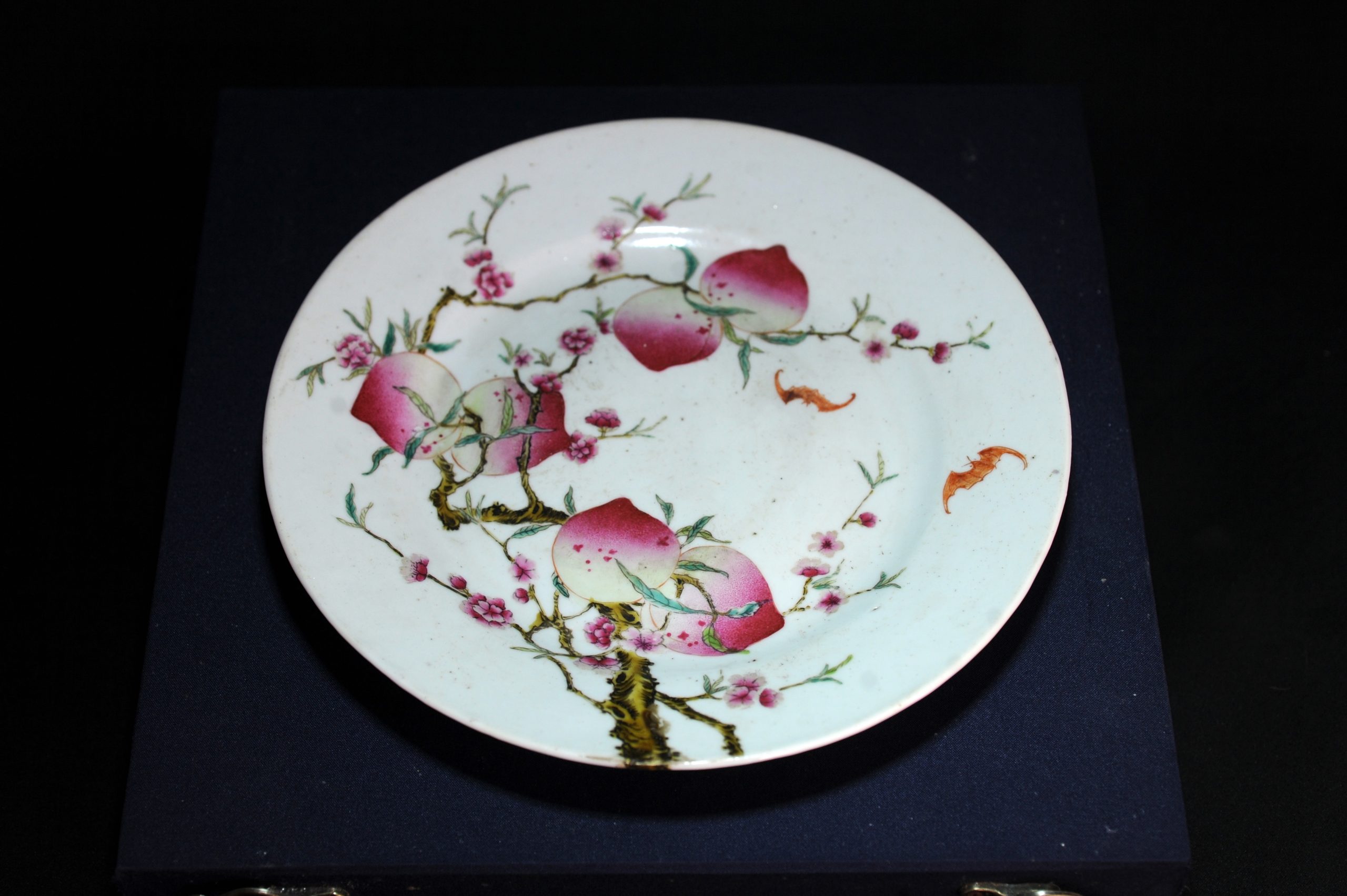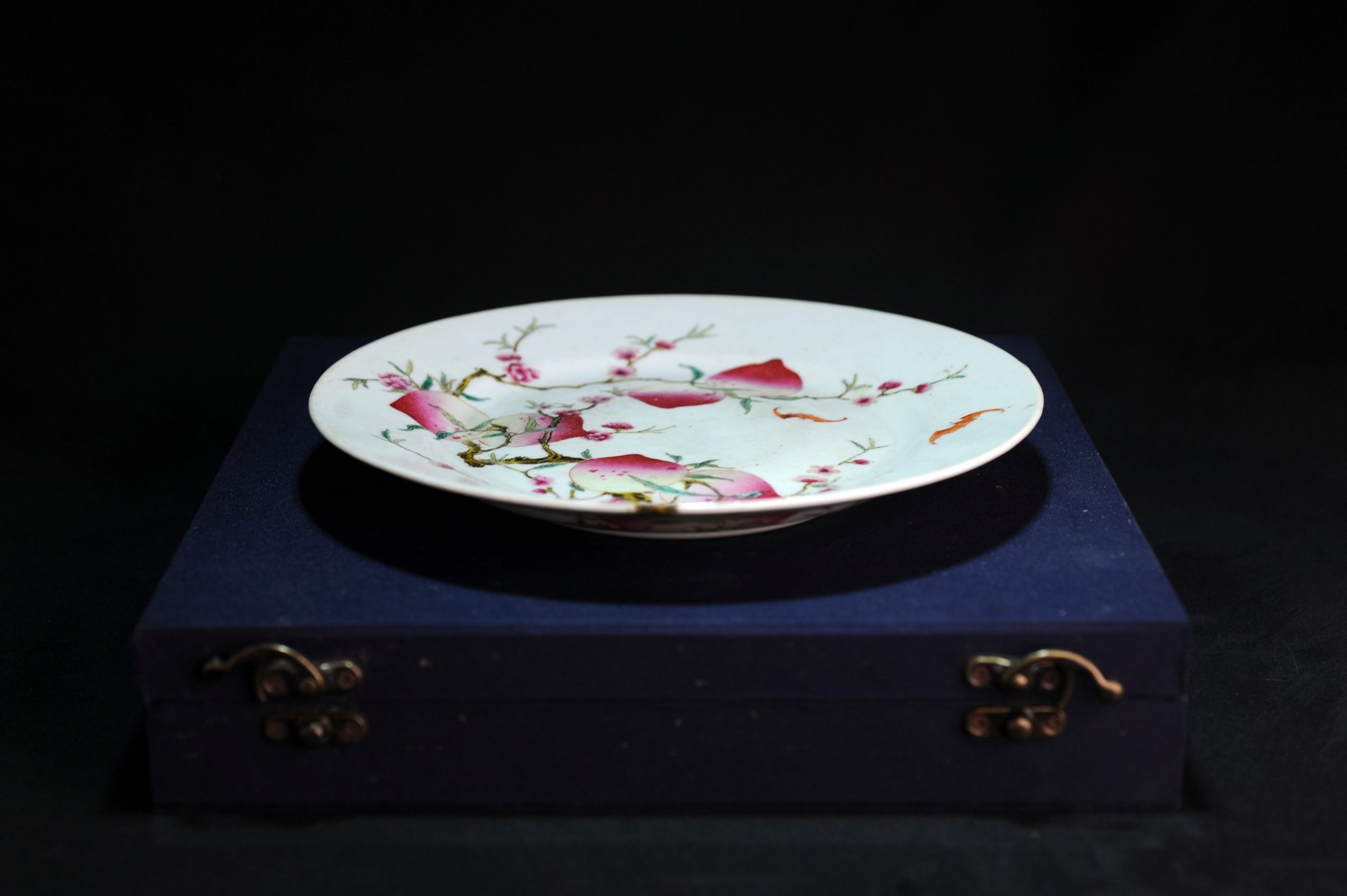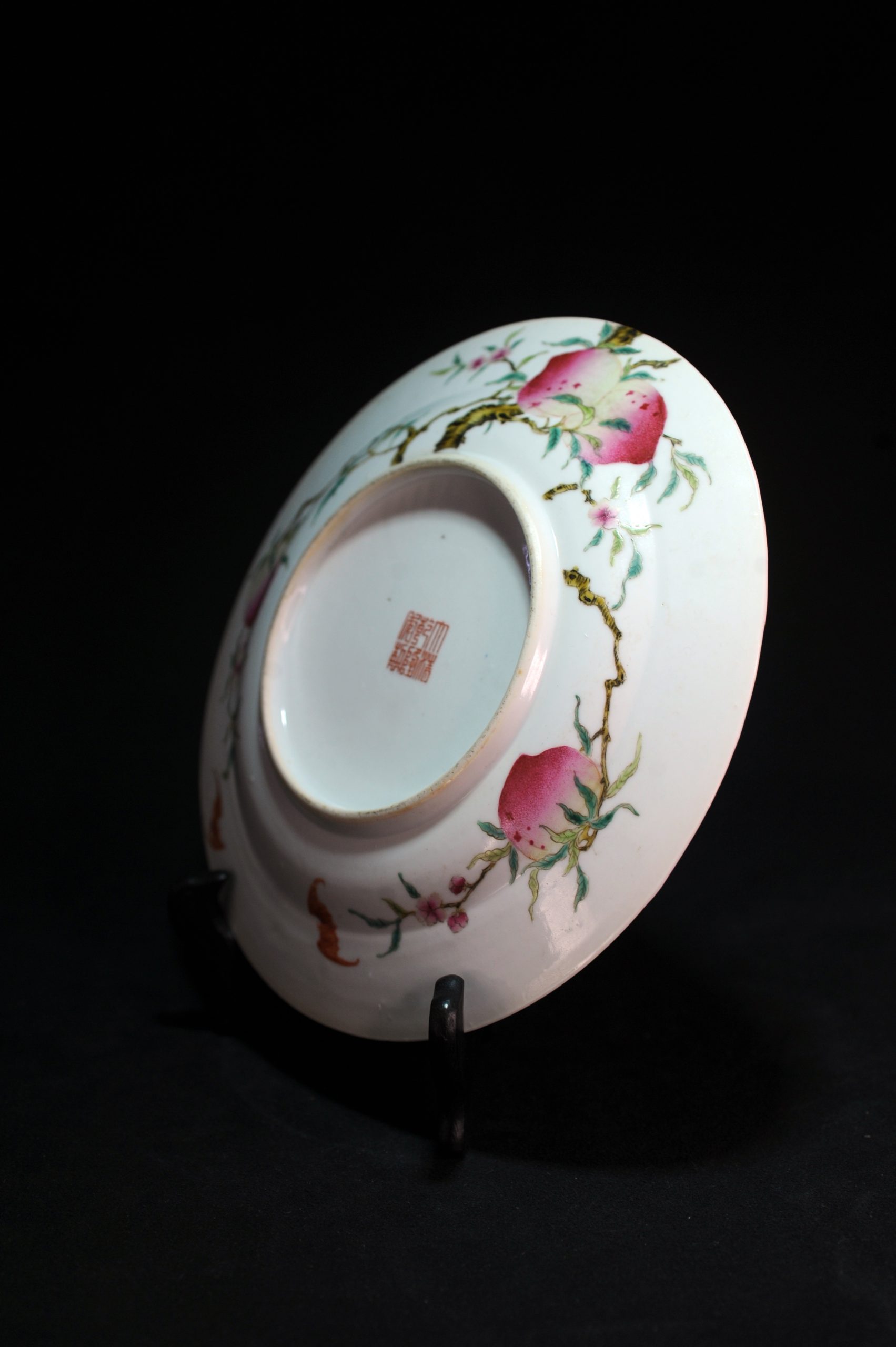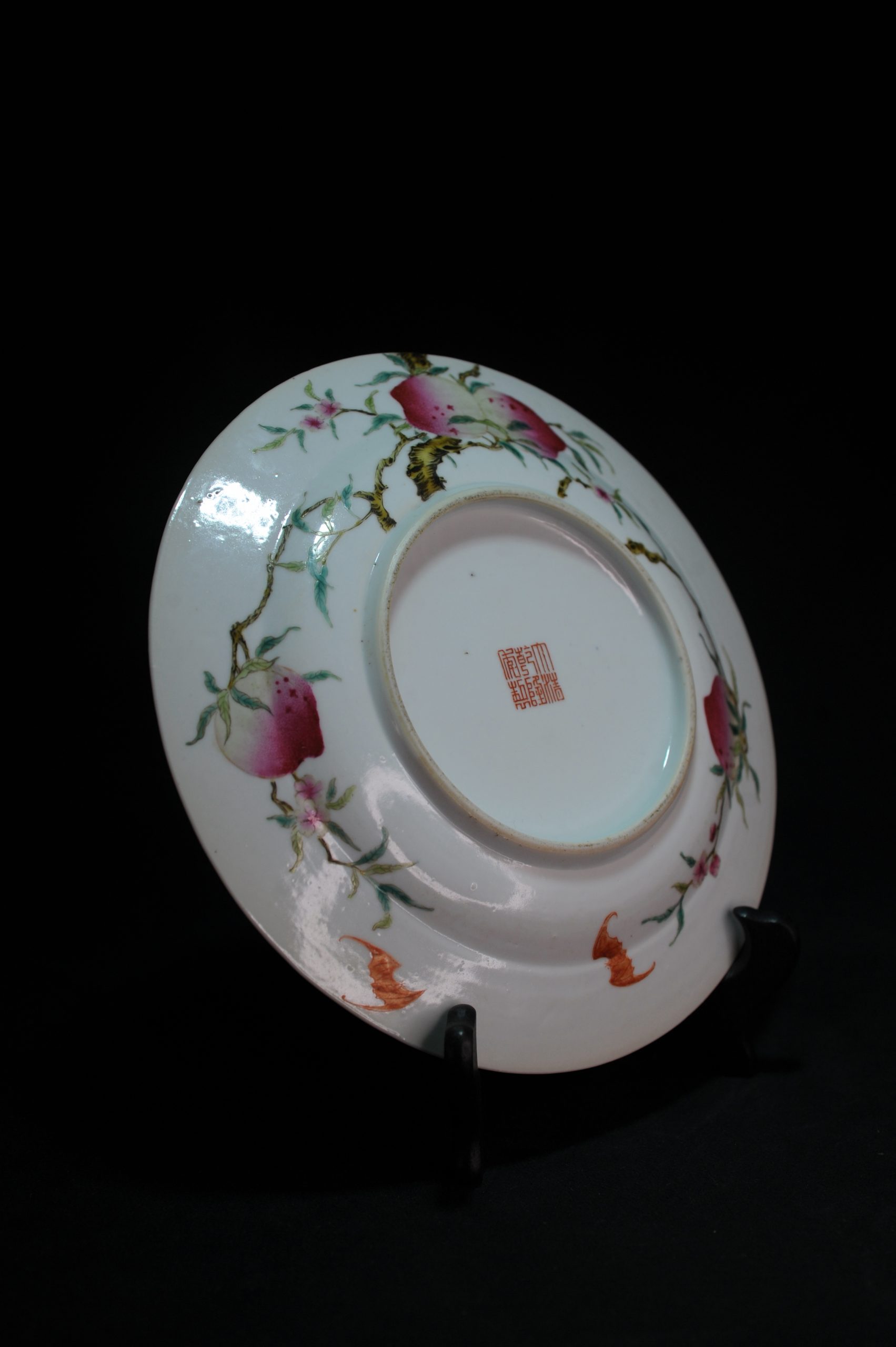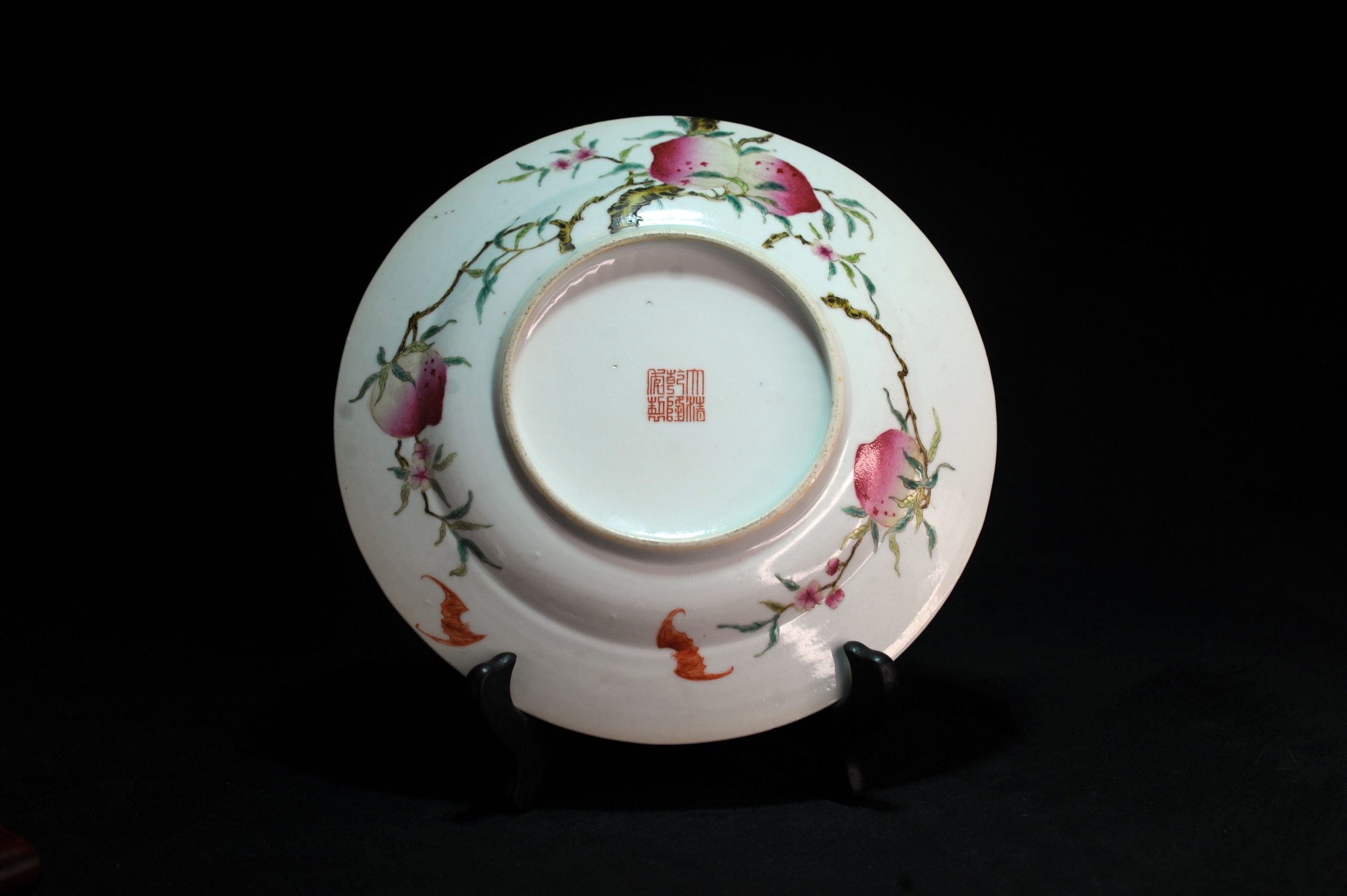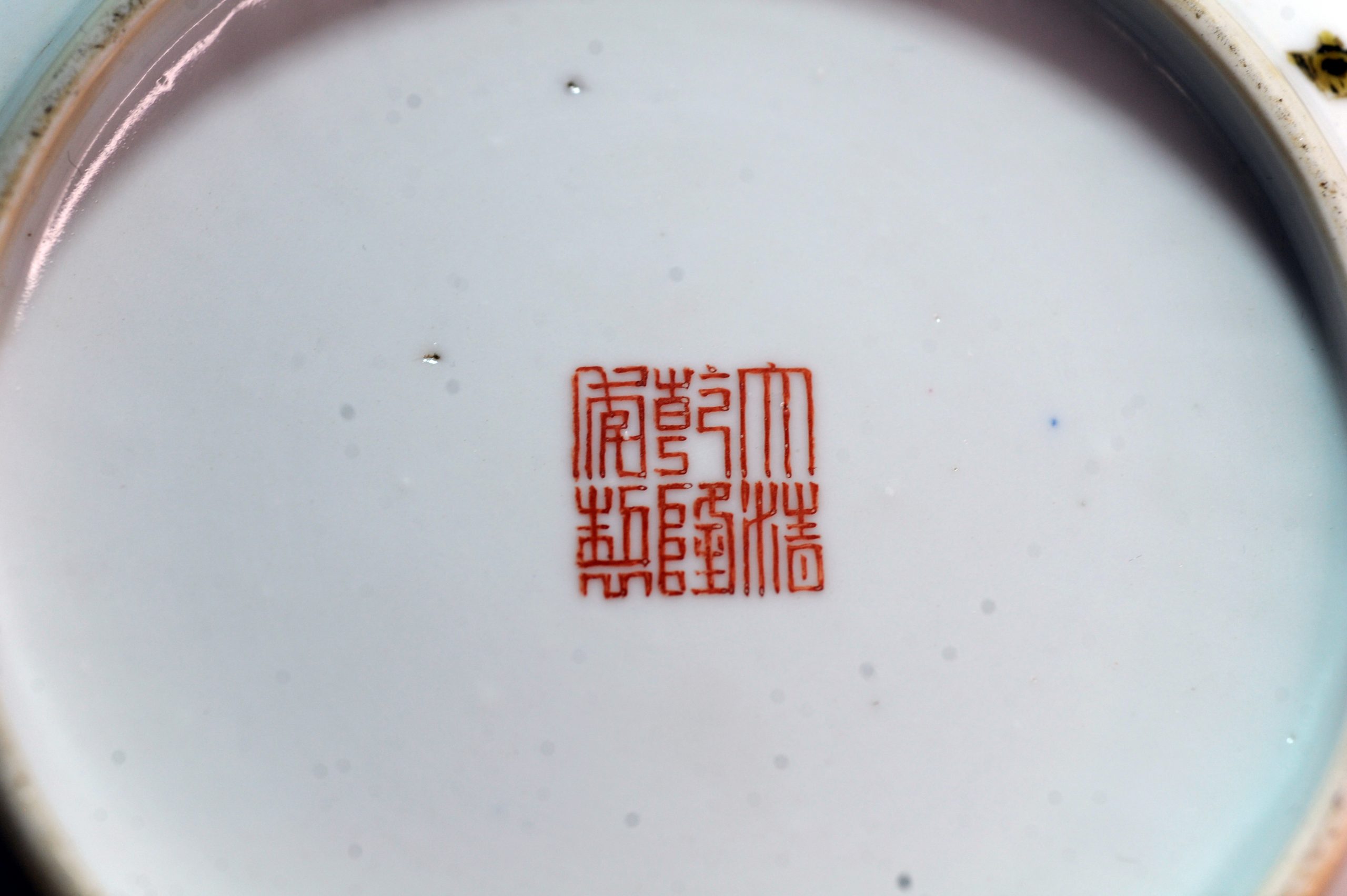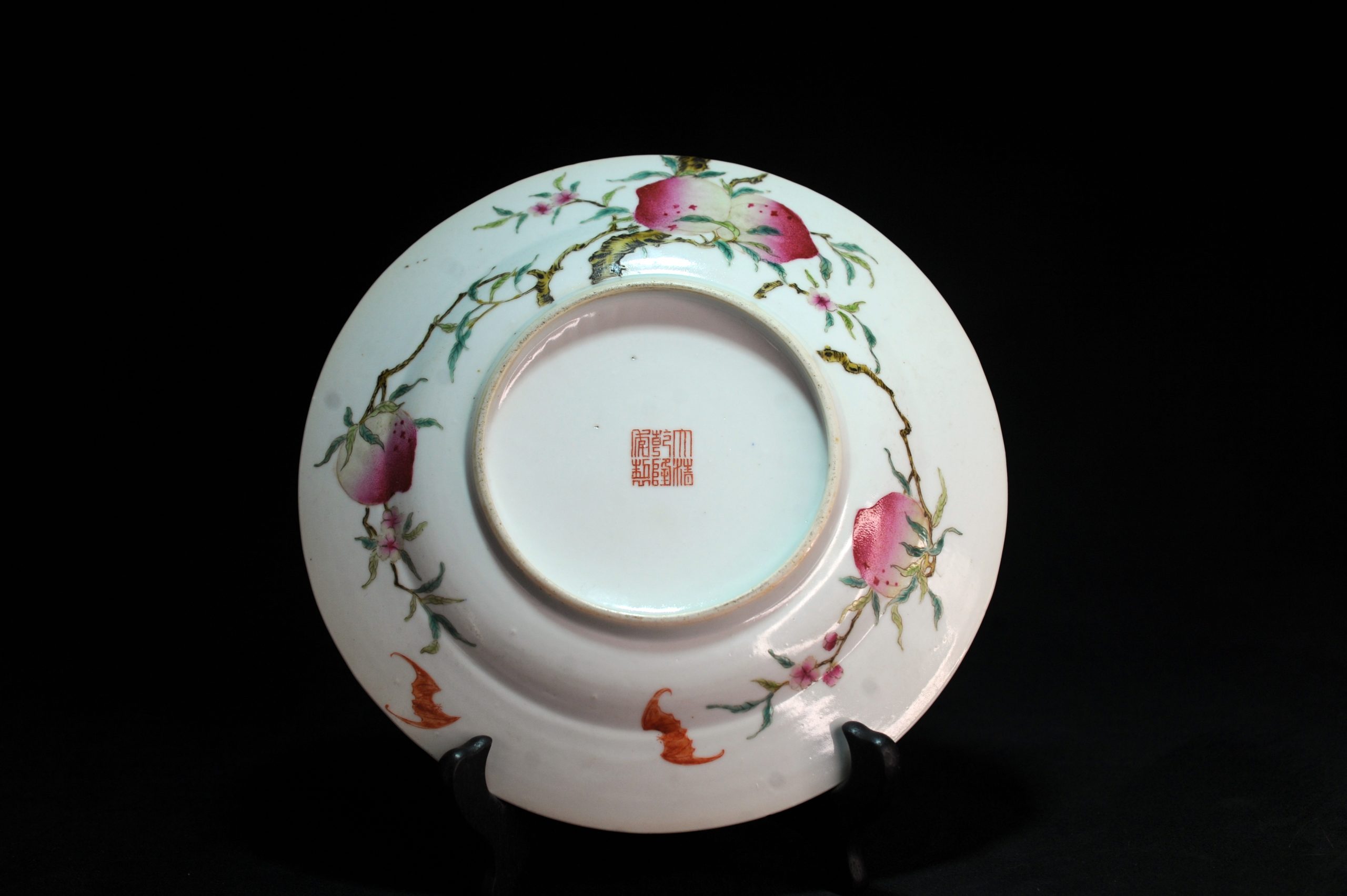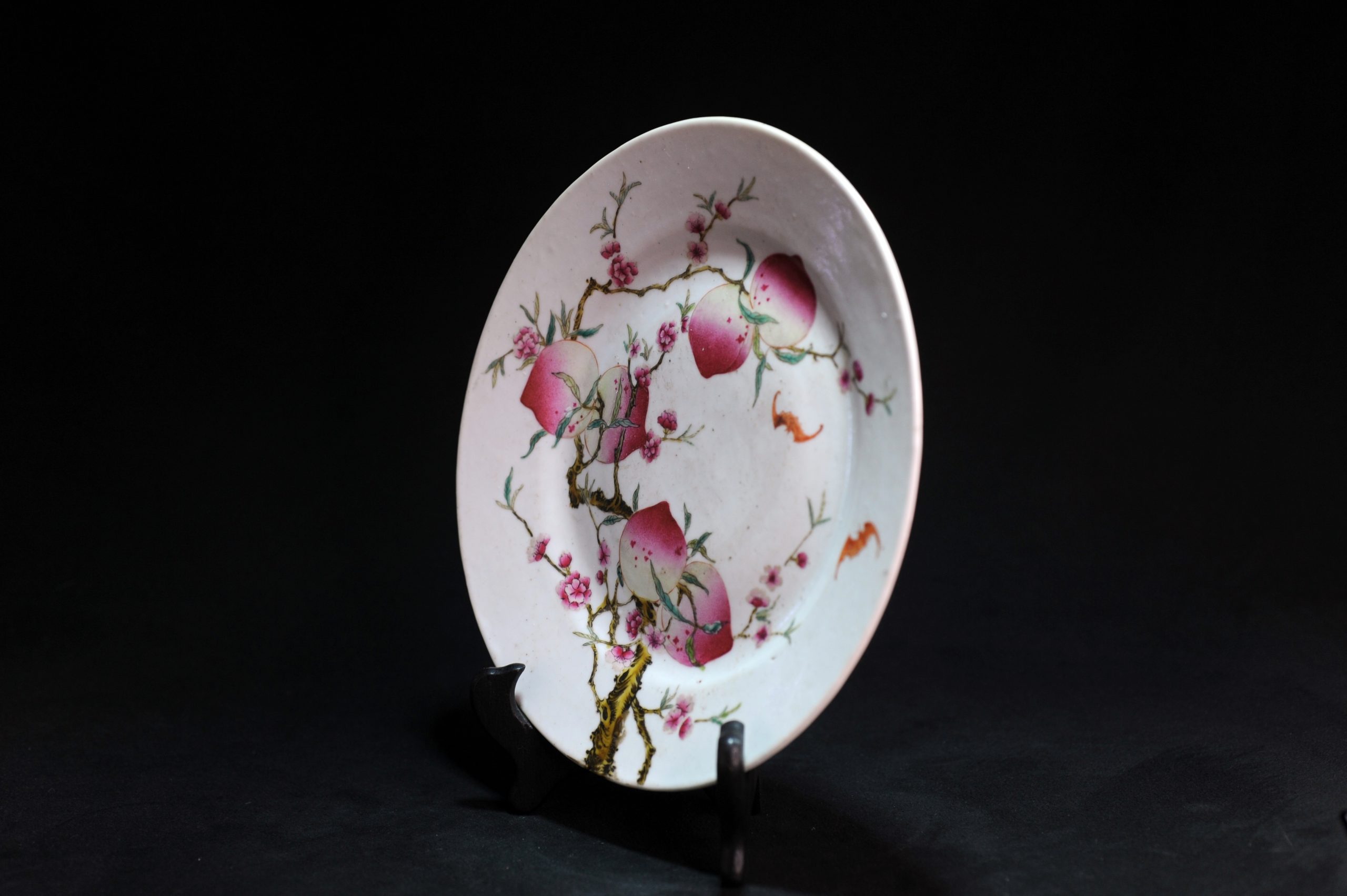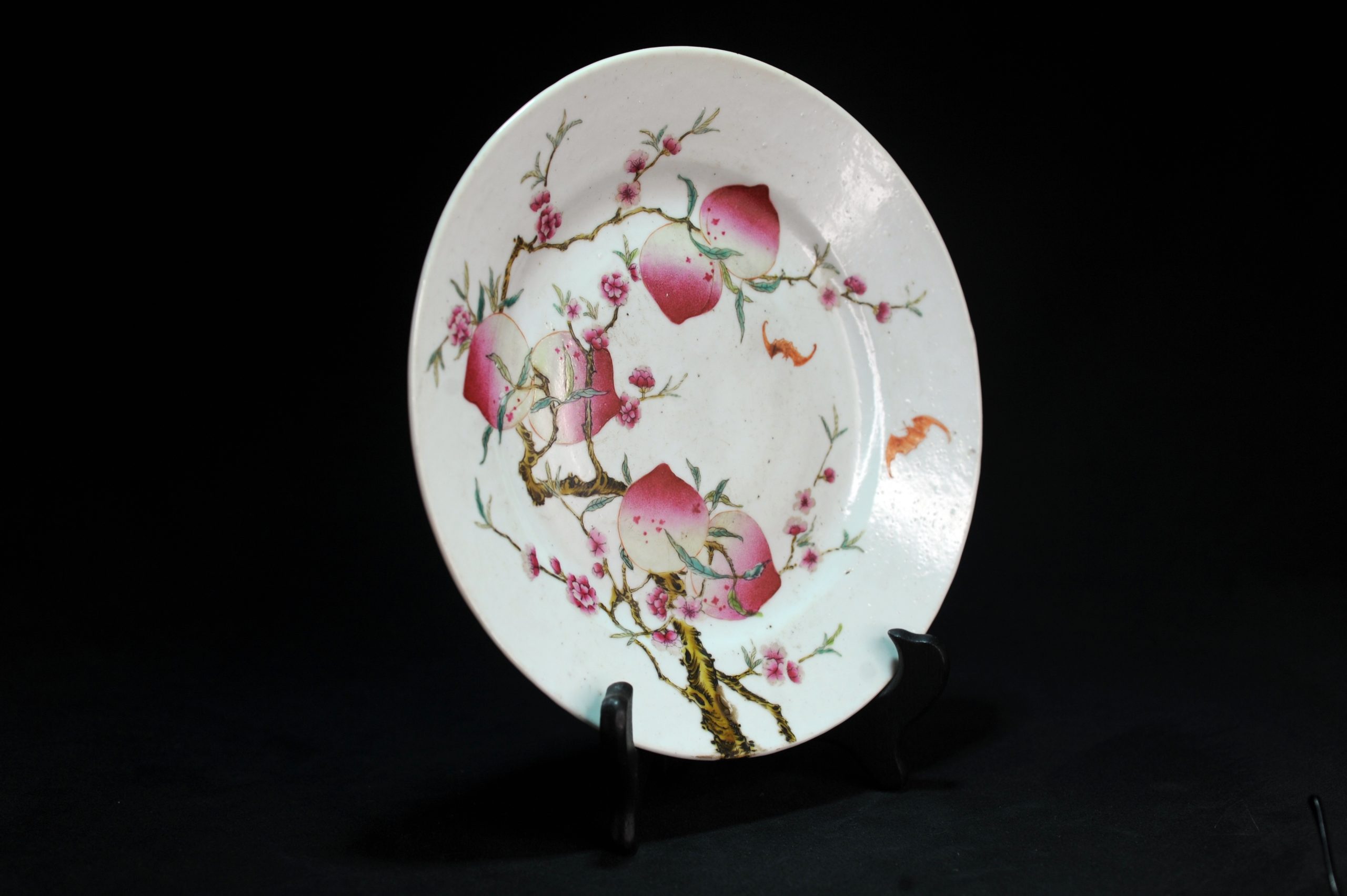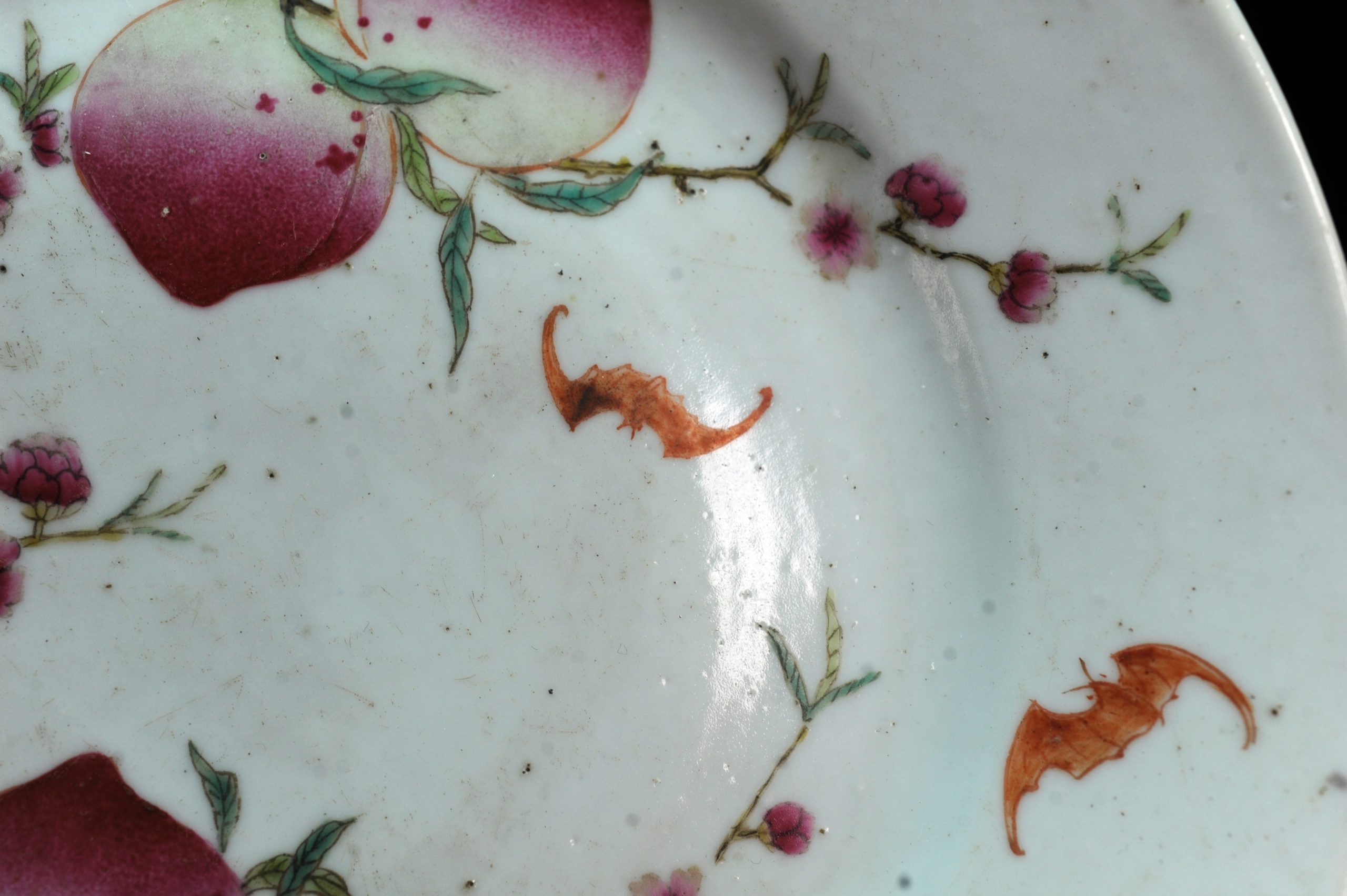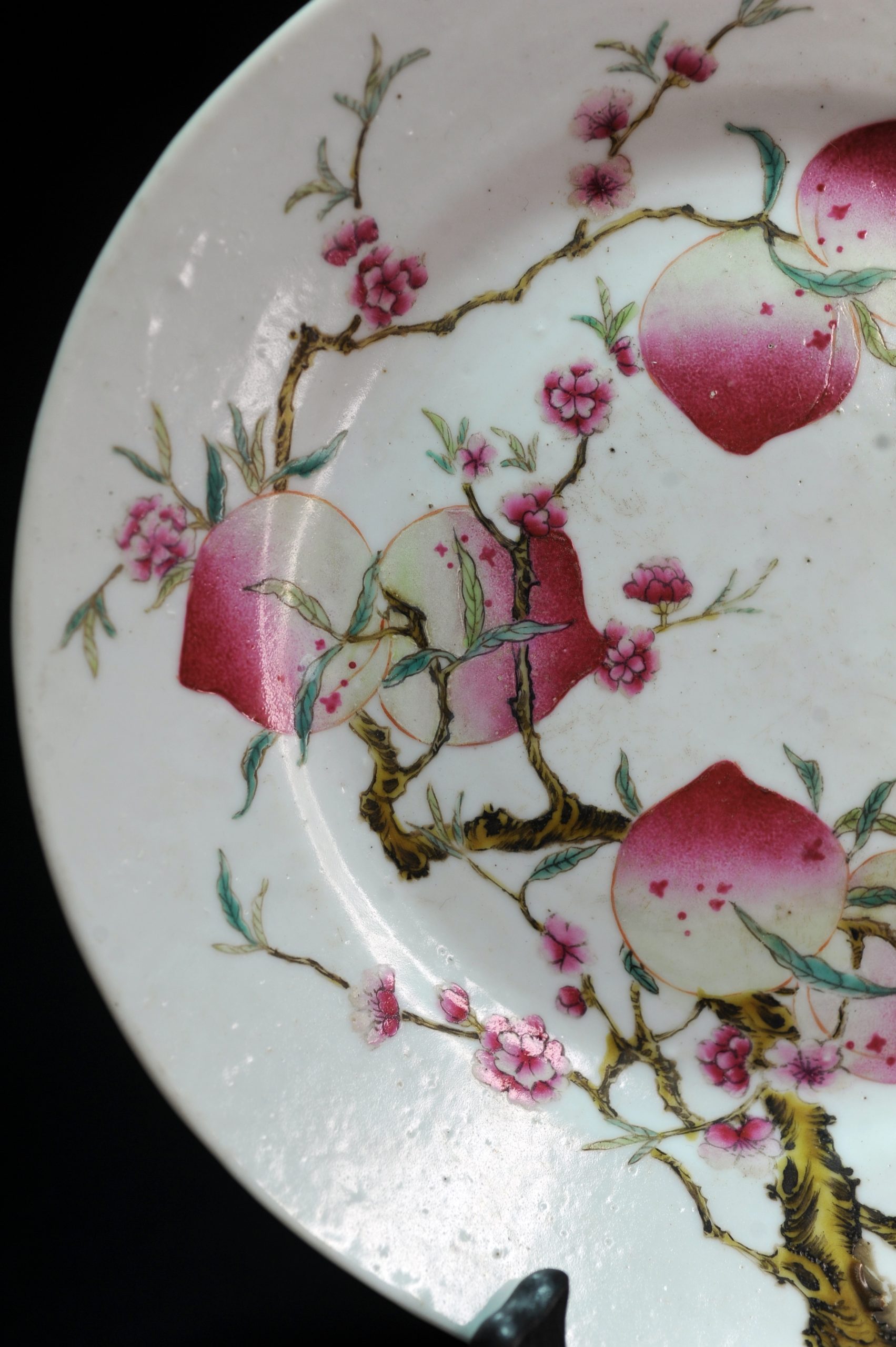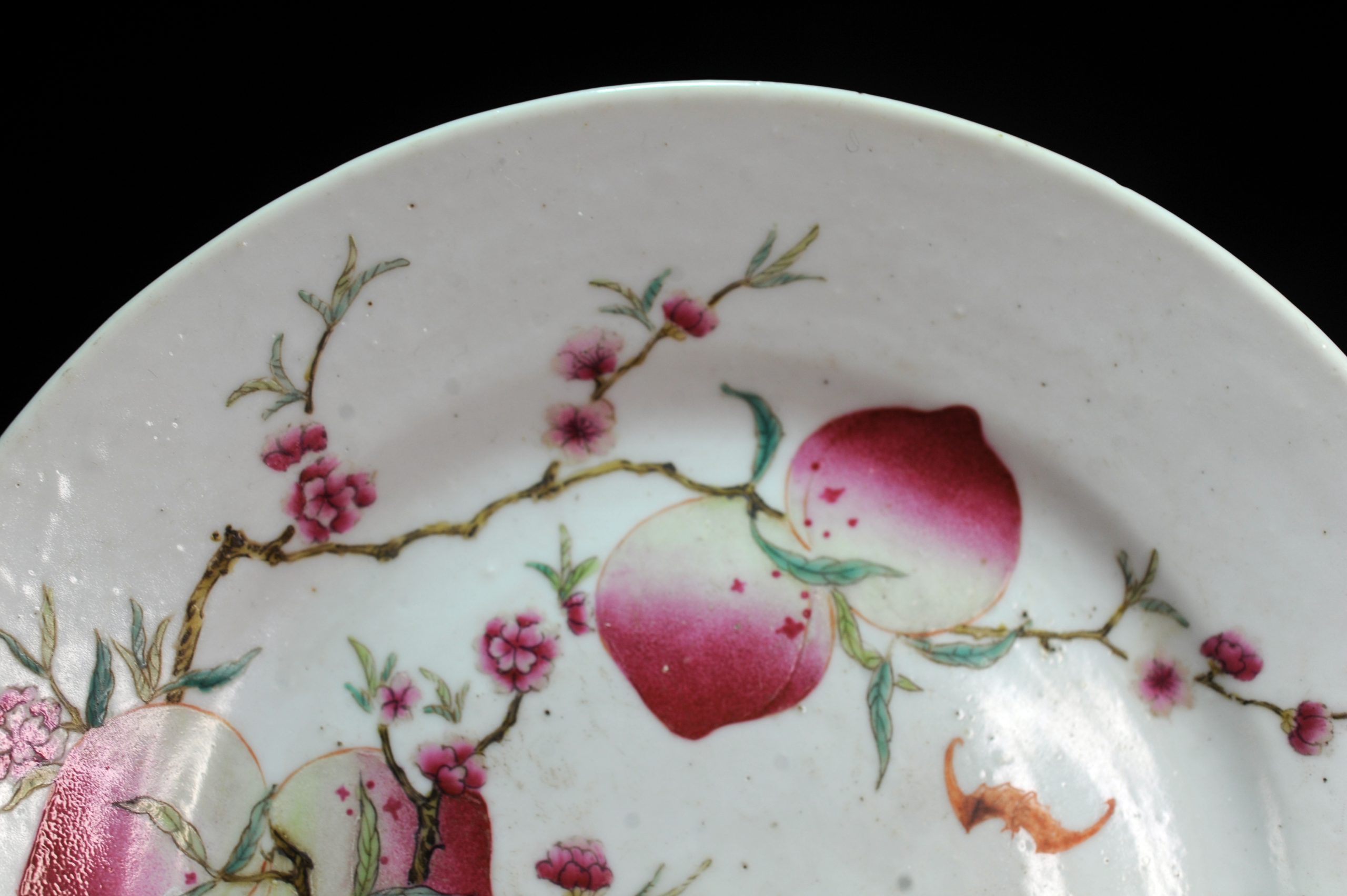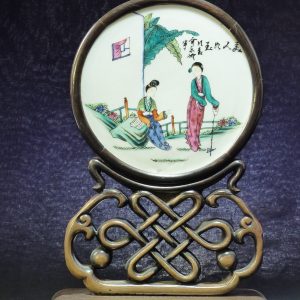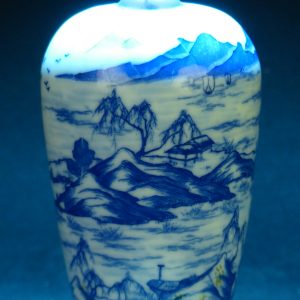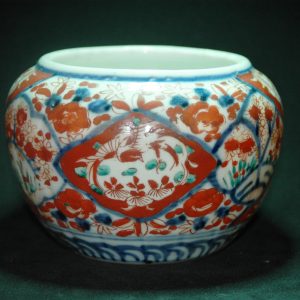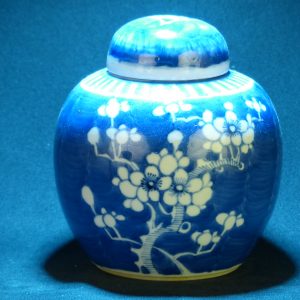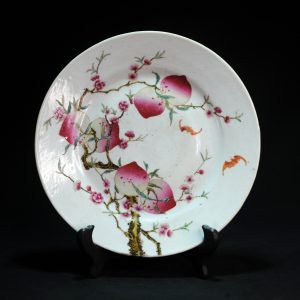Description
粉彩是康熙晚期出现,雍乾时期开始盛行的一种多色组合的釉上彩瓷器,其彩绘中的许多部分采用玻璃白打底,再以各种色彩渲染,使诸色带有以粉淡化的层次感,使画面分出层次,彩绘显得更有立体效果,在图案纹饰的绘画上,画工精细流利,具有纤细的柔态,且善于表现形象的质感,图案有阴阳向背的效果,主题突出。
参考:
蘇富比拍賣
Gems of Imperial Porcelain from the Private Collection of Joseph Lau
29 April 2022 • 10:10 HKT
3
An outstanding and finely enamelled famille-rose ‘peach’ charger Mark and period of Yongzheng
清雍正 粉彩過枝福壽雙全紋大盤 《大清雍正年製》款
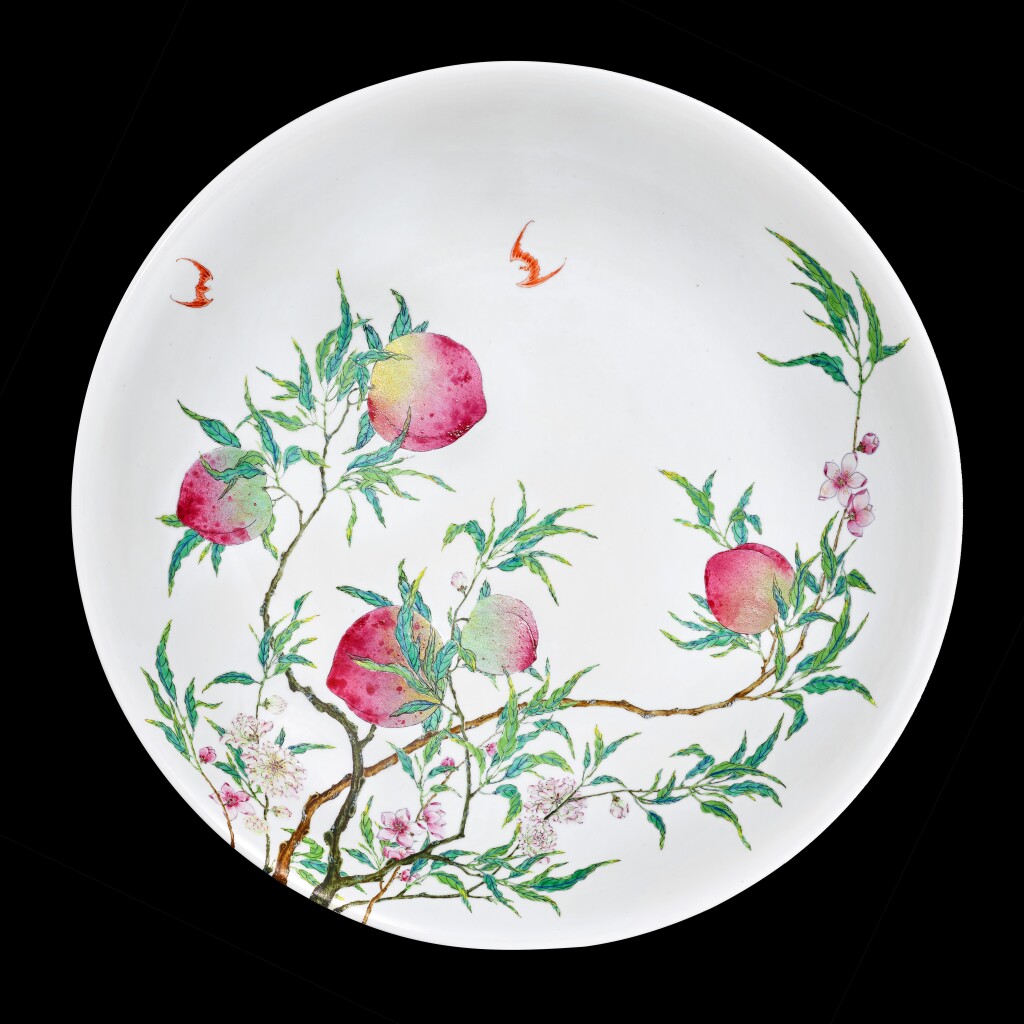
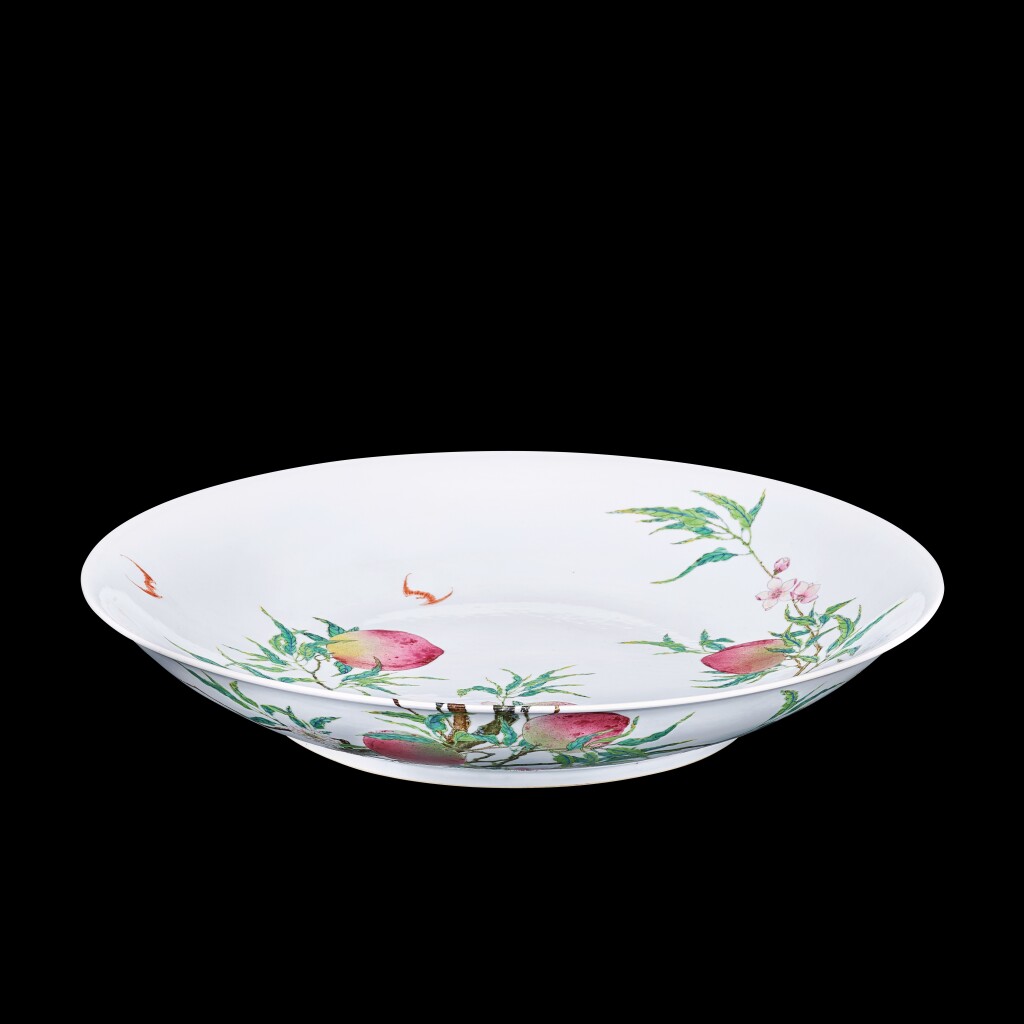
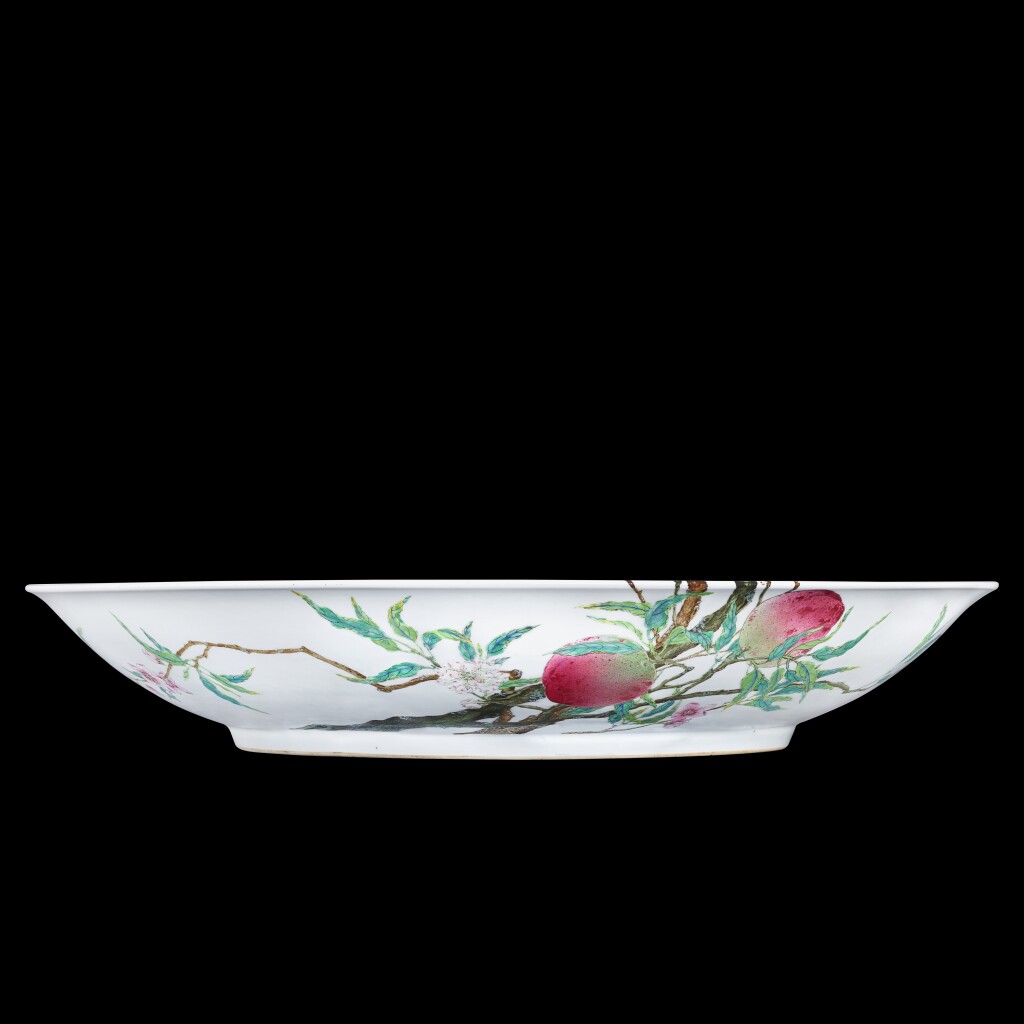
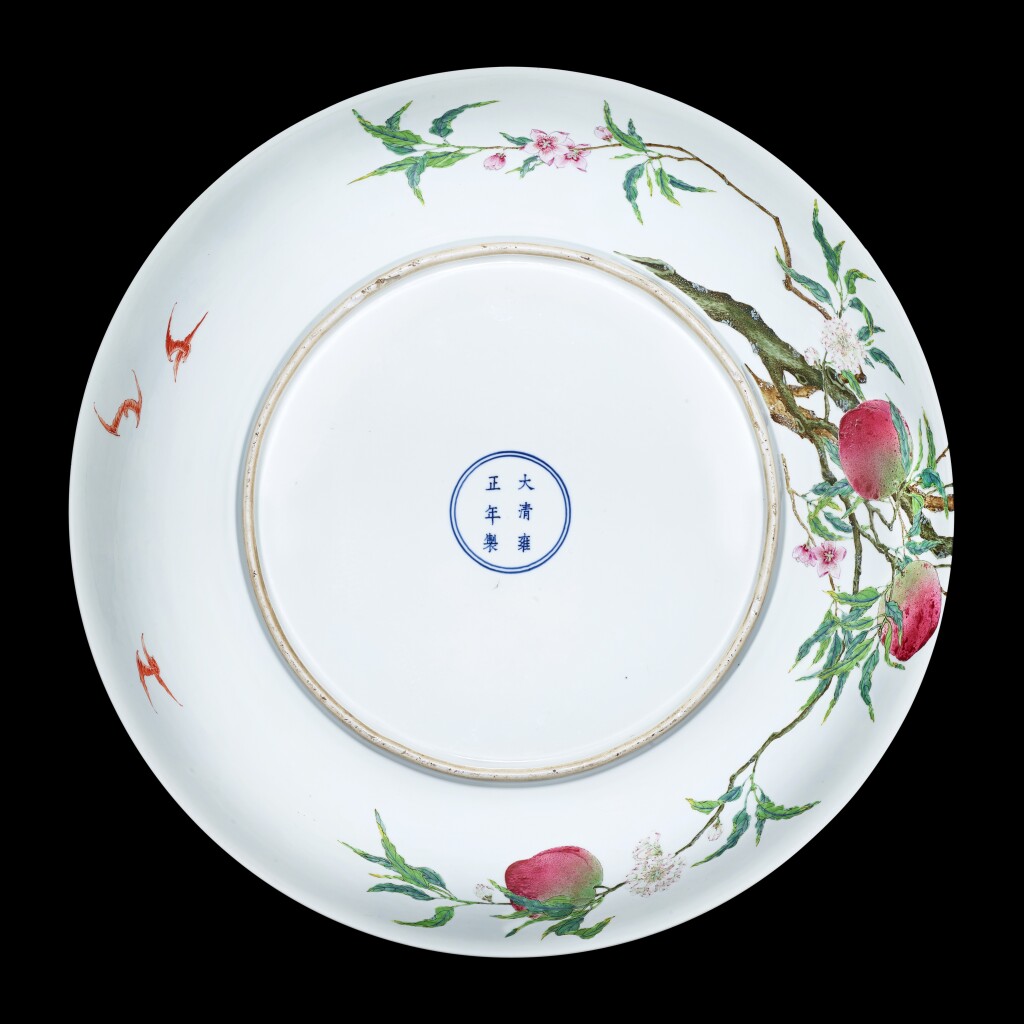
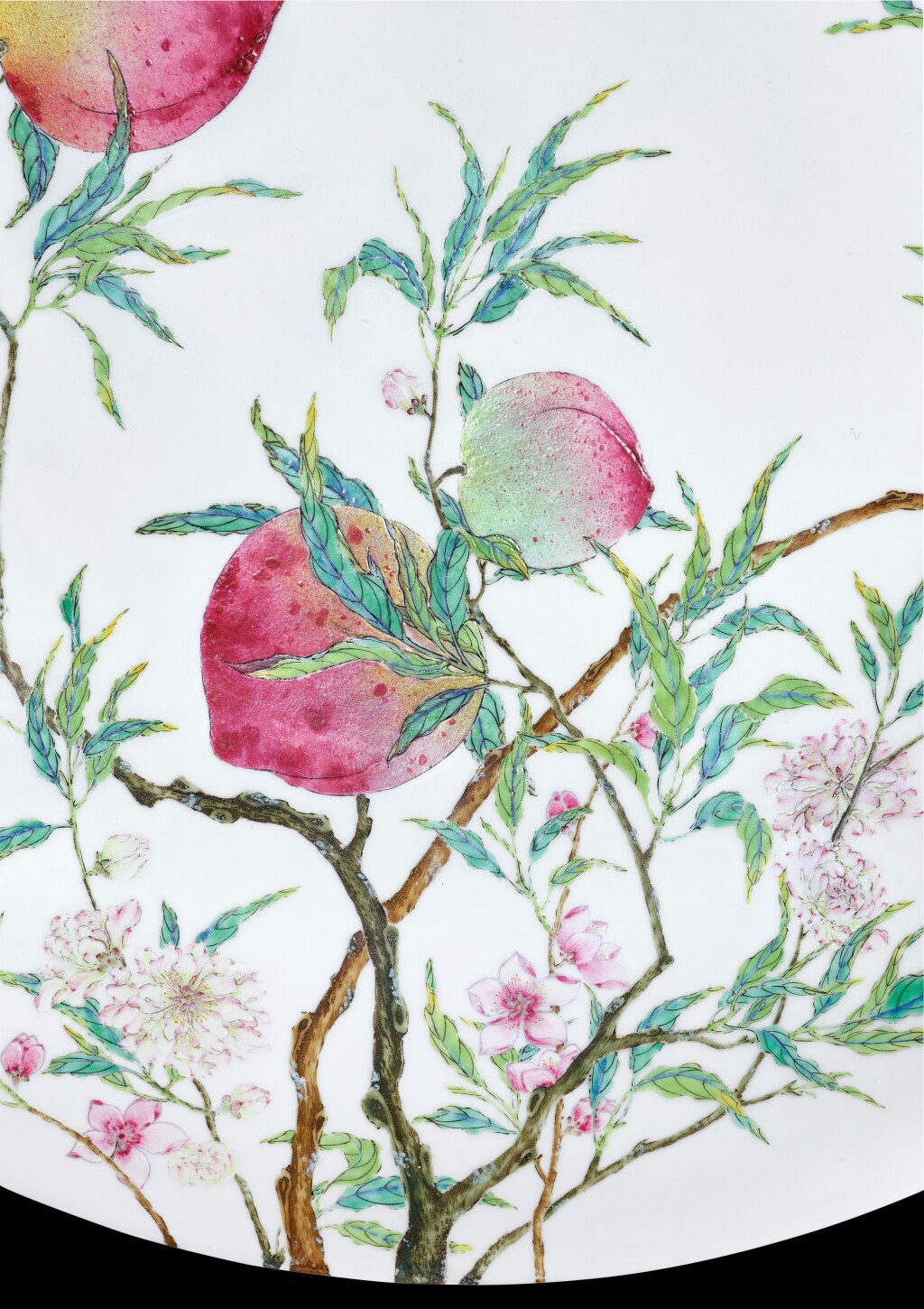
Premium Lots
估價:18,000,000 – 25,000,000 HKD
An outstanding and finely enamelled famille-rose ‘peach’ charger
Mark and period of Yongzheng
清雍正 粉彩過枝福壽雙全紋大盤 《大清雍正年製》款
superbly decorated with two fruiting and flowering peach boughs, naturalistically depicted side by side and crossing over, each rendered rising from the footrim, with thinner branches extending halfway across the exterior, and continuing over the rim and on to the interior, one branch painted in pale olive-green with shades of grey and the other a finely shaded tan colour, the slender leaves curled over at the ends and softly enamelled in variegated tones of green with touches of blue and yellow, each of the eight peaches, five on the interior and three on the exterior, portrayed in various sizes depicting different stages of ripening, the rich mottled rose enamels accentuated with pale green and lemon-yellow, the blossoms and buds picked out in white, rose and yellow, further decorated with with five iron-red bats, two on the interior and three on the exterior, the base inscribed in underglaze blue with a six-character reign mark within a double circle
51 cm
狀況報告
The charger is in excellent condition. There is an insignificant rim flake that likely resulted from the firing and occasional minute enamel flakes to several green leaves and one pink petal, which have been lightly retouched, all barely visible to the naked eye.
品相完好。口沿一處應為窰燒原生細小剝片經修復。綠葉幾處及粉色花瓣一處細小剝釉經潤飾,均不顯眼。
來源
Collection of Baron Iwasaki, c. 1900.
Collection of Barbara Hutton (1912-1979), c. 1950.
The Tsui Museum of Art, Hong Kong.
Sotheby’s Hong Kong, 29th November 1976, lot 618.
Sotheby’s Hong Kong, 9th November 1982, lot 303.
Sotheby’s Hong Kong, 29th October 1991, lot 258.
岩崎男爵收藏,約1900年
芭芭拉.赫頓(1912-1979年)收藏,約1950年
徐氏藝術館,香港
香港蘇富比1976年11月29日,編號618
香港蘇富比1982年11月9日,編號303
香港蘇富比1991年10月29日,編號258
出版
A Collection of One Hundred and Fifty Seven Watercolour Illustrations of Japanese and Chinese Porcelain and Pottery, commissioned by Captain F. Brinkley, c. 1900, pl. XX (fig. 1).
The Tsui Museum of Art, Hong Kong, 1991, pl. 118.
Sotheby’s Hong Kong – Twenty Years, 1973-1993, Hong Kong, 1993, pl. 273.
The Tsui Museum of Art. Chinese Ceramics IV: Qing Dynasty, Hong Kong, 1995, pl. 154.
《A Collection of One Hundred and Fifty Seven Watercolour Illustrations of Japanese and Chinese Porcelain and Pottery》,F. Brinkley 上尉委託出版,約1900年,圖版XX(圖一)
《徐氏藝術館》,香港,1991年,圖版118
《香港蘇富比二十週年》,香港,1993年,圖版273
《徐氏藝術館:陶瓷IV》,香港,1995年,編號154
展覽
The Barbara Hutton Collection of Chinese Porcelain, The Honolulu Academy of Arts, Honolulu, 1956-1957, pl. XVI.
《The Barbara Hutton Collection of Chinese Porcelain》,檀香山藝術學院,檀香山,1956-1957年,圖版XVI
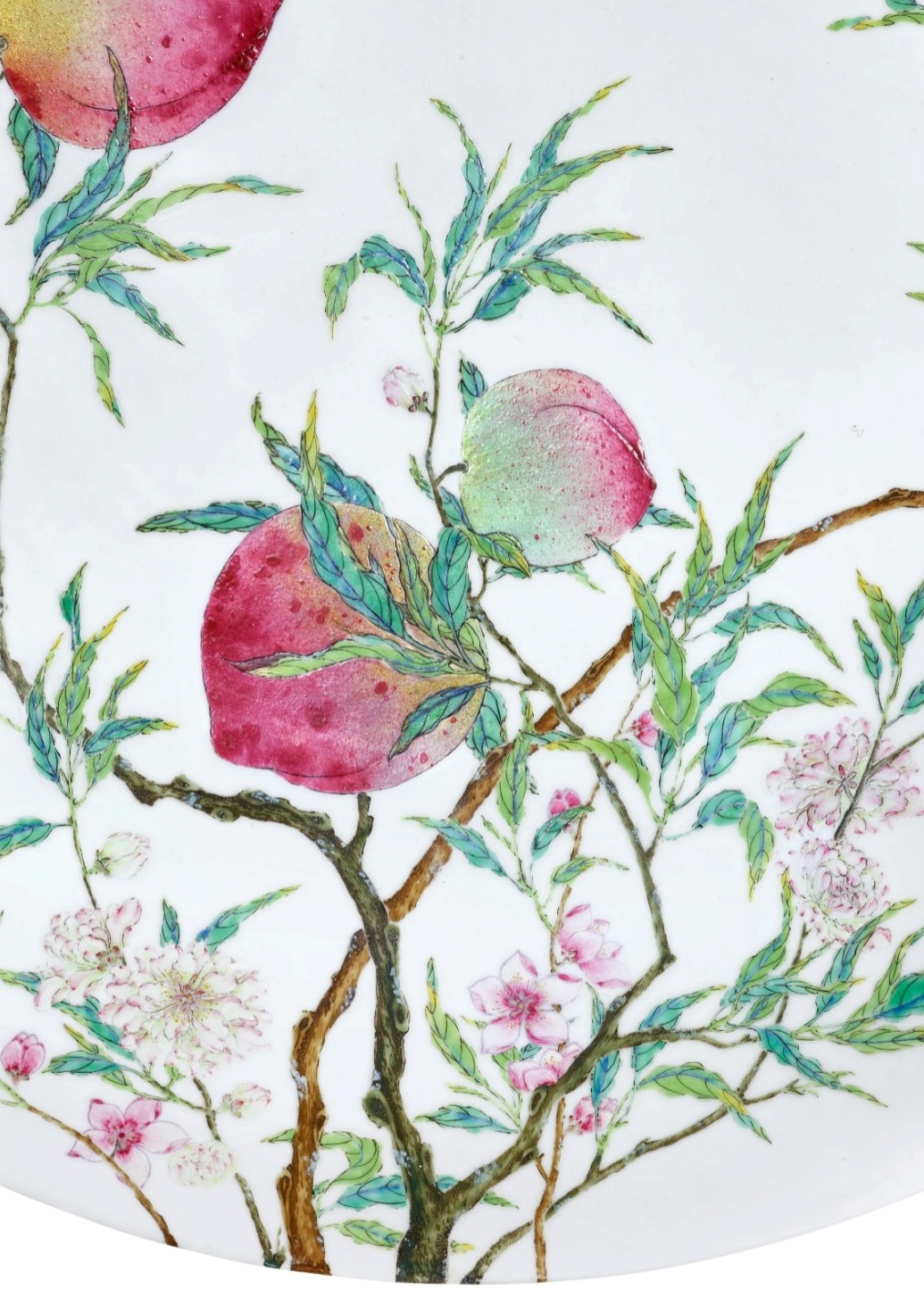
相關資料
Catalogue Note
This immensely elegant and massive charger with its brilliant fencai (famille rose) palette represents the pinnacle of the aesthetic achievement at the imperial kilns during the Yongzheng reign (1723-35). Although fruiting peach branches can be found on a fine and small group of large dishes from the period, they are all individually rendered, and the execution and layout of the design varies considerably from piece to piece. The present charger is exceptional in the depiction of its fruits, whose different stages of ripening are rarely represented in such variety on a single dish. From still partly unripe ones, mostly in garden-fresh green, to fully mature pieces with deep pink spots that seem ready to eat, the skin of the eight peaches was masterfully varied in a range of gradations of shaded pink, yellow and pale green enamels, setting this dish apart from others.
With the pastel shades of rose-pink, lemon-yellow and pale green, the soft colouration of fruiting and flowering peach branches was particularly well suited to show off the new fencai palette, which had just been introduced to Jingdezhen by the end of the Kangxi reign (1662-1722). During the Yongzheng period, the techniques of using this new repertoire of colours were perfected in the imperial kilns, so that painters could begin to depict nature scenes in naturalistic colours. This dish is one of the famous examples, where the Yongzheng painters created a continuous painting of branches starting on the outside, at the foot of the dish, and continuing over the rim onto the inside, in China called guozhi, (‘overshooting branches’). The distribution of the complete painting with eight fruits and five bats over the circular space inside and the horizontal space outside, required very special planning of the complicated layout. The design is further remarkable for the complex interlacing of two different peach varieties, one with single pink blossoms and brown bark, the other with double white blossoms and a nearly black bark. According to Taoya / The Elegance of Porcelain written by the late Qing (1644-1911) author Ji Yuansou, Yongzheng dishes and bowls decorated with eight peaches on overshooting branches were highly prized even well into the Qing dynasty.
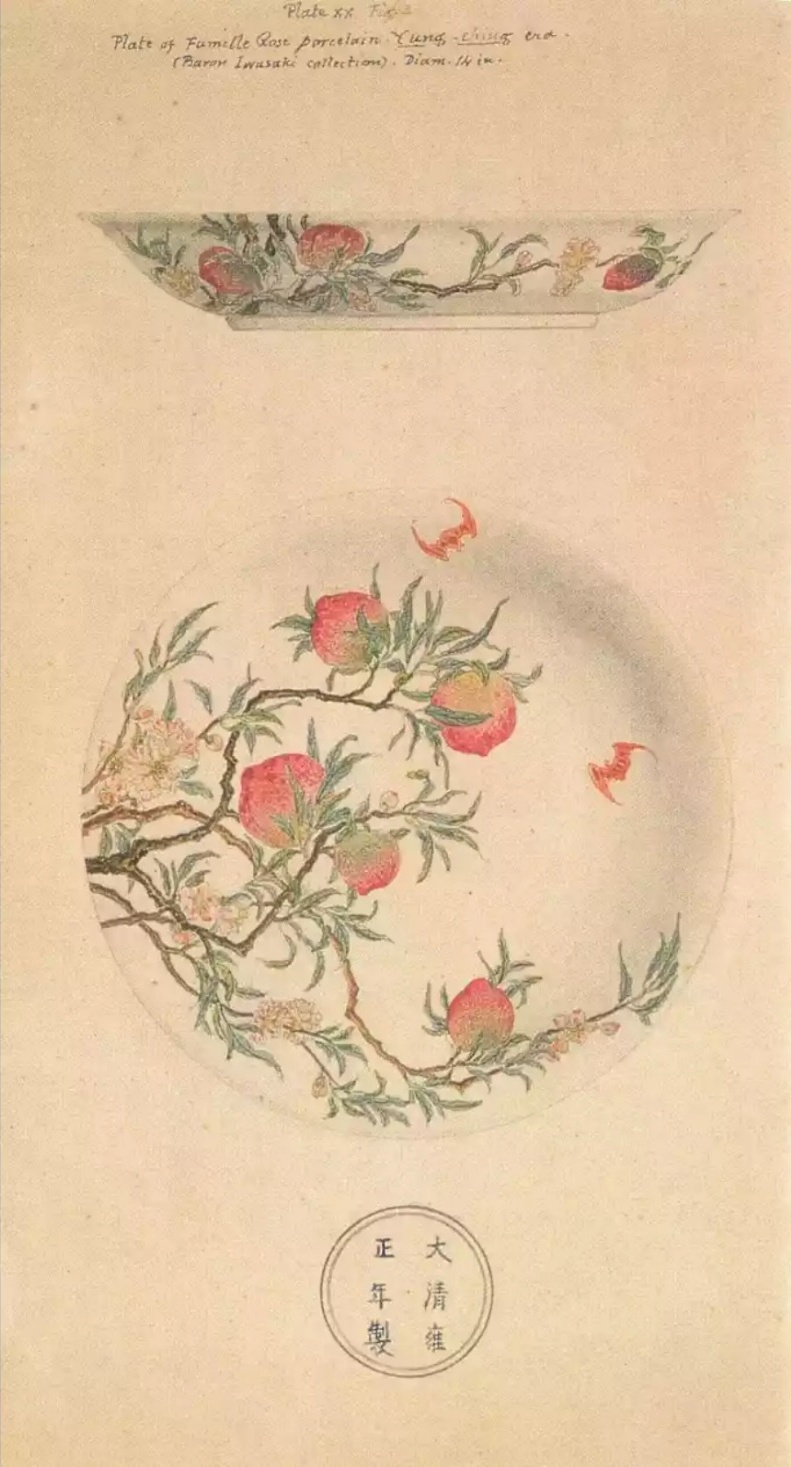
A COLLECTION OF ONE HUNDRED AND FIFTY SEVEN WATERCOLOUR ILLUSTRATIONS OF JAPANESE AND CHINESE PORCELAIN AND POTTERY, COMMISSIONED BY CAPTAIN F. BRINKLEY, C. 1900, PL. XX.
圖一
《A COLLECTION OF ONE HUNDRED AND FIFTY SEVEN WATER-COLOUR ILLUSTRATIONS OF JAPANESE AND CHINESE PORCELAIN AND POTTERY》,F. BRINKLEY 上尉委託出版,約1900年,圖版XX
Peaches, as an auspicious symbol, have a long history of being associated with longevity and immortality. The eight peaches on this dish would have stood for the Eight Immortals who bestow long life. The red colour of the bats, on the other hand, provide a visual pun for vast good fortune, limitless as the sky (hong fu qi tian), and their number of five offers a rebus for the Five Blessings (wu fu) of longevity, health, wealth, love of virtue and a good end to life. Together the five bats and eight peaches symbolise blessings and longevity, visualising the Chinese saying fu shou shuang quan. Rich in its auspicious symbolism, similar designs continued to be appreciated and produced in later reigns, including Qianlong (1736-95) and Guangxu (1875-1908), albeit no longer of such exceptional painterly quality and on vessels of such monumental size.
Three chargers are decorated in a related fashion to the present piece, all with two bats on the interior: one painted with leafy branches like this charger, from the Sir Percival David Collection and now in the British Museum, London (accession no. PDF,A.840), illustrated in Rosemary E. Scott, For the Imperial Court – Qing Porcelain from the Percival David Foundation of Chinese Art, New York, 1997, pl. 48; another with peaches arranged in similar positions as the present lot, but of slightly larger size, measuring 57.6cm in diameter, illustrated in Sekai tōji zenshū/ Catalogue of World’s Ceramics, vol. 12: China: Ch’ing Dynasty and Annamese and Thai Ceramics, Tokyo, 1956, pl. 72; and the third one also with much foliage and similarly placed peaches, sold in these rooms, 2nd May 1995, lot 153 and again at Christie’s Hong Kong, 26th April 1999, lot 541.
See a few other similar large dishes, but with relatively less leafy branches and different composition of the peaches, as well as three bats on the inside and two on the outside: one preserved in the Victoria and Albert Museum, London (accession no. 719-1907), included in Reino Liefkes and Hilary Young eds., Masterpieces of World Ceramics in the Victoria and Albert Museum, London, 2008, p. 93; another one, formerly in the collections of Allen J. Mercher and Winston Guest, sold at Parke-Bernet Galleries, New York, 9th October 1957, lot 114 and again in our New York rooms, 2nd December 1967, lot 11, illustrated in Mayuyama, Seventy Years, vol. 1, Tokyo, 1976, p. 353, no. 1059; a further piece, formerly in the collections of J. Pierpont Morgan and Frederick J. and Antoinette H. van Slyke, exhibited on loan at the Metropolitan Museum of Art, New York around 1910, listed in the Catalogue of the Morgan Collection of Chinese Porcelains, vol. 2, New York, 1911, p. 73, no. 1272, with a line drawing on p. 134, Case W, sold twice in our New York rooms, 2nd February 1944, lot 192 and 31st May 1989, lot 209, and again in these rooms, 29th April 1997, lot 400.
Although eight is the usual number of peaches depicted on Yongzheng chargers of this type, two pieces rendered with nine peaches have been published: one preserved in the Palace Museum, Beijing (accession no. gu-150245), illustrated in The Complete Collection of Treasures of the Palace Museum. Porcelains with Cloisonné Enamel Decoration and Famille Rose Decoration, Hong Kong, 1999, pl. 56; and another one, with three bats on the interior, sold at Christie’s Hong Kong, 29th April 2001, lot 546 and again in these rooms, 23rd October 2005, lot 434.
Baron Iwasaki Koyata (1879-1945), the fourth president of Mitsubishi, was the son of Iwasaki Yanosuke (1851-1908) who founded the Seikado Bunko. A notable collector himself, Koyata expanded the Seikado collection particularly in Chinese pottery and porcelains.
Barbara Hutton (1912-1979), heiress, collector and philanthropist, developed a taste in Oriental art and travelled to China in 1934. An exhibition of Chinese porcelains from her collection was held at the Honolulu Academy of Arts in 1956-7.
粉彩福壽雙全紋大盤,清麗秀雅,尺寸碩大,粉彩色調清新亮麗,展現雍正御窰之審美極致。纍纍桃實,滿綴枝頭,福壽雙全紋僅見於少數雍窰大盤,品質精湛。本品紋飾構圖、配色均細膩描繪,桃實設色各不相同,紅潤欲滴,綴艷紅熟斑、或嬌黃粉紅、或粉青帶紅,巧妙運用不同深淺之粉紅、黃、綠彩摹寫桃枝自然樣態,與他例相較,更顯精妙細緻。
粉彩瓷創燒於康熙晚期景德鎮御窰廠,福壽雙全紋桃蕊、桃實之粉紅、檸檬黃、淺綠,色調柔和,尤能突顯粉彩瓷發展之新色。雍正窰研發運用各種新色,繪自然景致,靈動如真,即如本品,桃枝自盤底圈足處萌發,枝枒延展,越過盤緣,舒展於盤心,如此設計稱「過枝」。構圖巧妙佈局八桃五蝠於盤心、外壁,繁複而雅致,交錯二株相異品種桃樹,其一枝幹深褐,單瓣粉紅花蕊,另一為重瓣白花,桃枝深色近墨。據晚清寂園叟著《陶雅》,雍正過枝八桃紋盤盌,通清一代,已深得珍視,極為貴重。
桃紋寓意吉祥,祝意高壽無疆,本品繪八桃實,象徵八仙祝壽。紅色蝙蝠,音同「鴻福」,五蝙蝠紋則為「五福」,壽、富、康寧、好德、善終。紋飾結合五蝠、八桃,寄意福壽雙全。如此祥瑞之紋飾,沿用至後朝,如乾隆、光緒,但已無可相媲美之品質與尺寸。
參考另外三件大盤,構圖類同本品,盤心繪二蝠:其一為大維德基金會藏品(藏品編號:PDF,A.840),現貯於倫敦大英博物館,紋飾桃枝綠葉繁盛,與此盤相似,刊於柯玫瑰,《For the Imperial Court – Qing Porcelain from the Percival David Foundation of Chinese Art》,紐約,1997年,圖版48;另一之桃實佈局,與本品一致,尺寸更大,直徑 57.6 公分,錄於《世界陶磁全集.卷12:清朝編附安南.タイ》,東京,1956年,圖版72;第三例紋飾,桃葉更豐密,桃實佈局也相近,1995年5月2日售於香港蘇富比,編號153;1999年4月26日售於香港佳士得,編號541。
比較其他近類大盤,桃葉較稀疏,桃實佈局相異,內三紅蝠、外二蝠,如倫敦維多利亞與艾爾伯特博物館藏一例(藏品編號:719-1907),載於 Reino Liefkes 與 Hilary Young 編,《Masterpieces of World Ceramics in the Victoria and Albert Museum》,倫敦,2008年,頁93;另一例曾為 Allen J. Mercher、Winston Guest 遞藏,1957年10月9日售於紐約帕克.博內藝廊,編號114,後於1967年12月2日紐約蘇富比售出,編號11,刊於《龍泉集芳》,卷1,東京,1976年,頁353,編號1059;還有一盤,出自 J. Pierpont Morgan、Frederick J. 與 Antoinette H. van Slyke 珍藏,1910年曾借展於紐約大都會藝術博物館,載錄於《Catalogue of the Morgan Collection of Chinese Porcelains》,卷2,紐約,1911年,頁73,編號1272,並包含於頁134線描圖,曾二度售於紐約蘇富比,1944年2月2日,編號192,1989年5月31日,編號209,及香港蘇富比1997年4月29日,編號400。
、
雍窰粉彩福壽雙全紋大盤,雖多綴八桃實,著錄中亦有二件九桃之例,其一收藏於北京故宮博物院(藏品編號:故150245),出版於《故宮博物院藏文物珍品全集:琺瑯彩、粉彩》,香港,1999年,圖版56;另一例盤心繪三蝠,2001年4月29日售於香港佳士得,編號546,後於2005年10月23日售於香港蘇富比,編號434。
岩崎小彌太男爵(1879-1945年),為三菱集團第四代總帥,其父岩崎彌之助創設靜嘉堂文庫。岩崎為盛名遠播之鑑藏家,為靜嘉堂擴充許多中國陶瓷藏品。
芭芭拉.赫頓(1912-1979年)為知名慈善家與藝術收藏家,1934年曾至中國遊歷,喜愛收藏東方藝術。1956至57年間,曾於檀香山藝術學院舉辦中國瓷器珍藏展。
参考:佳士得
25 6月 2021 | 網上拍賣 20379
亞洲藝術
拍品 347
歐洲私人珍藏
二十世紀 粉彩過枝福壽雙全大盤
CHINE, XXEME SIECLE
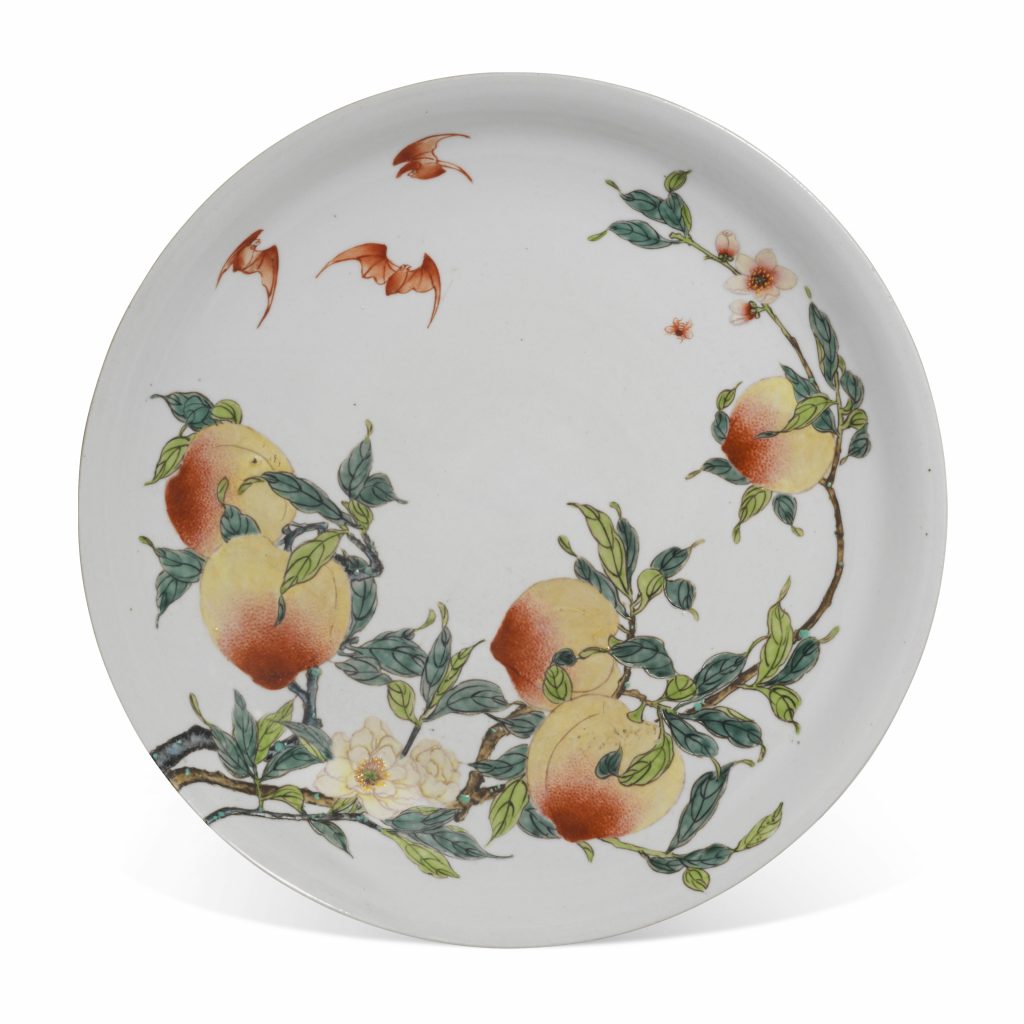
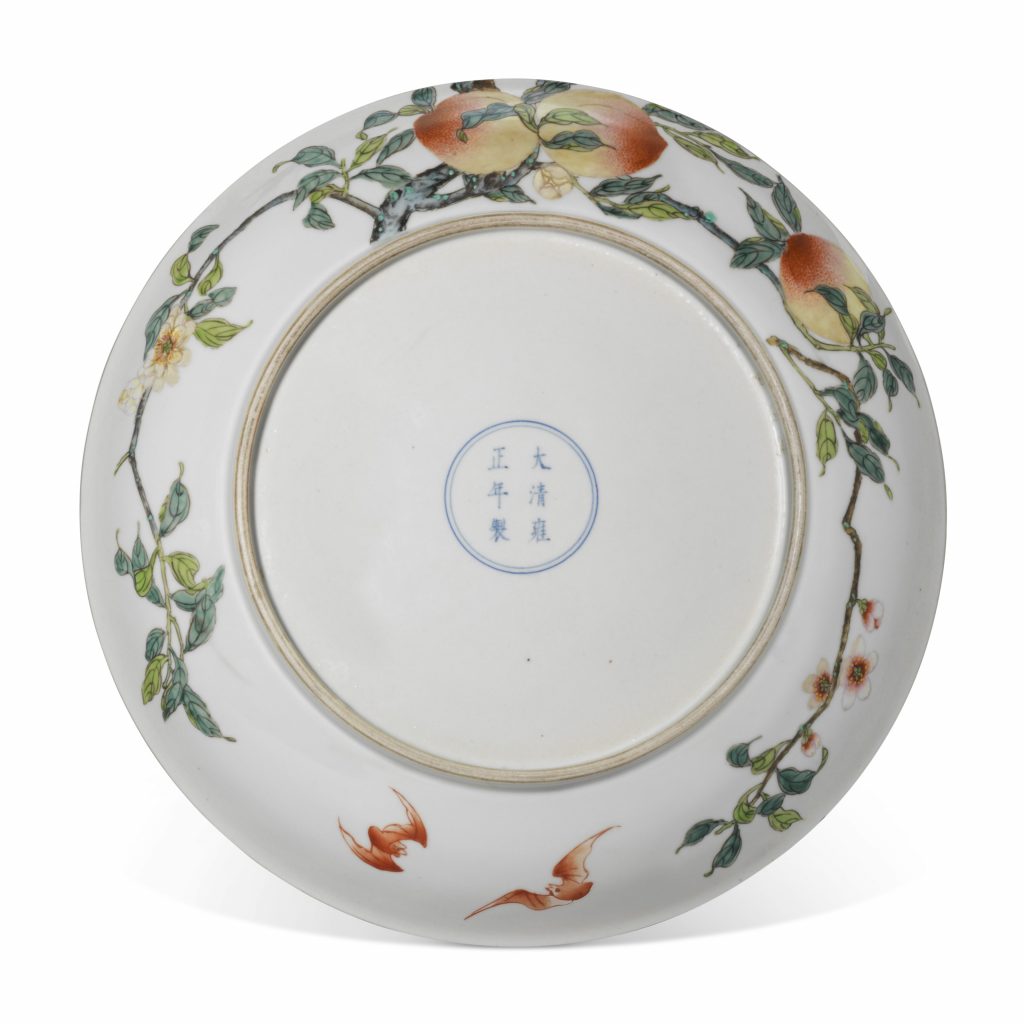
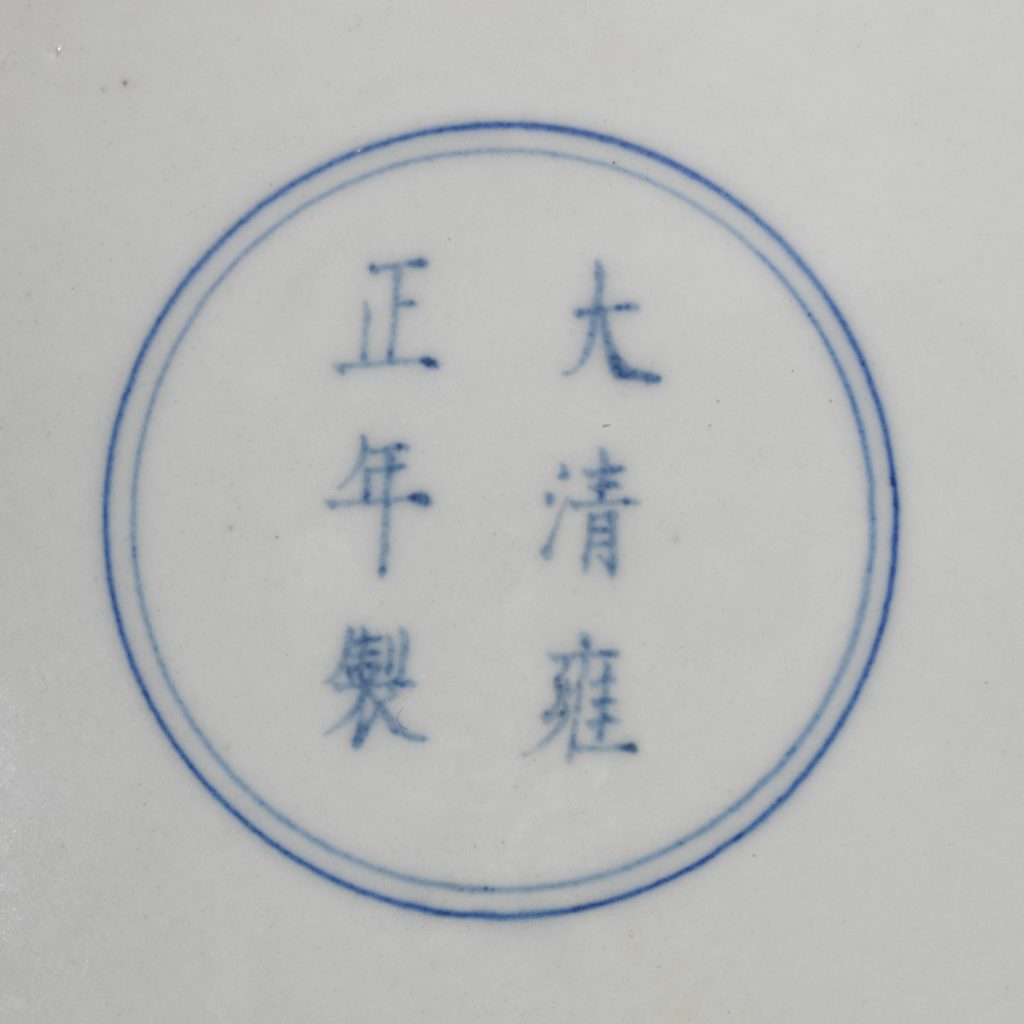
成交價 EUR 2,250
估價 EUR 600 – EUR 1,000
二十世紀 粉彩過枝福壽雙全大盤
CHINE, XXEME SIECLE
Marque apocryphe de l’empereur Yongzheng à la base.
Diamètre: 40 cm. (153⁄4 in.)
狀況報告
拍品的狀況可能存在極大差異,而由於其性質使然,拍品難以處於完美無瑕的狀態。拍品均以拍賣時的狀況出售。
We have sought to record changes in the condition of this piece acquired after its initial manufacture.
– There are some general surface wear and scratches to the enamel.
拍品專文
A LARGE FAMILLE ROSE ‘PEACH’ DISH
CHINA, 20TH CENTURY
参考:苏富比
雍廷聚瑞—雍正御制珍品
Yongzheng – The Age Of Harmony And Integrity
06 四月 2015 • 香港
拍品 112
清雍正 粉彩過枝福壽雙全盌一對 《大清雍正年製》款
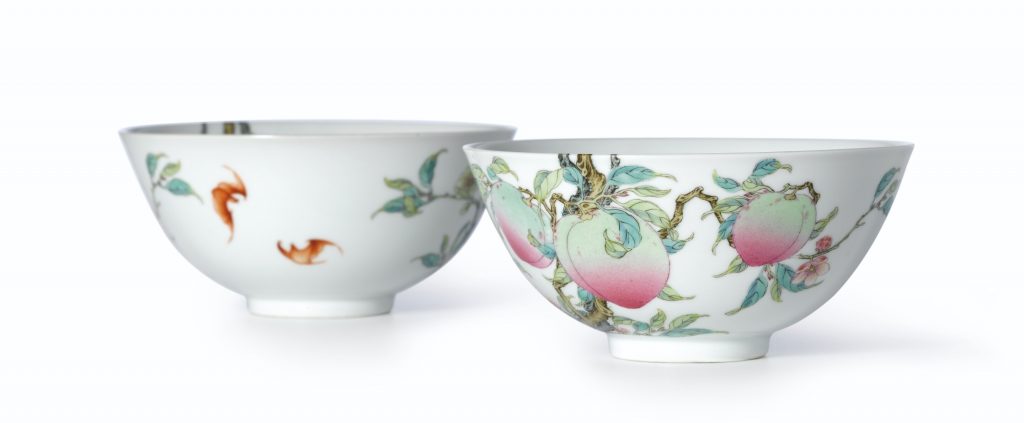
估價 40,000,000 – 60,000,000 HKD
已售出 89,800,000 HKD
描述
《大清雍正年製》款
porcelain
14.3 公分,5 5/8 英寸
each exquisitely potted with deep rounded sides resting on a short foot, superbly enamelled in vivid tones of rose pink, shades of green, yellow, iron-red, brown and black with two varieties of flowering and fruiting peach branches issuing from the foot and extending across the exterior and over the rim onto the interior, one branch with a brownish-black bark and bearing white double blossoms, the other with a brown bark and issuing five-petalled rose-pink blossoms, both with large ripe fruit delicately coloured in shaded tones of yellowish-green to subtle raspberry-pink, depicted in iron-red with two bats on the exterior and three on the interior forming the wufu, the base inscribed in underglaze blue with a six-character reign mark within a double-circle
來源
香港舊藏,1982年前
其一:
香港蘇富比1989年11月14日,編號315
香港徐氏藝術館藏品
香港佳士得1999年4月26日,編號539
倫敦蘇富比2007年5月16日,編號104
展覽
其一:
《徐氏藝術館》,香港,1991年,圖版119 (左)
《徐氏藝術館:陶瓷IV》,香港,1995年,編號155(左)
拍品資料及來源
桃以仙名
李寶平
雍正御瓷福壽雙全圖盌,珍稀至極,雅秀嬌潤。過枝桃蝠紋,源自深植中國文化的祥福意象,得雍正帝垂愛,乃御窯廠為皇家祝壽所燒造,技法及色彩則見歐洲傳教士之影響,不僅身為歷史重要見證,亦是象徵中國宮廷藝術美感及技術之巔峰。
雍正帝即位過程多舛,其正統性屢受質疑,使其自身甚為重視各種祥福吉兆。福壽雙全圖盌之紋飾設計,處處寄意祥福高壽,應為皇室大壽賀慶之意。
桃為中國文化中最富吉祥寓意的鮮果,象徵高壽多福,六為大吉之數,繁花點點的桃枝則有驅邪之力。東晉陶潛(365-427)作〈桃花源記〉,敘述武陵漁人,緣溪溯行,入桃花林,於岩縫後發現世外樂土桃花源。桃樹滿園亦是《三國演義》中,三傑結義之處,其中蜀國名將關羽,受民間供奉為神祇關帝,近達二千年。傳說西王母植長生不老功效之仙桃於蟠桃園,三千陽春始一花,果實更需數千年才得以熟透,僅在設席宴請眾仙時得以一嚐。西漢傳奇文人東方朔,慧黠多智,據說曾盜取王母蟠桃,得永生成仙。類此的情節亦見於《西遊記》中,猴王孫悟空偷得蟠桃,後奉觀世音菩薩之命,隋唐僧玄奘遠渡西天求取佛經。
盌身繪五紅蝠,常見於中國工藝,紅蝠意指洪福齊天,五蝠音同五福,高壽、康寧、富貴、好德、善終。而畫中倒立飛行的蝙蝠,更是諧意「福到」,五福臨門。
此類典故頗得雍正之意,可見其授命畫製的《胤禛行樂圖》冊頁,〈仙桃戲猴〉一景描繪其喜得蟠桃,身旁樹上伴有靈猴(圖一)。同冊另一景,繪其觀瀾之姿,一蝠於上盤旋。
雍正一朝作桃紋於各式器物,然新創粉彩瓷的多樣色調,粉紅、淡黃、淺綠等,最能貼切表現桃實枝葉。此類紋飾首現於清宮造辦處,施作於金屬器身,康熙朝已可見一件銅胎瓶飾以繁花綴綴、結實豐美的桃枝圖(圖二)。雍正朝福壽雙全圖銅胎畫琺瑯盃及盞托,出自造辦處琺瑯作,紋飾與此對桃紋盌相類(圖三)。還有一銅胎畫琺瑯水盂,器身作連枝二桃實,綴蝙蝠紋,錄於《盛世華章》,皇家藝術學院,倫敦,2005-6年,編號295。
雍正帝親信大臣唐英,乃中國歷史上最著名之督陶官,應為首度授命將此式紋飾施作於瓷上之人。粉彩瓷多樣的色調,完美詮釋桃實柔美色澤,桃蕊枝頭嬌豔模樣。康熙晚期入朝的傳教士,帶來歐洲琺瑯彩,得雍正早期景德鎮御窰廠採用,進而發展出粉彩瓷。粉彩色調變化極廣,鮮綠疊粉白、淡粉、桃紅等等,前所未見,將釉上彩發揮地淋漓盡致。因此,雍正一朝,瓷作畫師終於能在瓷胎上恣意繪出寫實美奐的自然景致及色彩,如現例所示。
北京紫禁城造辦處的作坊,亦作桃蝠紋飾於瓷器,參考台北國立故宮博物院藏一對雍正琺瑯彩盌,繪桃樹與五蝠,構圖未若有力(圖四)。
桃樹過枝紋飾繁複,綿延至口沿外壁,繪製不易,但獲雍正帝青睞,為當朝景德鎮御窯廠的創舉,稱為長枝,音類「長治」。清宮內務府造辦處檔案記載,「雍正九年四月十九日,上諭著將有釉無釉白磁器上畫久安長治……」,馮先銘,《中國古陶瓷文獻集釋》,台北,2000年,頁222。
如此寓意吉祥豐富,貼近帝王心意,福壽雙全圖對盌應為帝王大壽所造,如此推測也可參考雍正朝二幅宮廷畫作,其一為陳枚(約1694-1745),〈萬蝠來朝〉,畫中天空滿佈飛蝠,雍正四年(1726)大壽之時,貢呈帝王賀祝萬壽,《盛世華章》,前述出處,編號270。另一出自宮廷畫家金玠(十八世紀)之手,描繪厓岸三名老者,題為〈飛蝠滿天〉,雲間紅蝠紛飛(圖五)。
特為大壽所燒造之器為數甚稀,桃蝠紋雖為雍正御瓷中最具代表性之例,多見載錄,其存世者卻是鳳毛麟角,極為珍罕。現知雍正御瓷長枝「長治」桃蝠紋盌,僅有約五對流傳。
此對福壽雙全圖盌其一曾為香港徐展堂博士靜觀堂珍藏,徐博士收藏的另一盌則出自 John F. Woodthorpe 及 C.M. Moncrieff 珍藏,曾三度售於倫敦蘇富比,1952年12月9日,編號140;1954年4月6日,編號106;1961年2月21日,編號171。另一對出自東京永青文庫珍藏,為日本貴族細川氏設立,存其家族自南北朝時代流傳下來的文物,此對現已拆散:其一入玫茵堂收藏,後售於香港蘇富比,2011年10月5日,編號 16;另一盌現仍存文庫,載於《世界陶磁全集》,卷12,東京,1956年,彩圖版11。日內瓦鮑爾典藏有另一對盌,錄於 John Ayers,《The Baur Collection Geneva: Chinese Ceramics》,日內瓦,1968-74年,卷4,編號 A 594、595。還有一對曾入陳仁濤、白納德伉儷、及 T. Endo 舊藏,於香港蘇富比二次售出,1988年11月15日,編號44,及1997年4月29日,編號401,後售於香港佳士得2007年5月29日,編號1374,並刊載於《香港蘇富比三十週年》,香港,2003年,圖版326。這對桃蝠紋盌現亦分散二方,之一錄於《Fiftieth Anniversary Exhibition: Twelve Chinese Masterworks》,Eskenazi,倫敦,2010年,編號11,另一件則藏於台灣私人收藏。另一對盌1938年由山中商會售出,載於其圖錄《Chinese Ceramic Art, Bronze, Jade etc.》,編號 116,圖版12(此處僅刊出一盌)。
一對近類,但器形比例略異瓷盌,出自 Allen J. Mercher、 John M. Crawford, Jr. 舊藏,售於紐約蘇富比1957年10月10日,編號261,1978年5月24日由香港蘇富比售出,編號252。此設計紋樣,至乾隆一朝仍舊沿用,例可參考一件署乾隆年款之盌,見於Soame Jenyns,《Later Chinese Porcelain: The Ch’ing Dynasty (1644-1912)》,倫敦,1951年,圖版LVI,圖2。
雍正御瓷亦見其他桃紋器形,數目同是珍稀,例如 Hon. Ogden R. Reid 舊藏,著名粉彩九桃紋瓶,2002年5月7日於香港蘇富比售出,2004年由張永珍博士捐贈予上海博物館(圖六);一件先後為 Van Slyke 及玫茵堂珍藏的桃紋蓋盒,2013年4月8日售於香港蘇富比,編號3036;桃紋大盤,如一例出自 J. Pierpont Morgan 舊藏曾售於香港蘇富比,1997年4月29日,編號400,另一盤藏北京故宮博物院,見《盛世華章》,前述出處,編號181。《雲海閣》重要中國瓷器.張宗憲珍藏展,倫敦佳士得,1993年,書中提及一批器形較小的桃紋盤,編號92;倫敦大英博物館也有一盤,刊錄於《Oriental Ceramics, The World’s Great Collections》,卷5,紐約,1981年,彩圖67;另一例載於 Denise Patry Leidy,《Treasures of Asian Art. The Asia Society’s Mr. and Mrs. John D. Rockefeller 3rd Collection》,紐約,1994年,圖版198。 桃紋御瓷亦見天球瓶,如北京故宮博物院藏一瓶,見於《故宮博物院藏清代御窰瓷器》,2005年,卷1(下),圖版76;另一例展出於《The Barbara Hutton Collection of Chinese Porcelain》,檀香山藝術博物館,檀香山,1956-7年,圖版XV,1971年7月6日,售於倫敦蘇富比,編號259,再度售於香港蘇富比1996年4月30日,編號498。
此對福壽雙全圖盌,其一曾在香港蘇富比售出,1989年11月14日,編號315,然在此之前似乎曾為一對,刊於徐展堂博士靜觀堂珍藏《徐氏藝術館:陶瓷IV》,香港,1995年,圖版155(左),再度售於香港佳士得1999年4月26日,編號539,及倫敦蘇富比2007年5月16日,編號104。相別二十數載,此對盌終能再聚。原藏靜觀堂的另一盌,出自 John F. Woodthorpe 與 C.M. Moncrieff 舊藏,三度售於倫敦蘇富比,1952年12月9日,編號140;1954年4月6日,編號106;1961年2月21日,編號171。
参考:苏富比
Chinese Art
01 六月 2015 • 香港
拍品 517
晚清 粉彩福壽雙全圖蓮花口盤 《大清乾隆年製》仿款
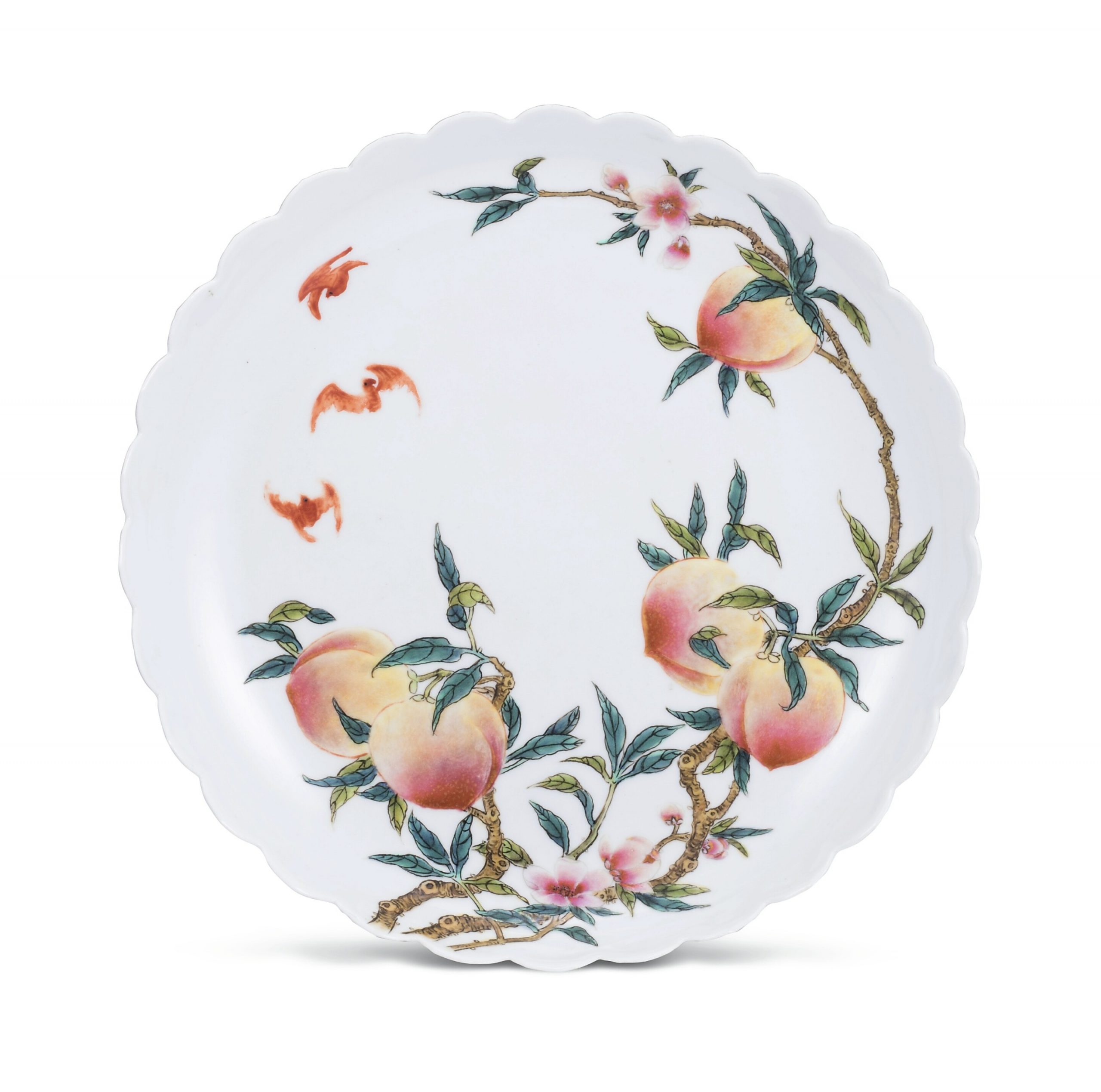
估價 20,000 – 30,000 HKD
已售出 43,750 HKD
描述
《大清乾隆年製》仿款
porcelain
25.9 公分,10 英寸
with a scalloped rim, finely painted with a fruiting and flowering branch of peach tree continuing onto the exterior, five iron-red bats fluttering by, apocryphal Qianlong mark
來源
倫敦蘇富比2002年9月10日,編號255
参考:苏富比
中國藝術珍品
07 十月 2015 • 香港
拍品 3610
清乾隆 粉彩九桃天球瓶 《大清乾隆年製》款
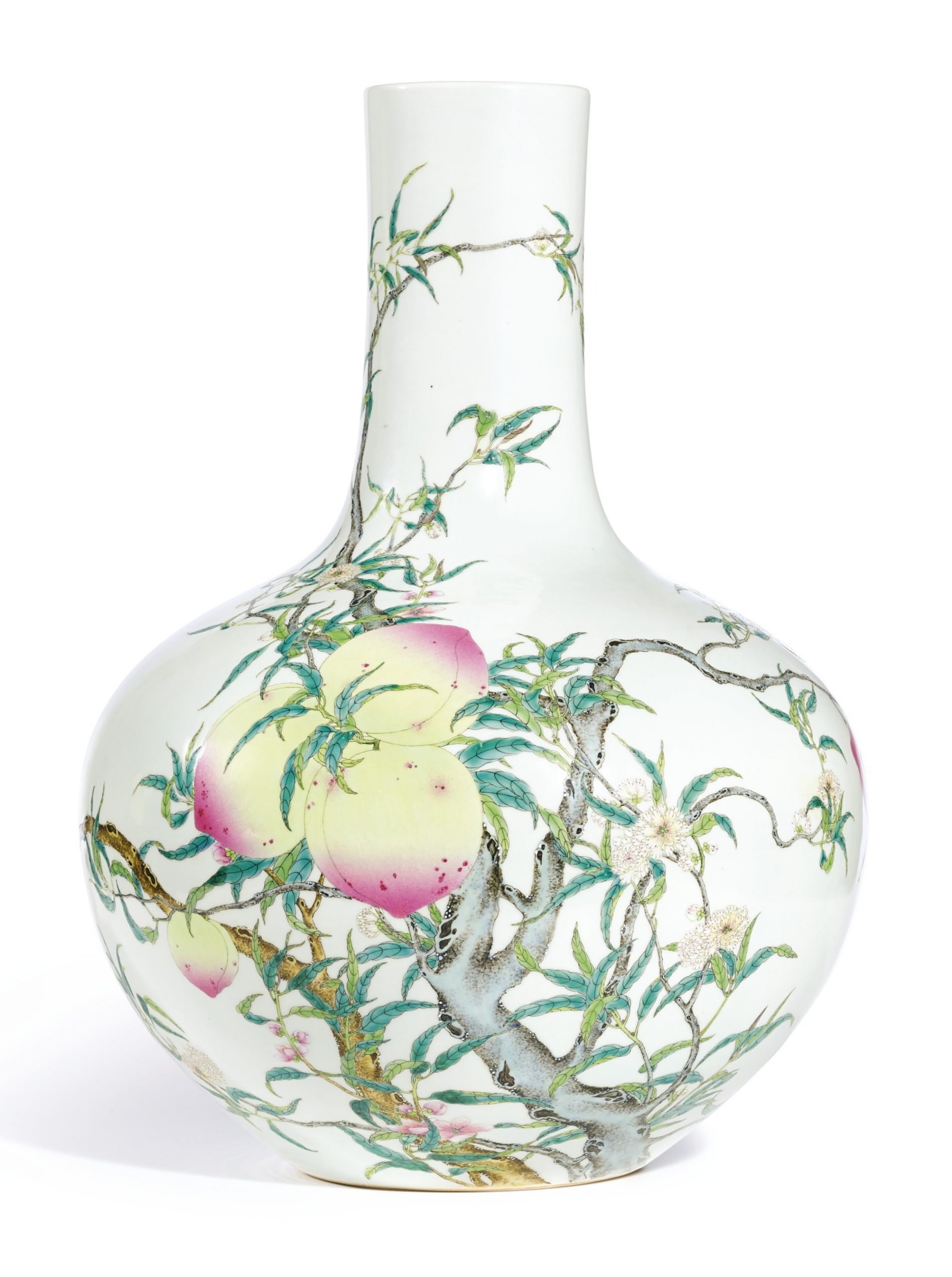
估價 60,000,000 – 80,000,000 HKD
已售出 63,480,000 HKD
描述
《大清乾隆年製》款
porcelain
54.7 公分,21 1/2 英寸
powerfully constructed with a globular body rising to a tall cylindrical neck flaring slightly at the rim, masterfully painted with an asymmetric design of two peach branches growing halfway around the vase and wrapping around the neck, one gnarled branch depicted with brown bark and pink blossoms, the other with dark grey bark with white blossoms edged in pink, the nine peaches depicted in different stages of ripeness ranging in colour from light yellowish-green to rose-pink deepening to darker pink spots and patches, the green-enamelled leaves shaded in turquoise and a yellowish-green to distinguish their top and underside, the lichen on the bark picked out in white and light turquoise-blue dots, the recessed base inscribed with a six-character seal mark
來源
仇焱之收藏
胡惠春收藏
紐約蘇富比1985年6月4日,編號55
倫敦蘇富比2000年11月14日,編號168(時同斷代清乾隆,然疑粉彩後加)
出版
仇焱之及 Helen D. Ling ,《暫得樓珍藏歷代名瓷影譜》,香港,1950年,卷4,圖版215
拍品資料及來源
灼灼桃之華
李寶平
雍正、乾隆朝粉彩蟠桃福壽紋瓷器,要屬中國歷代最秀雅瓷器之一,燒造於景德鎮御窰廠,紋飾喜慶吉祥,釉上粉彩色調柔美,受歐洲傳教士影響啟發,珍稀非凡,代表著中國宮廷藝術中,美感及技術之巔峰。
自古伊始,桃乃吉祥長壽之徵,桃枝且能避邪。孔子所編的《詩經.國風》中即有「桃之夭夭,灼灼其華。之子于歸,宜其室家」等句,以繁盛桃花贊譽美滿幸福之婚姻家庭。陶潛(365-427)在《桃花源》序中述,武陵漁人溯溪前行,入桃花林,通山中小洞,達世外仙境。桃樹滿園亦是《三國演義》中,三傑結義之地,其中蜀國名將關羽,受民間供奉為神祇關帝。傳說西王母種有仙桃,「三千陽春始一花」,果實要待三千年才成熟,僅用以宴請眾仙。西漢傳奇文人東方朔,機智詼諧,據說曾盜取王母蟠桃,吃而成仙。《西遊記》中,猴王孫悟空也曾偷得蟠桃,後奉觀世音菩薩之命,隨唐僧玄奘遠渡西天求取佛經。
此類典故頗得雍正之意,《胤禎行樂圖.東方朔偷桃》冊頁,繪世宗手執仙桃,似為靈猴剛從樹上摘下進獻(圖一),同冊另一景,繪其觀瀾之姿,一蝠於上盤旋。雍正帝即位過程波折,其正統性屢受質疑,使其自身更為重視各種祥福吉兆。
清初已燒製多樣桃紋御瓷,如康熙五彩描金萬壽桃紋盤,《故宮珍藏康雍乾瓷器圖錄》,香港,1989年,頁70,圖版53(圖二)。雍正一朝廣作蟠桃紋於各式器物,時與蝙蝠紋搭配,取福壽之意。雍正帝傾愛桃紋,亦見御瓷盌底繪一壽桃,書年款於內,見《金成旭映:清雍正琺瑯彩瓷》,2013年,編號7。
直至雍正一朝,瓷作畫師始能於瓷胎上,以新創之粉彩,恣意繪出寫實美奐的自然景致及色彩。粉彩源自康熙晚期,歐洲傳教士帶入之琺瑯彩,康熙末雍正初,得景德鎮御窰廠採用,研究發展而來。此次拍賣之雍正粉彩過枝福壽雙全盌及乾隆粉彩九桃天球瓶,桃紋色彩柔和美絕,淡粉、嫩黃、鮮綠等,充分展現新創粉彩的高度發展。
雍正朝另一新舉為過枝紋飾,其構圖繁複,繪桃枝綿延至口沿外壁,繪製不易,但受雍正帝青睞,稱為長枝,音類「長治」。長枝紋可能源自康熙時期造辦處琺瑯作設計之樣板(圖三),然雍正時始作於御瓷。清宮內務府造辦處檔案記載,「雍正九年四月十九日,上諭著將有釉無釉白磁器上畫久安長治……」,馮先銘,《中國古陶瓷文獻集釋》,臺北,2000年,頁222。
乾隆帝亦愛粉彩蟠桃紋,雍正、乾隆二朝均見此紋飾之盌器、盤、天球瓶。乾隆偏愛華美大方之器,當朝燒造天球瓶數目亦較前朝為多,為乾隆御瓷中特為出色之品類。
雍乾二朝粉彩蟠桃紋瓷,雖負盛名,然數量珍稀,此二件拍品秀雅討喜,更勝多數現存作例。可相比較之例,屈指可數,例如 Hon. Ogden R. Reid 舊藏,著名粉彩蝠桃紋瓶,2002年5月7日於香港蘇富比售出,編號532,2004年由張永珍博士捐贈予上海博物館,為現知唯一的粉彩福壽紋橄欖瓶(圖四)。
此次拍賣雍正粉彩過枝福壽雙全盌及乾隆粉彩九桃天球瓶,均曾為仇焱之珍藏,仇氏為二十世紀中國藝術領域中最富影響力人物之一。仇氏收藏涵蓋明清官瓷及工藝品、高古陶瓷、青銅器等,1980-81年香港及倫敦蘇富比舉辦三場仇氏珍藏專拍,被視為至今最重要的中國藝術專場拍賣之一。
___________________________________
乾隆延續先帝雍正對桃紋之喜愛,可見1790年乾隆八十大壽時,朝臣獻貢一珊瑚金胎桃形壽字紋蓋盒為其祝壽,圖見《盛世華章》,英國皇家藝術學院,倫敦,2005-6年,編號294(圖五)。此件九桃天球瓶所飾桃紋蜿蜒交鎖,為乾隆時期經典繪瓷紋樣之一,桃枝成雙,花別樹異,瑞果碩結,共生九桃,用意雋永,寄寓豐實長壽。
「天球瓶」以器腹圓鼓近似天球得名,首見於明初,是時正逢穆斯林太監鄭和帶領浩大船隊下西洋之航海時代,天球器形可能取自中東回教銅器或料器造形,見馬文寬,〈明代瓷器中伊斯蘭因素的考察〉,《考古學報》,1999年第4期,頁12,圖13-14。天球瓶器形盛行於乾隆一朝,可見各式釉彩、紋飾作例,然而類同此件拍品之粉彩桃紋天球瓶,鳳毛麟角,現知僅有寥寥幾例。試比較其他相類天球瓶,此件拍品之桃實紋色澤粉柔,嫩黃漸變嬌紅,間綴巧緻紅斑,桃葉扶疏,露桃枝曼妙之姿,尤其珍罕。
北京故宮藏紋飾相若瓶例,二例錄於《故宮珍藏康雍乾瓷器圖錄》,前述出處,頁335,圖版16,及《故宮博物院藏文物珍品全集:琺瑯彩.粉彩》,香港,1999年,圖版86,後者或亦載於耿寶昌,《明清瓷器鑑定》,香港,1993年,圖443。另有台灣國立故宮博物院藏例,見《故宮清瓷圖錄-乾隆窰.嘉慶窰.道光窰》,東京,1981年,圖版27;清宮遼寧避暑山莊亦見一瓶,刊於《瀋陽故宮博物院院藏文物精粹.瓷器卷》,瀋陽,2008年,頁177,圖版11;北京中國國家博物館藏例,見《中國國家博物館館藏文物研究叢書.瓷器卷:清代》,上海,2007年,圖版88;還有一瓶現存倫敦大英博物館 ,載於 Jessica Rawson 編,《The British Museum Book of Chinese Art》,倫敦,1992年,圖版187。
玫茵堂舊藏乾隆粉彩天球瓶,售於香港蘇富比2011年10月5日,編號15。另見趙從衍珍藏一件乾隆天球瓶,1986年11月18日售於香港蘇富比,編號134,刊於《蘇富比香港二十周年》,香港,1993年,圖版277。乾隆朝雖見蟠桃蝙蝠紋沿用其他器形,然數目亦少,例可參考一件署乾隆年款之盌,見於 Soame Jenyns,《Later Chinese Porcelain: The Ch’ing Dynasty (1644-1912)》,倫敦,1951年,圖版LVI,圖2。
一件罕有的雍正樣例,僅繪八桃,見耿寶昌編著,《故宮博物院藏清代御窰瓷器》,北京,2005,卷一(下),圖版76,並錄於《故宮博物院藏文物珍品全集:琺瑯彩.粉彩》,前述出處,圖版45(圖六)。另有一件屬 Barbara Hutton 舊藏,上繪九桃,列展於《The Barbara Hutton Collection of Chinese Porcelain》,檀香山藝術學院,檀香山,1956-7年,編號XV,其後售於倫敦蘇富比1971年7月6日,編號259,以及香港蘇富比1996年4月30日,編號498。一件器形較小雍正朝六桃紋瓶,刊載於《故宮珍藏康雍乾瓷器圖錄》,前述出處,頁210,圖版39。
相類桃紋天球瓶,可參考二件青花作例,繪桃實及其他瑞果,其一曾售於紐約及倫敦蘇富比,1983年6月15日,編號394,1999年11月17日,編號783;另一件為黃地青花,2014年4月8日售於香港蘇富比,編號3008。亦可比較一件明代宣德窰青花花卉紋天球瓶,書宣德年款,刊於耿寶昌編,《故宮博物館藏:明初青花瓷》,北京,2002年,卷1,編號78。
此件粉彩九桃天球瓶曾為胡惠春典藏(圖七),胡氏為一代鑑賞名家,其珍藏名聞遐邇,多數陶瓷藏品已捐贈上海博物館,現展出於暫得樓陶瓷館,並曾出版於汪慶正、范季融主編,《胡惠春先生王華雲女士捐贈瓷器精品選》,上海博物館,上海,1989年。2005年,部份藏品展出於香港中文大學藝術館、上海博物館、北京首都博物館協力舉辦之《暫得樓清代官窰單色瓷器》,香港,2005年。香港蘇富比2012年10月9日專場拍賣「敦樸涵芳:胡惠春舊藏清代單色御瓷」,售出十二件胡氏舊藏清代御窰單色瓷精品。
参考:苏富比
中國藝術珍品
07 十月 2015 • 香港
拍品 3611
清雍正 粉彩過枝福壽雙全盌 《大清雍正年製》款
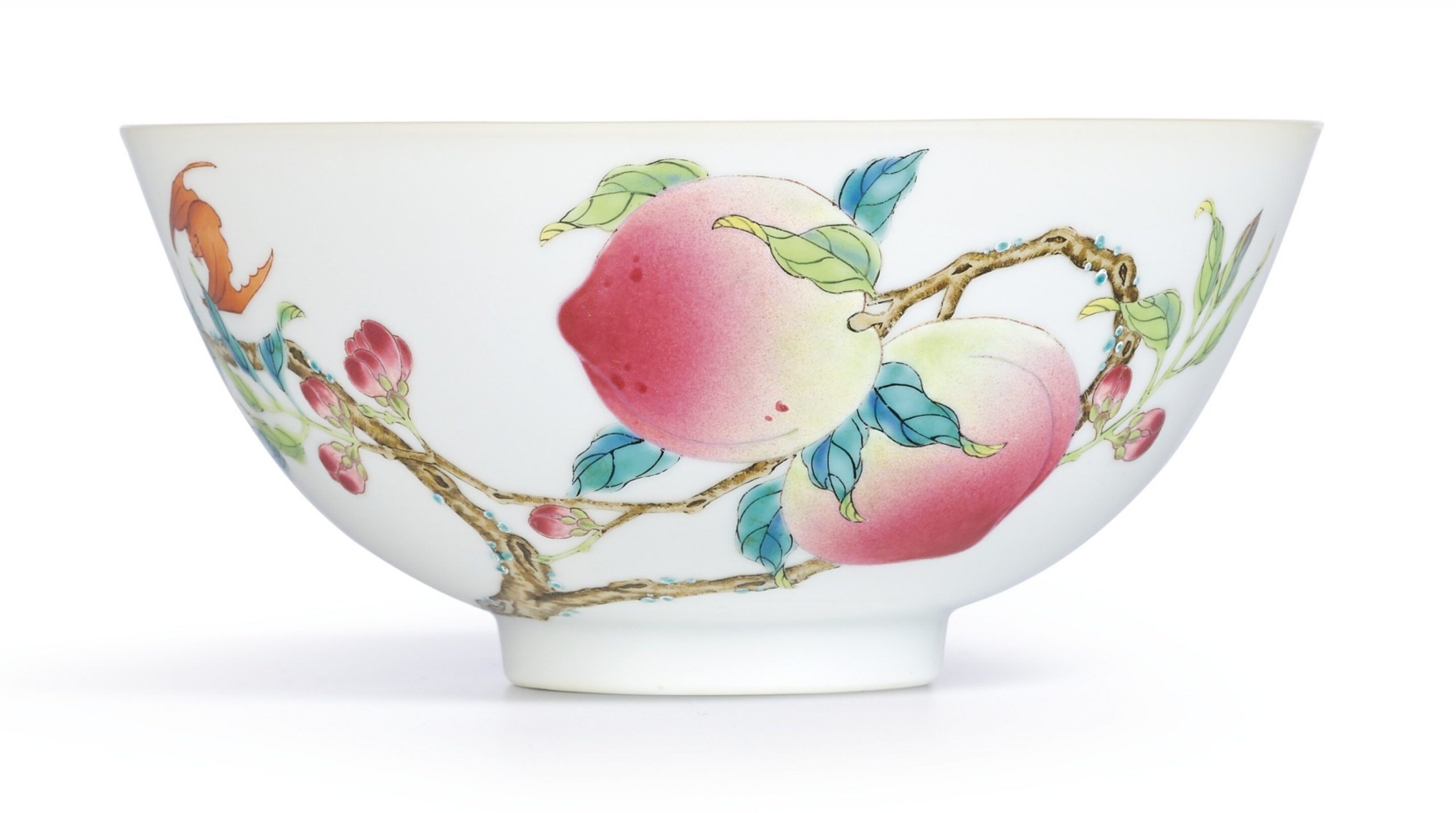
估價 40,000,000 – 60,000,000 HKD
描述
《大清雍正年製》款
porcelain
14.3 公分,5 5/8 英寸
exquisitely potted with deep rounded sides resting on a short foot, superbly enamelled in vivid tones of rose-pink, shades of green, yellow, iron-red, brown and black with two varieties of flowering and fruiting peach branches issuing from the foot and extending across the exterior and over the rim onto the interior, one branch with a brownish-black bark and bearing white double blossoms, the other with a brown bark and bearing five-petalled rose-pink blossoms, both with large ripe fruit delicately coloured in shaded tones of yellowish-green to subtle raspberry-pink, depicted in iron-red with two bats on the exterior and three on the interior forming the wufu, the base inscribed in underglaze blue with a six-character reign mark within a double-circle
來源
仇焱之收藏
香港蘇富比1980年11月25日,編號169
出版
Cécile 及 Michel Beurdeley,《La céramique chinoise》,弗萊堡,1974年,彩圖86-87
朱湯生,《中國瓷器—莊紹綏收藏》,香港,2009年,圖版96
拍品資料及來源
雍正御瓷福壽雙全圖盌,珍罕至極,此盌繪五壽桃於外壁,獨一無二,現知其他作例,均繪六桃,四桃於外,內壁雙桃。桃實不帶明顯暗紅輪廓線,為其另一特點,展現畫師高超技藝,及粉彩新技術帶來的突破。
五為吉利之數,中國藝術品常見五紅蝠紋裝飾,「紅蝠」音同「鴻福」,「五蝠」意謂「五福」,高壽、富貴、康寧、好德、善終。繪蝙蝠倒飛,「倒」音同「到」,為福到之意。
臺北故宮藏雍正朝銅胎畫琺瑯粉橘地福壽盃、托,出自造辦處琺瑯作,紋飾與此對桃紋盌相類,展出於《雍正:清世宗文物大展》,臺北,2009年,編號II-18。還有一銅胎畫琺瑯水盂,器身作連枝二桃實,綴蝙蝠紋,錄於《盛世華章》,英國皇家藝術學院,倫敦,2005-6年,編號295。
二幅雍正朝宮廷畫作,可見蝙蝠紋盛行一時,陳枚(約1694-1745),《萬蝠來朝》,畫中天空滿佈飛蝠,雍正四年(1726)大壽之時,貢呈帝王賀祝萬壽,《盛世華章》,前述出處,編號270(圖一)。另一出自十八世紀宮廷畫家金玠之手,描繪涯岸三名老者,雲間紅蝠紛飛,題為〈飛蝠滿天〉,意喻鴻福無盡,錄於《雍正:清世宗文物大展》,編號II-112。
雍正御瓷長枝「長治」福壽紋盌,現知僅有約五對流傳,皆為名家所藏。徐展堂博士靜觀堂珍藏一對福壽雙全圖盌,錄於《徐氏藝術館:陶瓷IV.清代》,香港,1995年,圖版155,及《徐氏藝術館》,香港,1991年,圖版119。此對盌其一出自香港蘇富比1989年11月14日,編號315;香港佳士得1999年4月26日,編號539;倫敦蘇富比2007年5月16日,編號104;並與另一件福壽紋盌,於香港蘇富比2015年4月7日售出,編號112。徐博士收藏的另一盌則出自 John F. Woodthorpe 及 C.M. Moncrieff 珍藏,曾三度售於倫敦蘇富比,1952年12月9日,編號140;1954年4月6日,編號106;1961年2月21日,編號171。
另一對雍正粉彩福壽紋盌出自東京永青文庫珍藏,為日本貴族細川氏設立,存其家族自南北朝時代流傳下來的文物,此對現已拆散:一盌入玫茵堂收藏,後售於香港蘇富比2011年10月5日,編號 16;另一盌現仍存文庫,載於《世界陶磁全集》,卷12,東京,1956年,彩圖版11。日內瓦鮑爾典藏有另一對盌,錄於 John Ayers,《The Baur Collection Geneva: Chinese Ceramics》,日內瓦,1968-74年,卷4,編號 A 594、595。還有一對曾入陳仁濤、白納德伉儷、及 T. Endo 舊藏,於香港蘇富比二次售出,1988年11月15日,編號44,及1997年4月29日,編號401,後售於香港佳士得2007年5月29日,編號1374,並刊載於《香港蘇富比三十週年》,香港,2003年,圖版326。這對桃蝠紋盌現亦分散二方,之一錄於《Fiftieth Anniversary Exhibition: Twelve Chinese Masterworks》,Eskenazi,倫敦,2010年,編號11,另一件則存於臺灣私人收藏。另一對盌1938年由山中商會售出,載於其圖錄《Chinese Ceramic Art, Bronze, Jade etc.》,編號 116,圖版12(此處僅刊出一盌)。Avery Brundage 收藏也見一盌,現存舊金山亞洲藝術博物館,載於 Terese Tse Bartholomew,《中國吉祥圖案》,舊金山亞洲藝術博物館,洛杉磯,2006年,頁204,編號7.44.1。
一對近類,但器形比例略異瓷盌,出自 Allen J. Mercher、 John M. Crawford, Jr. 舊藏,售於紐約蘇富比1957年10月10日,編號261,1978年5月24日由香港蘇富比售出,編號252。清宮造辦處琺瑯作亦繪福壽紋於瓷上,可參考臺北國立故宮博物院藏一對雍正琺瑯彩盌,繪桃樹與五蝠,然構圖未若有力,展於《金成旭映:清雍正琺瑯彩瓷》,臺北,2013年,圖版82。
雍正御瓷亦見其他桃紋器形,數目同是珍稀,一件先後為 Van Slyke 及玫茵堂珍藏的蟠桃獻壽圖圓蓋盒,2013年4月8日售於香港蘇富比,編號3036,為現知此類唯一之例(圖二)。桃紋大盤,如一例出自 J. Pierpont Morgan 舊藏曾售於香港蘇富比,1997年4月29日,編號400,另一盤藏北京故宮博物院,見《盛世華章》,前述出處,編號181。《雲海閣》重要中國瓷器.張宗憲珍藏展,倫敦佳士得,1993年,書中提及一批器形較小的桃紋盤,編號92。倫敦大英博物館也有一盤,刊錄於《Oriental Ceramics, The World’s Great Collections》,卷5,紐約,1981年,彩圖67。另一例載於 Denise Patry Leidy,《Treasures of Asian Art. The Asia Society’s Mr. and Mrs. John D. Rockefeller 3rd Collection》,紐約,1994年,圖版198。其他還有先後為 Barbara Hutton 及英國鐵路基金會珍藏的一對福壽紋盌,1985-88年借展達拉斯美術館,刊於《蘇富比香港二十周年》,香港,1993年,頁202,編號276,曾二度售於倫敦蘇富比,1971年7月6日,編號265,1974年7月8日,編號408,並二度由香港蘇富比拍出,1977年11月29日,編號160,1989年5月16日,編號88,最近一次售於香港佳士得,2014年5月28日,編號3319。
参考:苏富比
Important Chinese Art
9 October 2020 • 14:00 HKT • Hong Kong
PROPERTY FROM THE ALAN CHUANG COLLECTION
莊紹綏珍藏
3622
AN EXTREMELY FINE AND RARE FAMILLE-ROSE ‘PEACH’ BOWL MARK AND PERIOD OF YONGZHENG
清雍正 粉彩過枝福壽雙全盌 《大清雍正年製》款
Premium Lots
Guaranteed Property

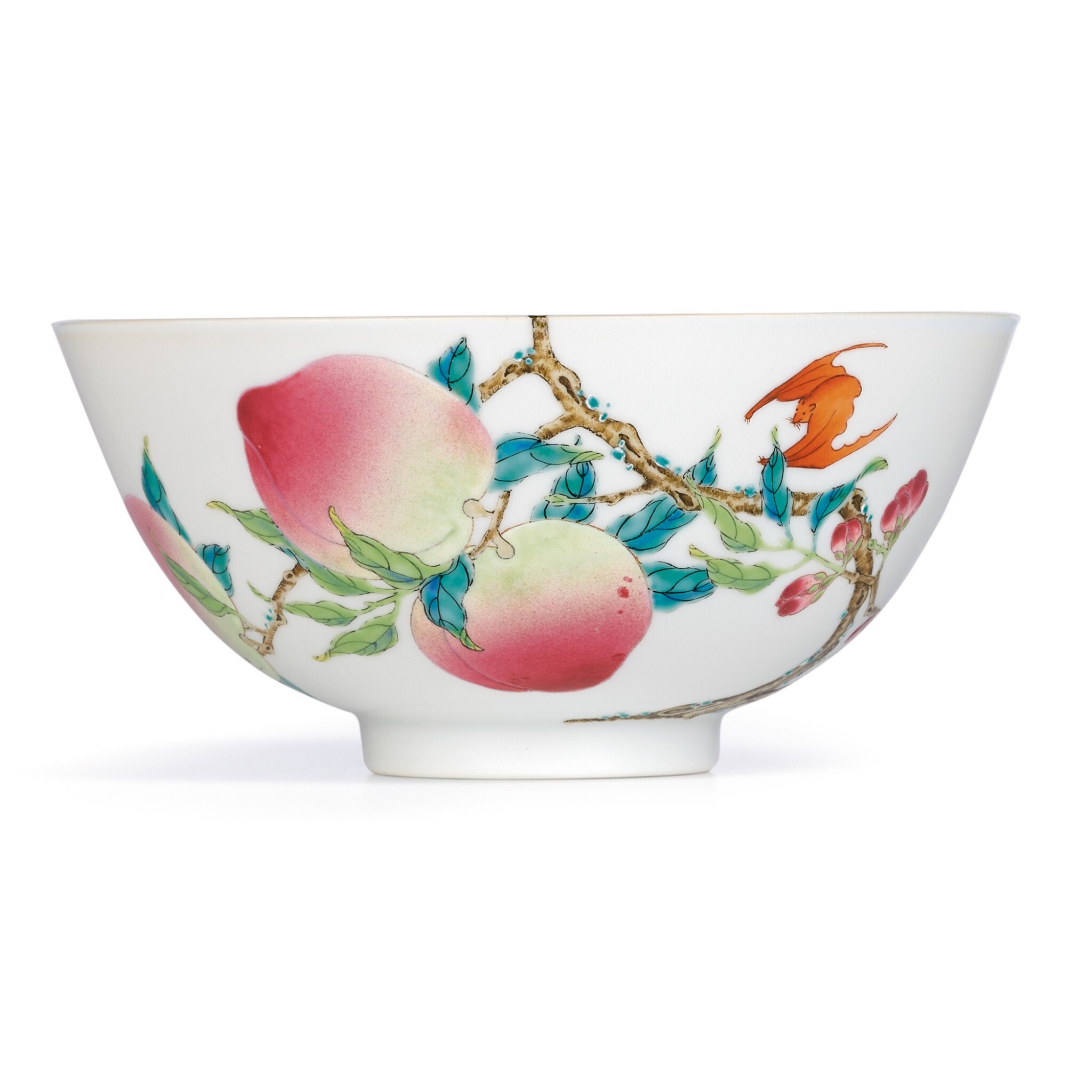
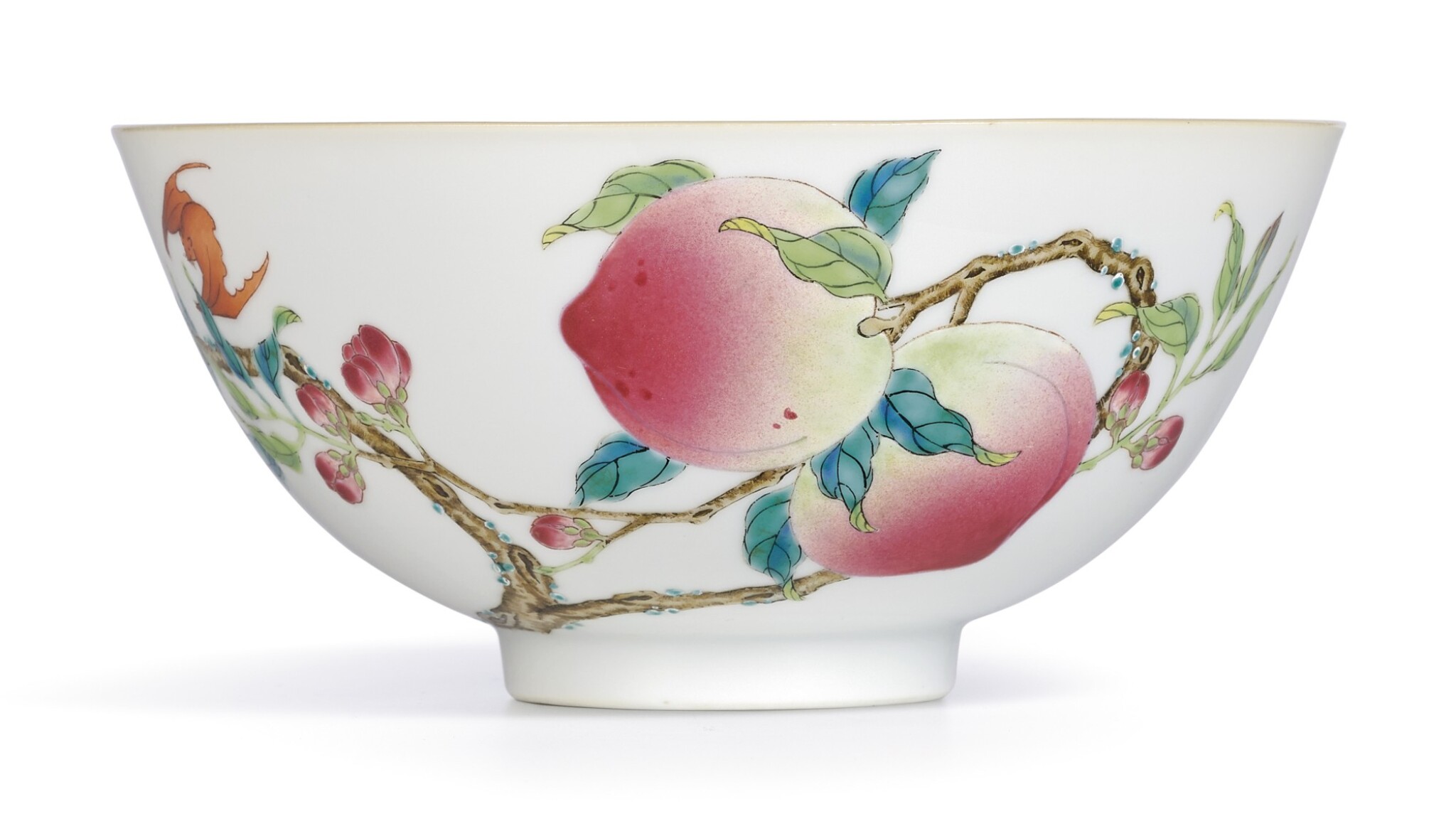
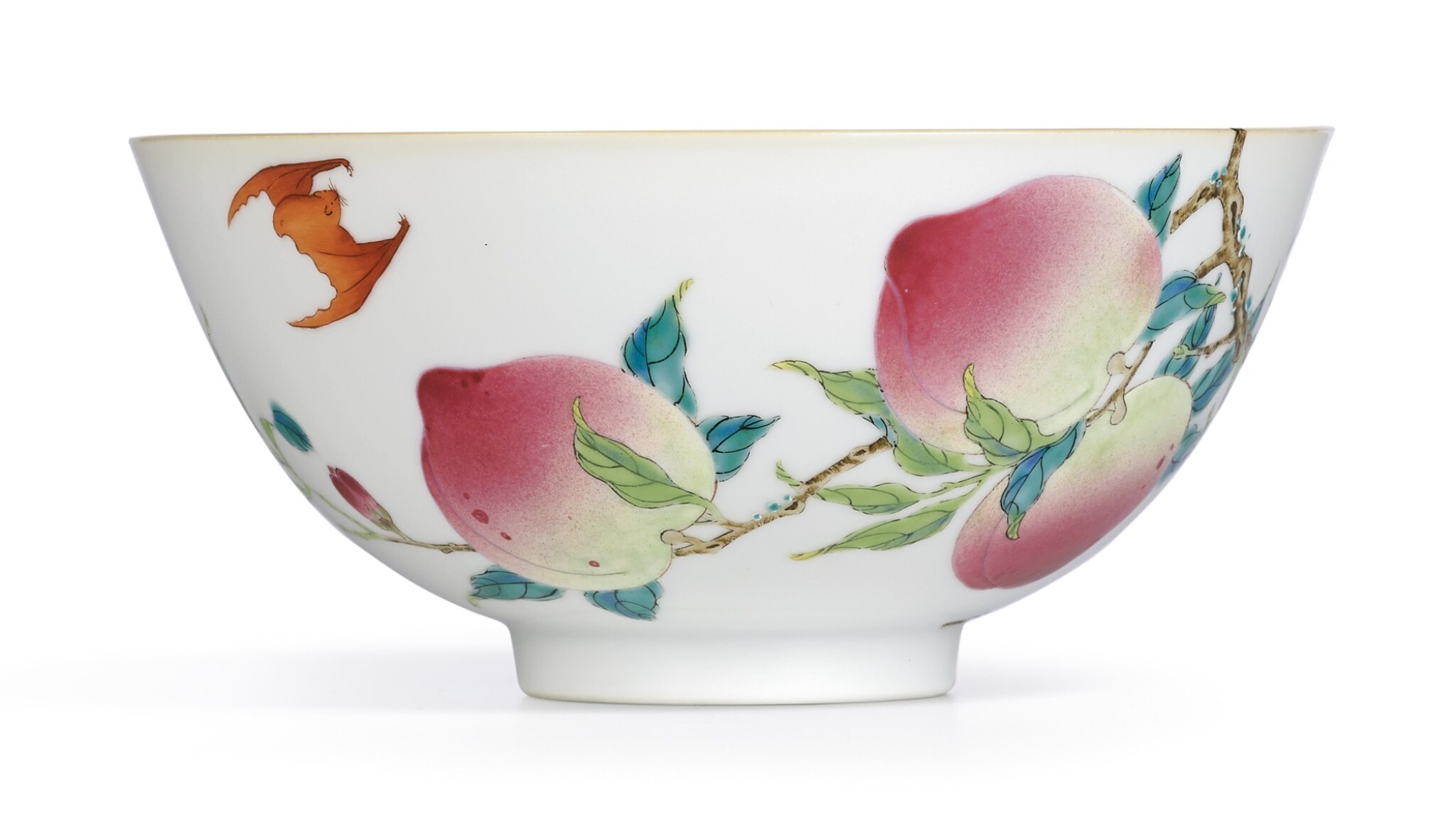
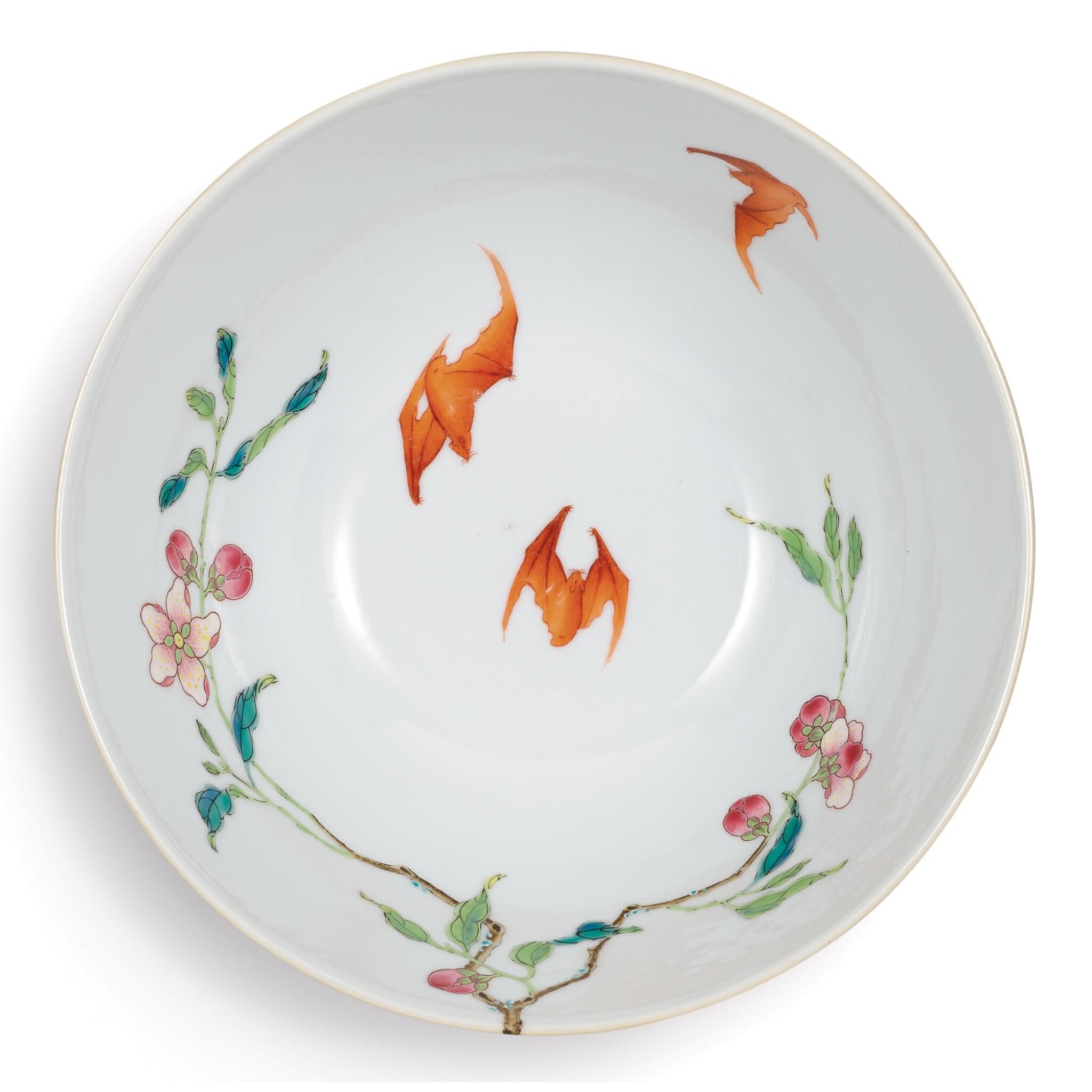
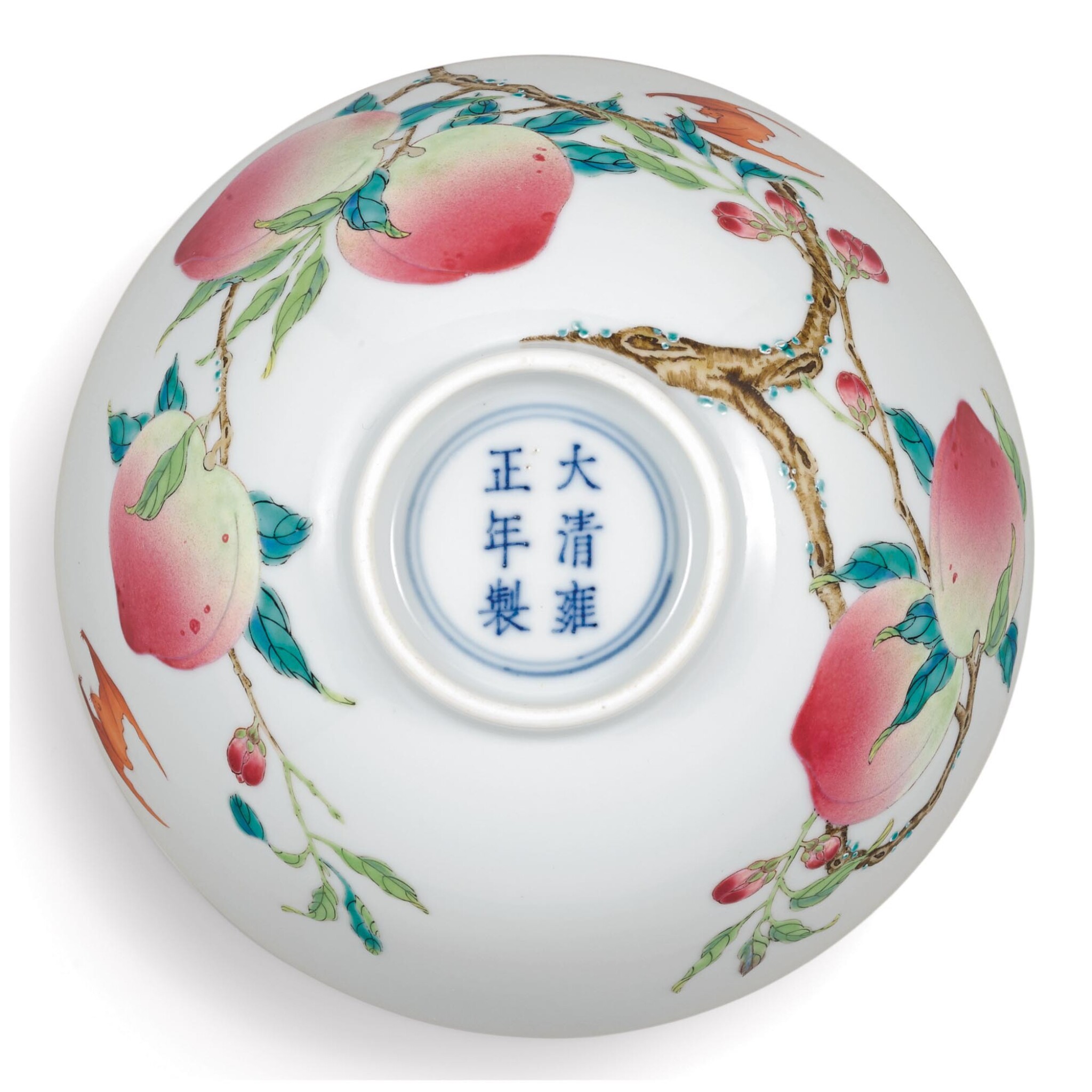
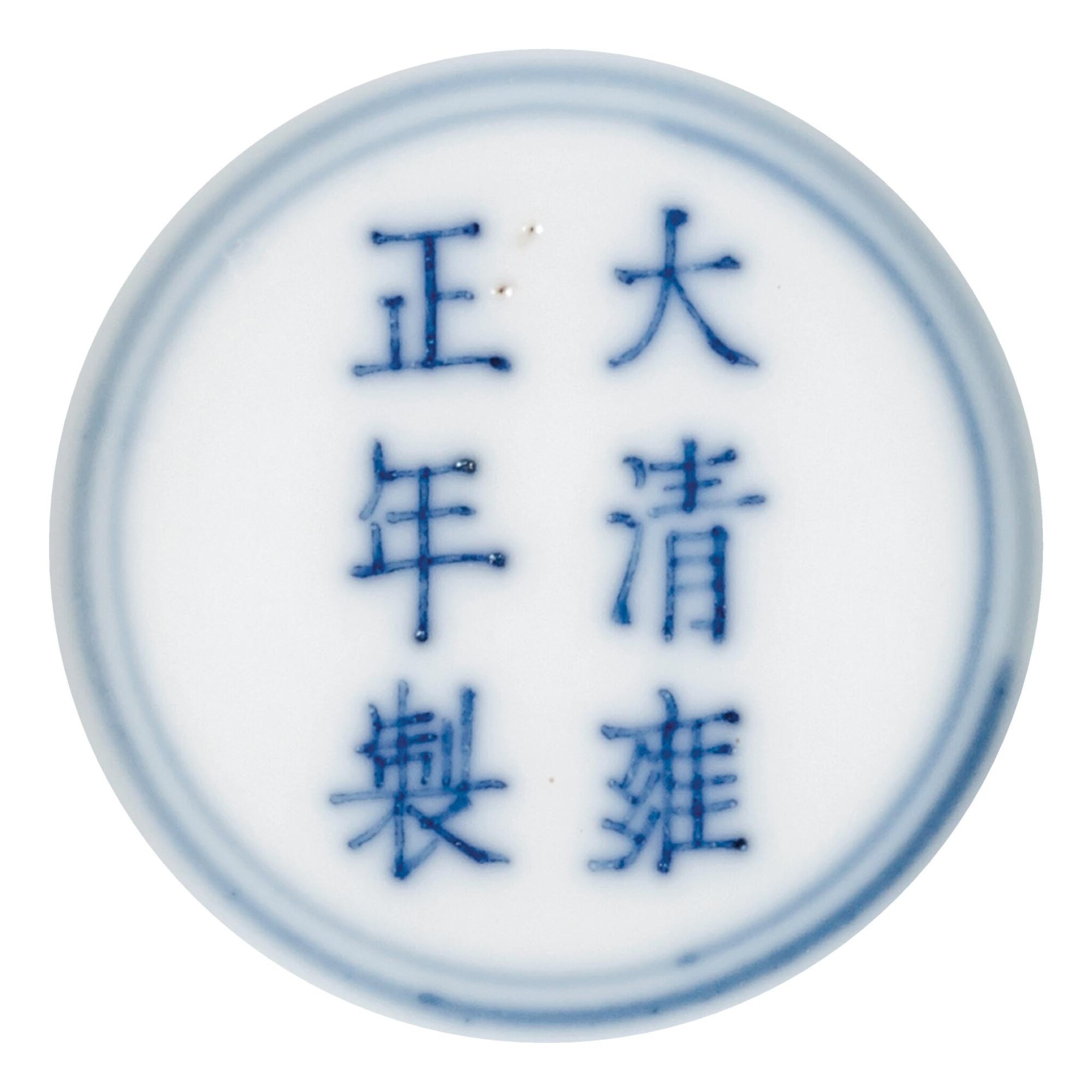
Estimate: 25,000,000 – 35,000,000 HKD
Lot sold: 26,795,000 HKD
Condition Report
The bowl is in extremely good condition with the enamels well preserved.
整體品相完好。
Description
Property from the Alan Chuang Collection
AN EXTREMELY FINE AND RARE FAMILLE-ROSE ‘PEACH’ BOWL
MARK AND PERIOD OF YONGZHENG
清雍正 粉彩過枝福壽雙全盌
《大清雍正年製》款
superbly enamelled in vivid tones of rose-pink, shades of green, yellow, iron-red, brown and black with two varieties of flowering and fruiting peach branches issuing from the foot and extending across the exterior and over the rim onto the interior, one branch with a brownish-black bark and bearing white double blossoms, the other with a brown bark and bearing five-petalled rose-pink blossoms, both with large ripe fruit delicately coloured in shaded tones of yellowish-green to subtle raspberry-pink, depicted in iron red with two bats on the exterior and three on the interior forming the wufu, the base inscribed in underglaze blue with a six-character reign mark within a double circle
14.3 cm, 5 ⅝ in.
Provenance
Collection of Edward T. Chow (1910-80).
Sotheby’s Hong Kong, 25th November 1980, lot 169.
仇焱之(1910-1980年)收藏
香港蘇富比1980年11月25日,編號169
Literature
Cécile and Michel Beurdeley, La Céramique Chinoise, Fribourg, 1974, col. pls 86-87.
Julian Thompson, The Alan Chuang Collection of Chinese Porcelain, Hong Kong, 2009, pl. 96.
Cécile 及 Michel Beurdeley,《La céramique chinoise》,弗萊堡,1974年,彩圖86-87
朱湯生,《中國瓷器:莊紹綏收藏》,香港,2009年,圖版96
Catalogue Note
Yongzheng porcelain bowls with famille-rose peach-and-bat design are extremely rare. The present bowl, with five peaches all rendered on the exterior, appears to be unique, as other examples are designed with six peaches, four on the exterior and two on the interior. Another unusual feature of the present piece is that the fruits do not have the heavy pink outlines seen on other examples, which demonstrates the superb skills of the porcelain painters and the marvellous possibilities of the new famille-rose palette.
Five is a propitious number, and the five red bats painted on the bowl are among the most popular themes in Chinese decorative arts. Red bats provide a rebus or visual pun for vast good fortune, and five bats provide a rebus for wufu, the Five Blessings of longevity, health, wealth, love of virtue and a good end to life. Bats painted upside down provide a further rebus, since the word for ‘upside down’, dao, is pronounced similarly to the word for ‘arriving’, and thus an upside-down bat signifies ‘happiness is arriving’.
Related to the present bowl is a Yongzheng copper cup and saucer enamelled in the imperial Enamelling Workshops of the Forbidden City with similar peach-and-bat designs, and an enamelled copper water pot formed as a peach branch with two fruit and painted with bats, respectively exhibited in Harmony and Integrity: The Yongzheng Emperor and His Times, Taipei, 2009, cat. no. II-18, and China. The Three Emperors 1662-1795, Royal Academy of Arts, London, 2005-6, cat. no. 295.
Two court paintings further demonstrate the popularity of the bat motif at the Yongzheng court: a landscape by Chen Mei (c.1694-1745) with a large number of bats in the sky, inscribed Ten Thousand Blessings (bats) to the Emperor and presented to the Yongzheng Emperor on his birthday in the 4th year of his reign (1726) (fig. 1), ibid., cat. no. 270; and another, by court artist Jin Jie (fl. 18th century), depicting three elderly men in a landscape with red bats, titled Flying Bats Filling the Sky (i.e. Infinite Blessings), in Harmony and Integrity, op.cit., cat. no. II-112 (fig. 2).
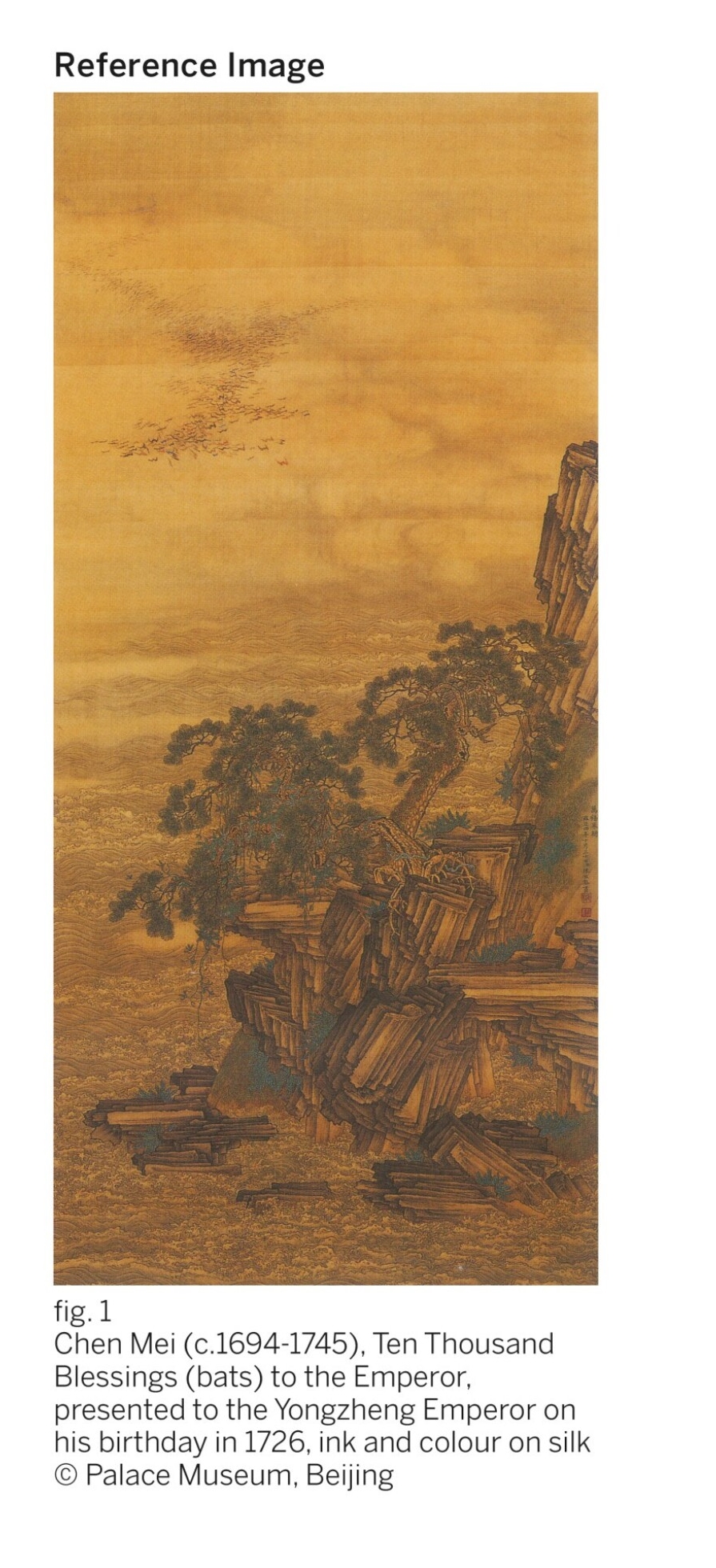
FIG. 1
CHEN MEI (C.1694-1745), TEN THOUSAND BLESSINGS (BATS) TO THE EMPEROR, PRESENTED TO THE YONGZHENG EMPEROR ON HIS BIRTHDAY IN 1726, INK AND COLOUR ON SILK
© PALACE MUSEUM, BEIJING
圖一
清雍正四年 陳枚《萬福來朝》軸 絹本設色 為雍正壽慶製
© 北京故宮博物院
Only a dozen comparable Yongzheng bowls of the peach-and-bat design are recorded. A pair was formerly in the collection of T.T. Tsui, published in The Tsui Museum of Art. Chinese Ceramics IV: Qing Dynasty, Hong Kong, 1995, pl. 155, and The Tsui Museum of Art, Hong Kong, 1991, pl. 119. The pair, now separated, was composed of a bowl that was sold in these rooms 14th November 1989, lot 315; at Christie’s Hong Kong, 26th April 1999, lot 539; in our London rooms, 16th May 2007, lot 104; and in these rooms, 7th April 2015, lot 112, together with another similar bowl. The other bowl of the Tsui pair came from the John F. Woodthorpe and C.M. Moncrieff collections and was sold three times in our London rooms, 9th December 1952, lot 140; 6th April 1954, lot 106; and 21st February 1961, lot 171.
A pair formerly in the Eisei Bunko, Tokyo, an art collection with its origins in the Nanboku-cho period (1336-92) formed by the Hosokawa family, one of the top daimyo clans in Japan, is now also separated: one bowl entered the Meiyintang collection and was sold in these rooms on 5th October 2011, lot 16, the other, still in the Eisei Bunko today, is illustrated in Sekai tōji zenshū/Ceramic Art of the World, vol. 12, Tokyo, 1956, col. pl. 11. Another pair in the Baur collection, Geneva, is illustrated in John Ayers, The Baur Collection Geneva: Chinese Ceramics, Geneva, 1968-74, vol. 4, nos A 594 and 595. A pair from the collections of Chen Rentao, Paul and Helen Bernat and T. Endo was sold in these rooms 15th November 1988, lot 44, and 29th April 1997, lot 401, and at Christie’s Hong Kong, 29th May 2007, lot 1374, and is illustrated in Sotheby’s. Thirty Years in Hong Kong, Hong Kong, 2003, pl. 326. This pair is now also separated and one was included in the Fiftieth Anniversary Exhibition: Twelve Chinese Masterworks, Eskenazi, London, 2010, cat. no. 11, while the other is in a private collection in Taiwan. Another pair was sold at Yamanaka & Co., London, 1938, and was included in their catalogue Chinese Ceramic Art, Bronze, Jade etc., no. 116, pl. 12 (illustrating one of the pair). Also known is one bowl from the Avery Brundage collection, in the Asian Art Museum of San Francisco, published in Terese Tse Bartholomew, Hidden Meanings in Chinese Art, Asian Art Museum, San Francisco, 2006, p. 204, pl. 7.44.1.
One other related pair of different proportions, from the Allen J. Mercher and John M. Crawford, Jr. collections, was sold at Parke-Bernet New York, 10th October 1957, lot 261, and in these rooms, 24th May 1978, lot 252. The peach-and-bat design was also used for enamelling porcelains at the imperial workshops in the Forbidden City in Beijing. Compare a pair of Yongzheng falangcai porcelain bowls in the National Palace Museum, Taipei, also painted with peach trees and five bats, but in a less pronounced design, exhibited in Painted Enamels of Qing Yongzheng Period (1723-1735), National Palace Museum, Taipei, 2013, pl. 82.
Other Yongzheng vessel forms with the peach-and-bat design are also very rare. Compare a Yongzheng covered box formerly in the Van Slyke and Meiyintang collections, sold in these rooms 8th April 2013, lot 3036, which appears to be the only example recorded (fig. 3). Examples of large dishes include one from the collection of J. Pierpont Morgan, sold in these rooms, 29th April 1997, lot 400, and one in the Palace Museum, Beijing, in China. The Three Emperors 1662-1795, Royal Academy of Arts, London, 2005-6, cat. no. 181. A group of smaller dishes is discussed in An Exhibition of Important Chinese Ceramics from the Robert Chang Collection, London, 1993, cat. no. 92; see also an example in the British Museum, London, illustrated in Oriental Ceramics, The World’s Great Collections, vol. 5, New York, 1981, col. pl. 67; and another dish in Denise Patry Leidy, Treasures of Asian Art. The Asia Society’s Mr. and Mrs. John D. Rockefeller 3rd Collection, New York, 1994, pl. 198. Other examples include a pair of Yongzheng dishes formerly in the collections of Barbara Hutton (1912-1979) and the British Rail Pension Fund, exhibited on loan at the Dallas Museum of Art, 1985-1988, illustrated in Sotheby’s Hong Kong Twenty Years, Hong Kong, 1993, p. 202, no. 276, and sold twice in our London rooms, 6th July 1971, lot 265, and 8th July 1974, lot 408, twice in our Hong Kong rooms, 29th November 1977, lot 160, and 16th May 1989, lot 88, and recently at Christie’s Hong Kong, 28th May 2014, lot 3319.
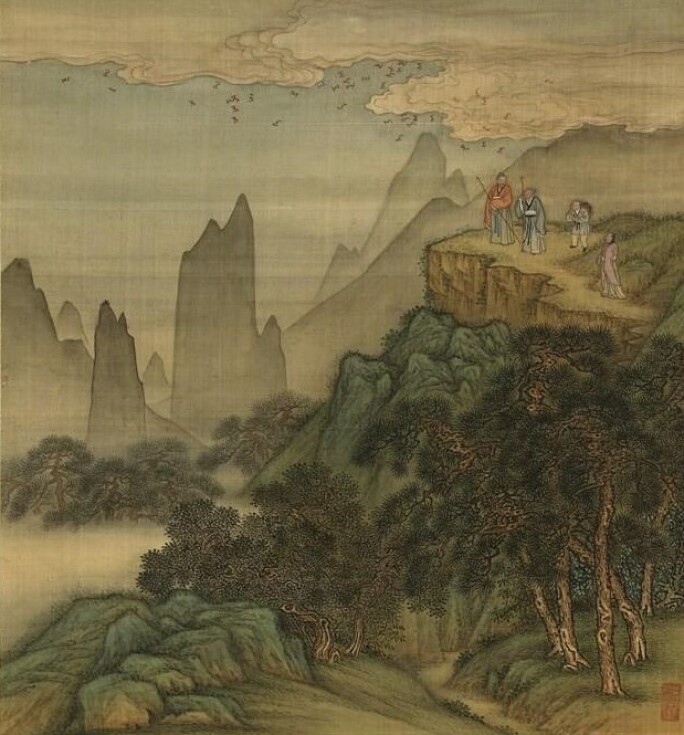
FIG. 2
JIN JIE, LONGEVITY AS HIGH AS THE MOUNTAINS, THE 5TH LEAF, QING DYNASTY, 18TH CENTURY
NATIONAL PALACE MUSEUM, TAIPEI
圖二
金玠《壽與山岳》冊 第五開:飛蝠滿天
台北國立故宮博物院
雍正御瓷福壽雙全圖盌,珍罕至極,此盌繪五壽桃於外壁,獨一無二,現知其他作例,均繪六桃,四桃於外,內壁雙桃。桃實不帶明顯暗紅輪廓線,為其另一特點,展現畫師高超技藝,及粉彩新技術帶來的突破。
五為吉利之數,中國藝術品常見五紅蝠紋裝飾,「紅蝠」音同「鴻福」,「五蝠」意謂「五福」,高壽、富貴、康寧、好德、善終。繪蝙蝠倒飛,「倒」音同「到」,為福到之意。
台北故宮藏雍正朝銅胎畫琺瑯粉橘地福壽盃及托,出自造辦處琺瑯作,紋飾與此對桃紋盌相類,展出於《雍正:清世宗文物大展》,台北,2009年,編號II-18。還有一銅胎畫琺瑯水盂,器身作連枝二桃實,綴蝙蝠紋,錄於《盛世華章》,英國皇家藝術學院,倫敦,2005-6年,編號295。
二幅雍正朝宮廷畫作,可見蝙蝠紋盛行一時,陳枚(約1694-1745年),《萬蝠來朝》,畫中天空滿佈飛蝠,雍正四年(1726年)大壽之時,貢呈帝王賀祝萬壽,《盛世華章》,前述出處,編號270(圖一)。另一出自十八世紀宮廷畫家金玠之手,描繪涯岸三名老者,雲間紅蝠紛飛,題為〈飛蝠滿天〉,意喻鴻福無盡,錄於《雍正:清世宗文物大展》,編號II-112(圖二)。
雍正御瓷長枝「長治」福壽紋盌,現知僅有約五對流傳,皆為名家所藏。徐展堂舊藏一對福壽雙全圖盌,錄於《徐氏藝術館:陶瓷IV.清代》,香港,1995年,圖版155,及《徐氏藝術館》,香港,1991年,圖版119。徐氏對盌其一出自香港蘇富比1989年11月14日,編號315、香港佳士得1999年4月26日,編號539、倫敦蘇富比2007年5月16日,編號104,又曾與另一福壽紋盌配對,同於香港蘇富比2015年4月7日售出,編號112。徐氏的另一盌則出自 John F. Woodthorpe 及 C.M. Moncrieff 珍藏,曾三度售於倫敦蘇富比,1952年12月9日,編號140、1954年4月6日,編號106、1961年2月21日,編號171。
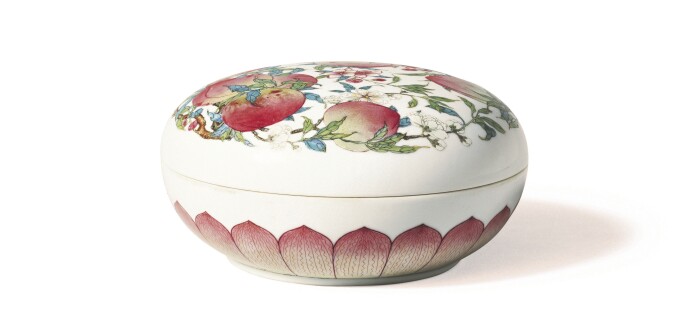
A FAMILLE-ROSE ‘PEACH’ BOX AND COVER, MARK AND PERIOD OF YONGZHENG, FORMERLY IN THE FREDERICK AND ANTOINETTE H. VAN SLYKE AND MEIYINTANG COLLECTIONS
SOTHEBY’S HONG KONG, 8TH APRIL 2013, LOT 3036.
圖三
清雍正 粉彩蟠桃獻壽圖圓蓋盒 《大清雍正年製》款 FREDERICK AND ANTOINETTE H. VAN SLYKE 伉儷與玫茵堂舊藏
香港蘇富比2013年4月8日,編號3036
另一對雍正粉彩福壽紋盌出自東京永青文庫珍藏,為日本貴族細川氏設立,存其家族自南北朝時代流傳下來的文物,此對現已拆散:一盌入玫茵堂收藏,後售於香港蘇富比2011年10月5日,編號 16;另一盌現仍存文庫,載於《世界陶磁全集》,卷12,東京,1956年,彩圖版11。日內瓦鮑爾典藏有另一對盌,錄於約翰.艾爾斯,《The Baur Collection Geneva: Chinese Ceramics》,日內瓦,1968-74年,卷4,編號 A 594、595。還有一對曾入陳仁濤、白納德伉儷、及 T. Endo 舊藏,於香港蘇富比二次售出,1988年11月15日,編號44,及1997年4月29日,編號401,後售於香港佳士得2007年5月29日,編號1374,並刊載於《香港蘇富比三十週年》,香港,2003年,圖版326。這對桃蝠紋盌現亦分散,其一錄於《Fiftieth Anniversary Exhibition: Twelve Chinese Masterworks》,埃斯卡納齊,倫敦,2010年,編號11,另一件則存於台灣私人收藏。另一對盌1938年由山中商會售出,載於《Chinese Ceramic Art, Bronze, Jade etc.》,編號 116,圖版12(此處僅刊出一盌)。布倫戴奇舊藏也見一盌,現存舊金山亞洲藝術博物館,載於謝瑞華,《中國吉祥圖案》,舊金山亞洲藝術博物館,三藩市,2006年,頁204,編號7.44.1。
一對近類,但器形比例略異瓷盌,出自 Allen J. Mercher、 John M. Crawford, Jr. 舊藏,售於紐約蘇富比1957年10月10日,編號261,1978年5月24日由香港蘇富比售出,編號252。清宮造辦處琺瑯作亦繪福壽紋於瓷上,可參考台北故宮藏一對雍正琺瑯彩盌,繪桃樹與五蝠,然構圖稍遜,展於《金成旭映:清雍正琺瑯彩瓷》,台北,2013年,圖版82。
雍正御瓷亦見其他桃紋器形,數目同是珍稀,一件先後為 Van Slyke 及玫茵堂珍藏的蟠桃獻壽圖圓蓋盒,2013年4月8日售於香港蘇富比,編號3036,為現知此類唯一之例(圖三)。桃紋大盤,如一例出自 J. Pierpont Morgan 舊藏曾售於香港蘇富比,1997年4月29日,編號400,另一盤藏北京故宮博物院,見《盛世華章》,前述出處,編號181。《雲海閣》重要中國瓷器.張宗憲珍藏展,倫敦佳士得,1993年,書中提及一批器形較小的桃紋盤,編號92。倫敦大英博物館也有一盤,刊錄於《東洋陶磁大觀》,卷5,紐約,1981年,彩圖67。另一例載於 Denise Patry Leidy,《Treasures of Asian Art. The Asia Society’s Mr. and Mrs. John D. Rockefeller 3rd Collection》,紐約,1994年,圖版198。其他還有先後為芭芭拉.赫頓及英國鐵路基金會珍藏的一對福壽紋盌,1985-88年借展達拉斯美術館,刊於《蘇富比香港二十周年》,香港,1993年,頁202,編號276,曾二度售於倫敦蘇富比,1971年7月6日,編號265,1974年7月8日,編號408,並二度由香港蘇富比拍出,1977年11月29日,編號160,1989年5月16日,編號88,最近一次售於香港佳士得,2014年5月28日,編號3319。
参考:苏富比
中國藝術品
28 十一月 2018 • 香港
Chinese Art /
Lot 740
A PAIR OF LARGE FAMILLE-ROSE ‘PEACH’ DISHES MARKS AND PERIOD OF GUANGXU
清光緒 粉彩過枝福壽雙全盤一對 《大清光緒年製》款
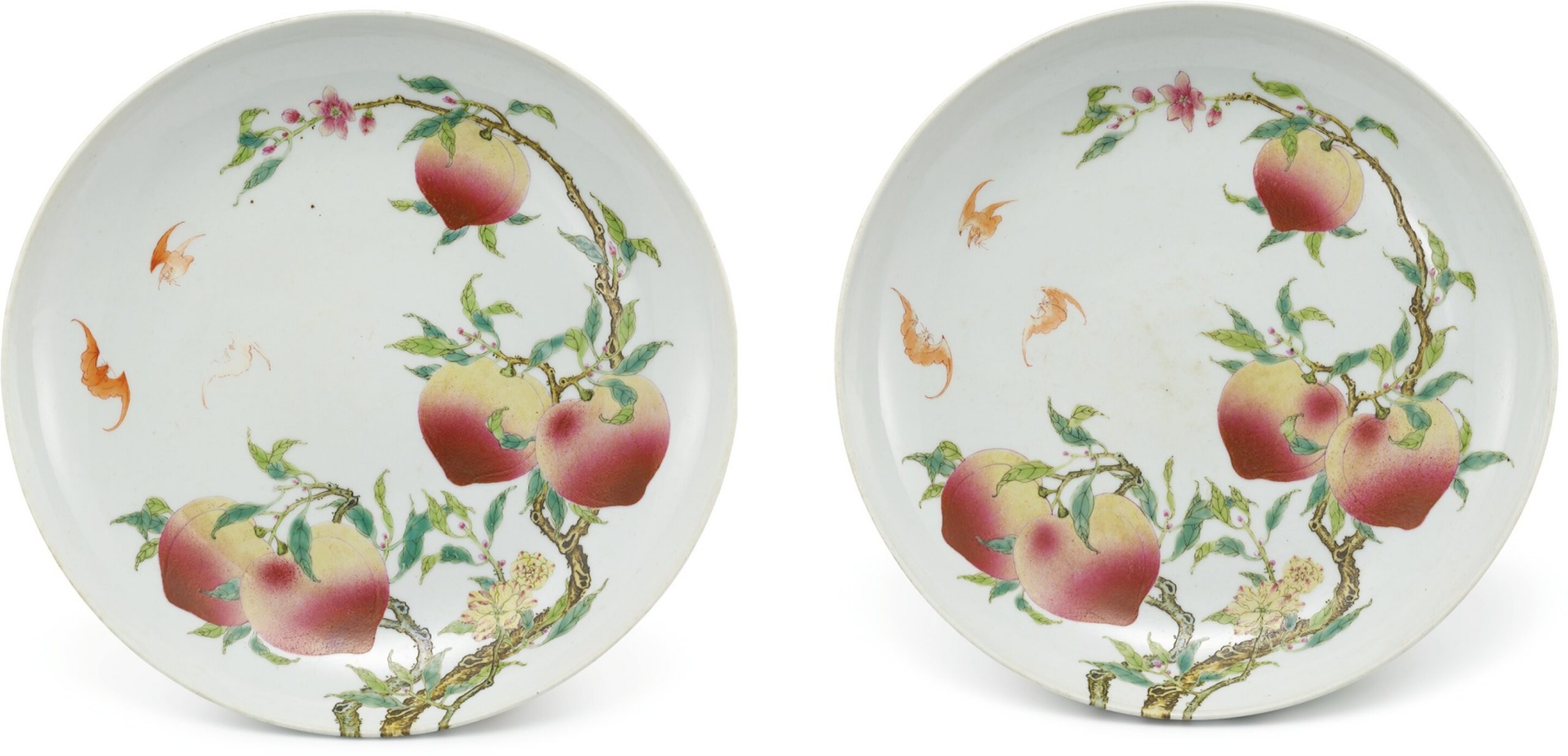
Estimate 100,000 – 150,000 HKD
Sold 125,000 HKD
Description
each painted with a gnarled peach branch bearing eight ripening fruits, the branches extending over the rim and onto the exterior, with five bats fluttering by
参考:苏富比
Important Chinese Art including Imperial Jades from the De An Tang Collection
13 October 2021 • 10:00 HKT • Hong Kong
3656
A superbly enamelled and possibly unique famille-rose ‘peach’ box and cover, Mark and period of Yongzheng
清雍正 粉彩蟠桃獻壽圖圓蓋盒 《大清雍正年製》款
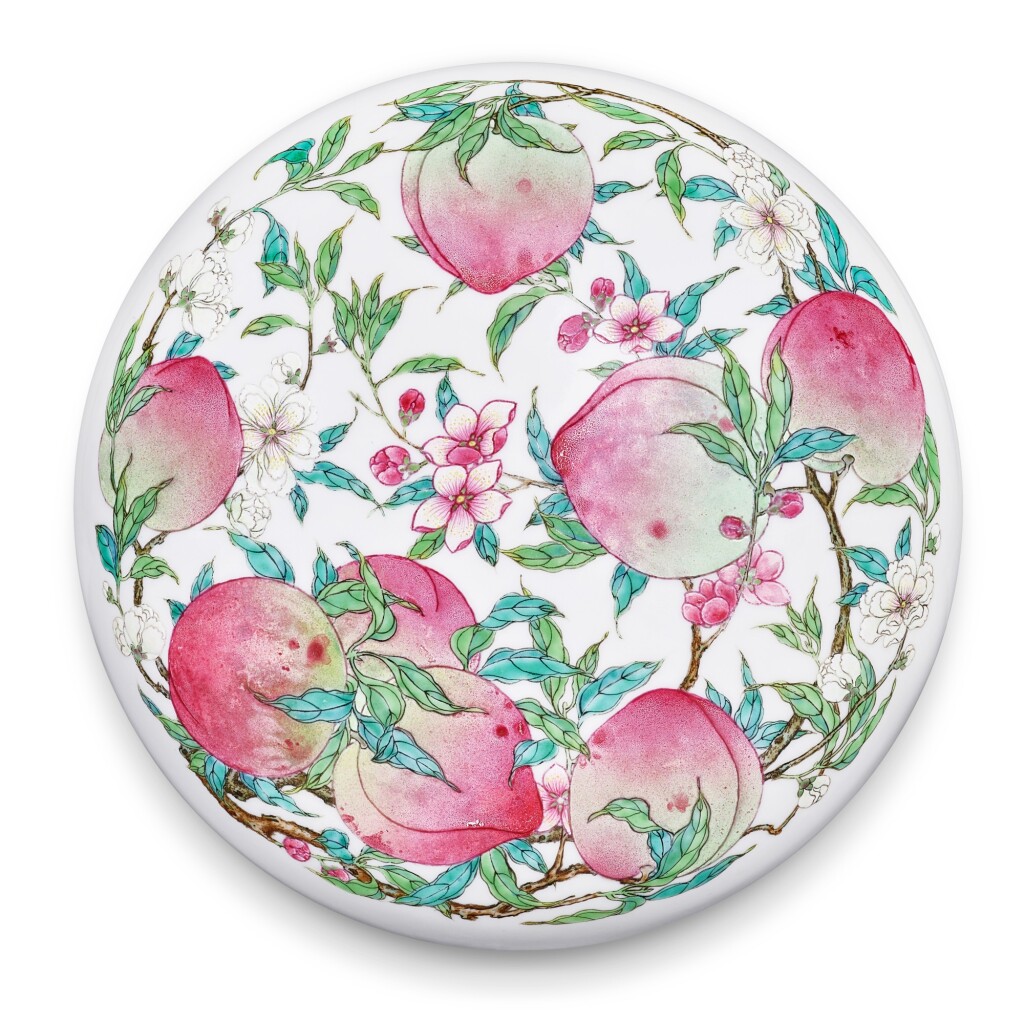
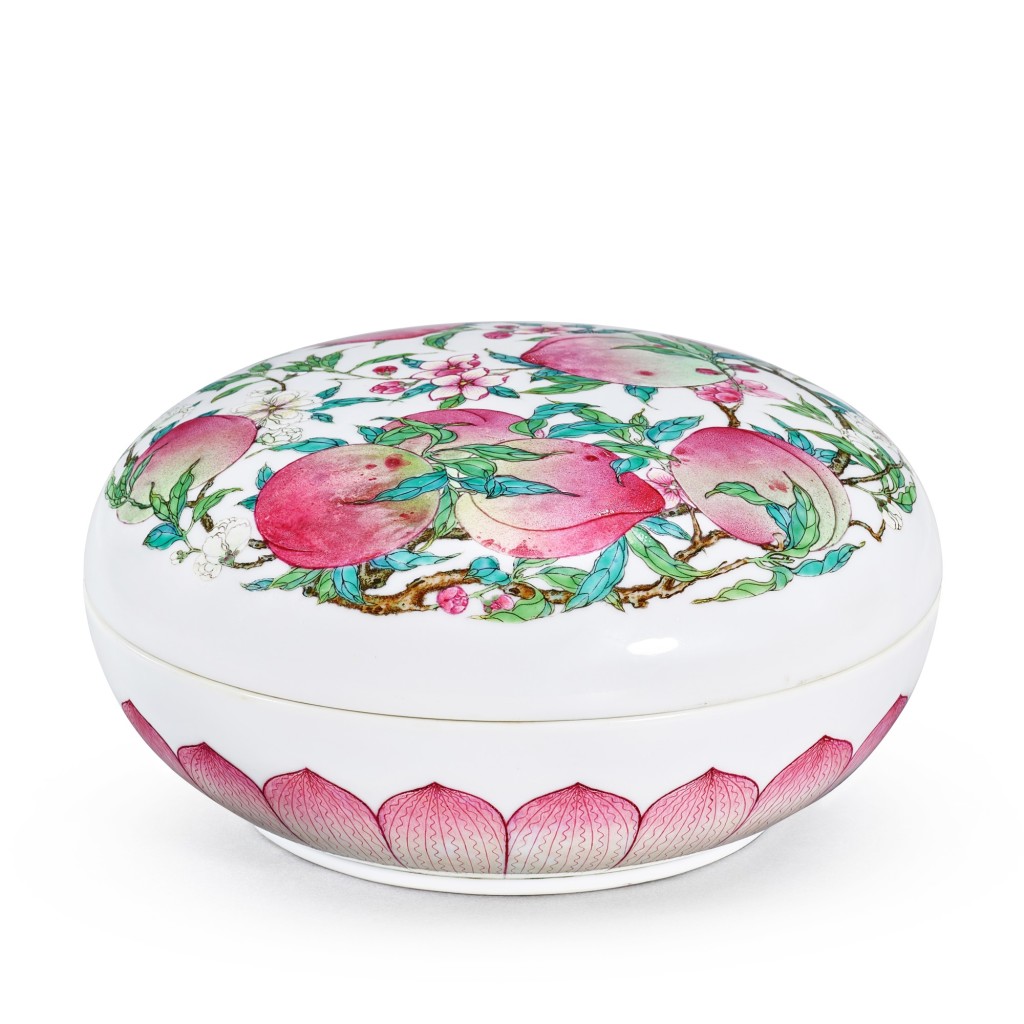
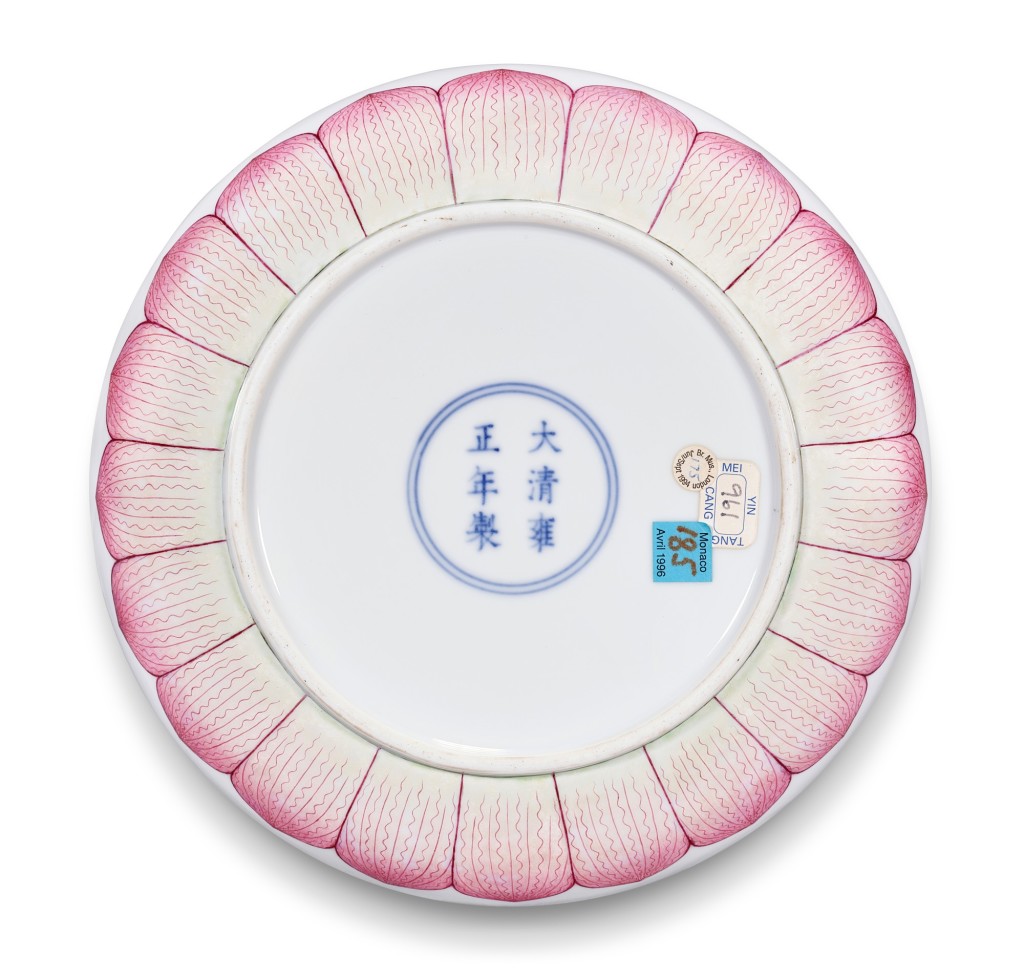
Premium Lots
Estimate: 35,000,000 – 45,000,000 HKD
Lot sold: 34,660,000 HKD
Description
Property of a Gentleman
A superbly enamelled and possibly unique famille-rose ‘peach’ box and cover
Mark and period of Yongzheng
士紳珍藏
清雍正 粉彩蟠桃獻壽圖圓蓋盒 《大清雍正年製》款
singularly beautiful, of thickly potted circular section and compressed rounded form, the cover sumptuously decorated with a large medallion of two varieties of peach, their branches entwined and bearing eight large brightly coloured fruits, small five-petalled rose-pink blossoms and double white ones, and leaves in several tones of green, the box painted with a skirt of lotus petals shaded in tones of rose pink to greenish yellow with crimson-pink veins, the base inscribed with a six-character mark within a double circle
19.2 cm
盒扁圓形,圓頂,圈足微斂,釉面光潔泛青,飾以粉彩,盒蓋上作蟠桃獻壽圖紋,桃枝花葉環擁八嫣紅壽桃瑞果,五瓣粉桃花,重瓣白桃花,點綴其間,黃彩點花蕊,盒底作蓮瓣紋,底青花雙圈書「大清雍正年製」六字雙行楷書款。
Condition Report
The box and cover are in excellent condition with the enamels very well preserved. There is a shallow approx. 2.5 cm retouched flake, with associated superficial hairlines and overpaint, to the inner lip of the box, which is likely a structural flaw from the firing, opposite a natural glaze gap, neither of which is visible on the exterior.
整體品相非常好,粉彩亦保存完好。盒之內唇沿有一約2.5公分小片剝落,外沿表面相應位置見相關之短沖線,或為窰燒過程導致的瑕疵,現已補釉。器內另外一面唇與盒相接處,有一細小縮釉。兩處瑕疵均未影響整體外觀。
Provenance
Collection of Frederick J. and Antoinette H. Van Slyke.
Sotheby’s New York, 31st May 1989, lot 211.
The Meiyintang Collection.
Sotheby’s Hong Kong, 7th April 2013, lot 3036.
Frederick J. and Antoinette H. Van Slyke 伉儷收藏
紐約蘇富比1989年5月31日,編號211
玫茵堂收藏
香港蘇富比2013年4月7日,編號3036
Literature
Regina Krahl, Chinese Ceramics from the Meiyintang Collection, London, 1994-2010, vol. 2, no. 961, and vol. 4, p. 285.
康蕊君,《玫茵堂中國陶瓷》,倫敦,1994-2010年,卷2,編號961,以及卷4,頁285
Exhibited
Chinese Ceramics from the Meiyintang Collection, The British Museum, London, 1994.
Evolution to Perfection. Chinese Ceramics from the Meiyintang Collection/Evolution vers la perfection. Céramiques de Chine de la Collection Meiyintang, Sporting d’Hiver, Monte Carlo, 1996, cat. no. 184.
《Chinese Ceramics from the Meiyintang Collection》,大英博物館,倫敦,1994年
《Evolution to Perfection. Chinese Ceramics from the Meiyintang Collection》,Sporting d’Hiver,蒙地卡羅,1996年,編號184
Catalogue Note
Eight Peaches for the Yongzheng Emperor
Regina Krahl
The Yongzheng Emperor (r. 1723-35) was a strong believer in portents of good fortune. Having ascended the throne under somewhat nebulous circumstances, the legality of his succession was persistently questioned, which made him more than any other Qing emperor receptive for auspicious symbolism. Court artists such as the Italian painter Giuseppe Castiglione (AD 1688-1766) presented him with paintings heralding good fortune, court artisans fashioned wish-granting ruyi sceptres in many different materials, and the emperor surrounded himself with portents of good luck.
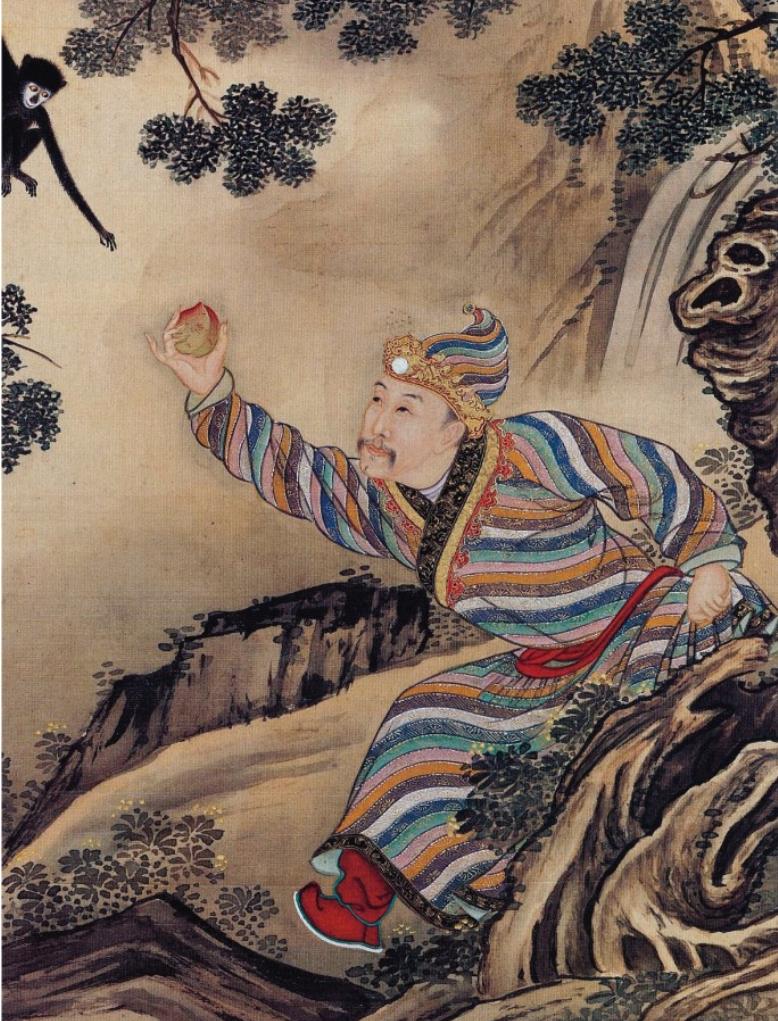
THE YONGZHENG EMPEROR WITH A PEACH OF IMMORTALITY, QING DYNASTY, YONGZHENG PERIOD
ALBUM LEAF, INK AND COLOURS ON SILK
© PALACE MUSEUM, BEIJING
圖一
清雍正 佚名《胤禛行樂圖‧東方朔偷桃》冊頁 設色絹本
© 北京故宮博物院
Peaches are perhaps China’s most auspicious fruit, having a long tradition as omens of longevity and harbingers of happiness, eight is a propitious number, and flowering peach branches are believed to ward off evil. Tao Qian (365-427) tells of a fisherman, who when following the source of a stream in a peach orchard – ‘Peach Blossom Spring’ – through a crevice in a rock, discovered a paradisiacal world. A peach orchard is also the setting for the oath of brotherhood sworn by the three main protagonists of the novel Romance of the Three Kingdoms. The peaches of immortality which are said to grow in the garden of Xi Wang Mu, the Queen Mother of the West, which flower only once every three thousand years and to take as long again for their fruit to ripen, are then offered in a banquet to the immortals. Dongfang Shuo, a witty and clever Han dynasty scholar (2nd/1st century BC), who became the hero of many legends is reported to have stolen peaches of immortality and thus to have become immortal. And the same feat is told of the scheming monkey Sun Wukong, hero of the novel Journey to the West, who accompanied the monk Xuanzang on his trip to India to obtain Buddhist sutras.
The Yongzheng Emperor was clearly attached to these stories, as he had himself painted as the recipient of such good luck in an album leaf that shows him in possession of a peach of immortality, possibly handed to him by a monkey hanging from a nearby tree (fig. 1). It is not surprising therefore that in the Yongzheng period the peach motif became one of the favourite motifs on porcelain.
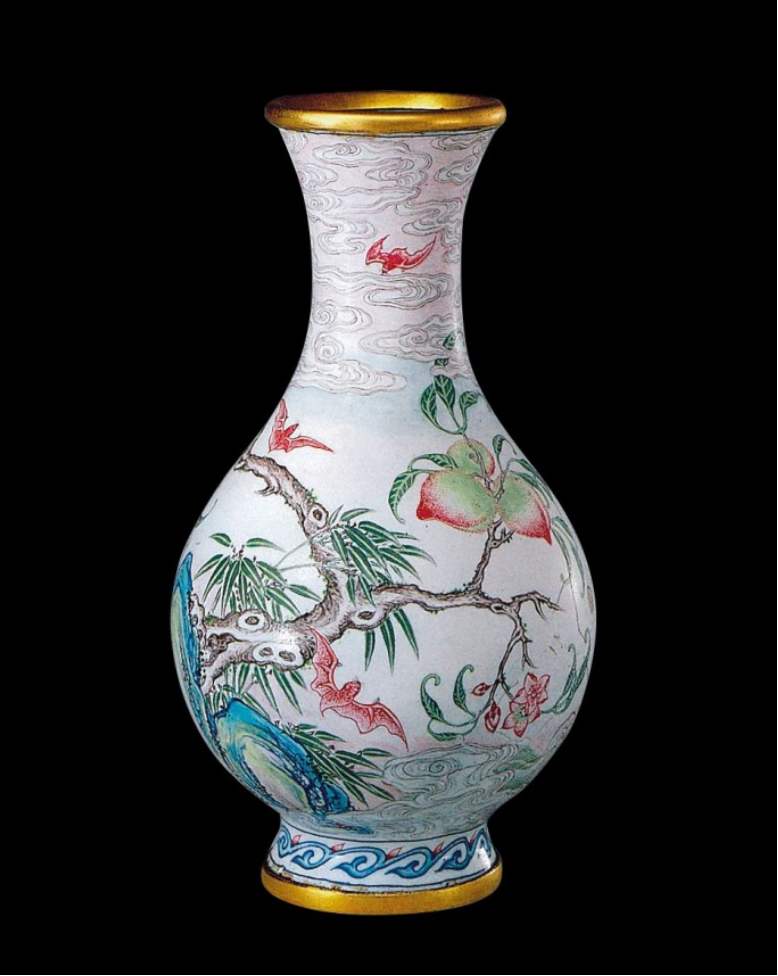
FIG. 2
A BEIJING PAINTED ENAMEL VASE WITH FRUITING AND FLOWERING PEACH TREE, MARK AND PERIOD OF KANGXI
圖二
清康熙 銅胎畫琺瑯桃蝠紋小瓶 《康熙御製》款
清宮舊藏
© 北京故宮博物院
A fruiting and flowering peach tree had in the Kangxi period already been used once in the imperial Enamelling Workshops of the Forbidden City to decorate a metal-bodied vase that remains in the Beijing palace collection (fig. 2). The transfer of the motif onto porcelain probably took place under the auspices of Tang Ying (AD 1682-1756), the Yongzheng Emperor’s trusted official who, after a spell in charge of the falangcai workshops at Beijing, was in 1726 sent to Jingdezhen to supervise the porcelain production there. The soft colouration of fruiting and flowering peach branches were a design tailor-made to show off the new fencai (famille rose) palette, which had just been introduced to Jingdezhen in the years preceding the Yongzheng reign. Its wide range of pastel shades from a fresh green over an opaque white to a pale rosé tone and eventually a deep pink was never otherwise displayed more impressively.
No other box of this peach design appears to be known and the rendering of its blossoms and fruits is of particularly high quality, done with great care and much colour variation. The box most likely represents an early product of the Yongzheng reign, done before the pattern became standardized to appear on the well-known vases of tianqiuping shape, bowls and smaller dishes, which have remained popular well into the Qianlong period. In its execution it may be compared to some other unique Yongzheng peach vessels, such as the famous vase from the collection of the Hon. Ogden R. Reid now in the Shanghai Museum, sold in these rooms, 7th May 2002, lot 532 (fig. 3); or a large and unusually painted Yongzheng peach dish from J. Pierpont Morgan, later also in the Van Slyke collection together with the present box, sold in these rooms 29th April 1997, lot 400 (fig. 4).
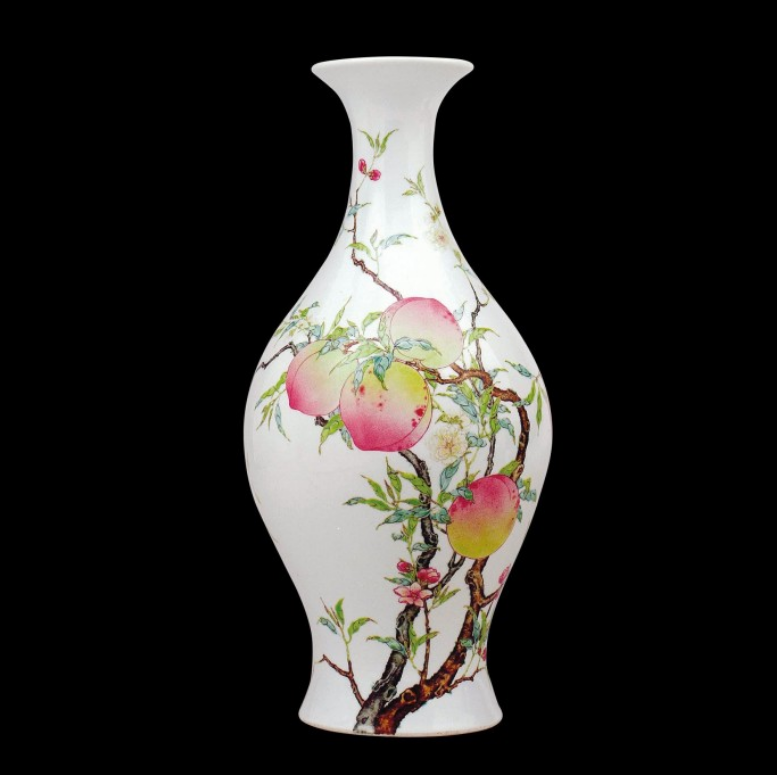
FIG. 3
A FAMILLE-ROSE VASE WITH FRUITING AND FLOWERING PEACH BRANCHES, MARK AND PERIOD OF YONGZHENG
SHANGHAI MUSEUM, FORMERLY IN THE COLLECTION OF THE HON OGDEN R. REID
SOTHEBY’S HONG KONG, 7 MAY 2002, LOT 532
圖三
清雍正 粉彩蝠桃福壽紋橄欖瓶 《大清雍正年製》款
HON OGDEN R. REID 舊藏 香港蘇富比2002年5月7日,編號532
現為上海博物館藏品
An early Yongzheng date for the present box is also suggested by the most unusual design of lotus petals on the lower part, which was equally adapted from copper-bodied enamel ware made in the Forbidden City’s falangcai workshops. It appears first on a bowl and stand (fig. 5), and on a covered bowl of the late Kangxi period, both remaining in the Beijing palace collection. This petal design was otherwise rarely used on imperial porcelains, but was taken up again in the Qianlong period on fine fencai gourd flasks with butterflies and flowers, an example of which is also in the Meiyintang collection (Krahl, op.cit., vol. 2, no. 962).
Imperial porcelain boxes with fencai designs of any kind are extremely rare. Only two others have been sold at auction, both of similar domed shape and size, but with the Yongzheng reign mark arranged in three vertical lines: one also from the Van Slyke and later the Goldschmidt and Robert Chang collections, with a bird, magnolia branch and peonies, was sold in our New York rooms, 31st May 1989, lot 210; in these rooms, 13th November 1990, lot 43, and at Christie’s Hong Kong, 2nd November 1999, lot 519; the other from the T.Y. Chao collection, with butterflies, hibiscus and morning glories, was sold in these rooms 18th November 1986, lot 129.
Frederick J. Van Slyke (died 1968) of Baltimore, Maryland, assembled a fabled collection of Chinese as well as European porcelains, of which some pieces are in the Walters Art Museum, Baltimore, and some in the Baltimore Museum of Art.
八桃獻雍正
康蕊君
雍正皇帝奪嫡即位,朝野眾說紛紜,胤禛因此較歷代清帝更篤信祥瑞之說,常近禎祺之象,以辟謠傳。宮廷畫師如郎世寧(1688-1766年)等遂為天子繪祥瑞圖畫,藝匠則以不同材質巧製如意,寄語稱心如意,以悅君心。
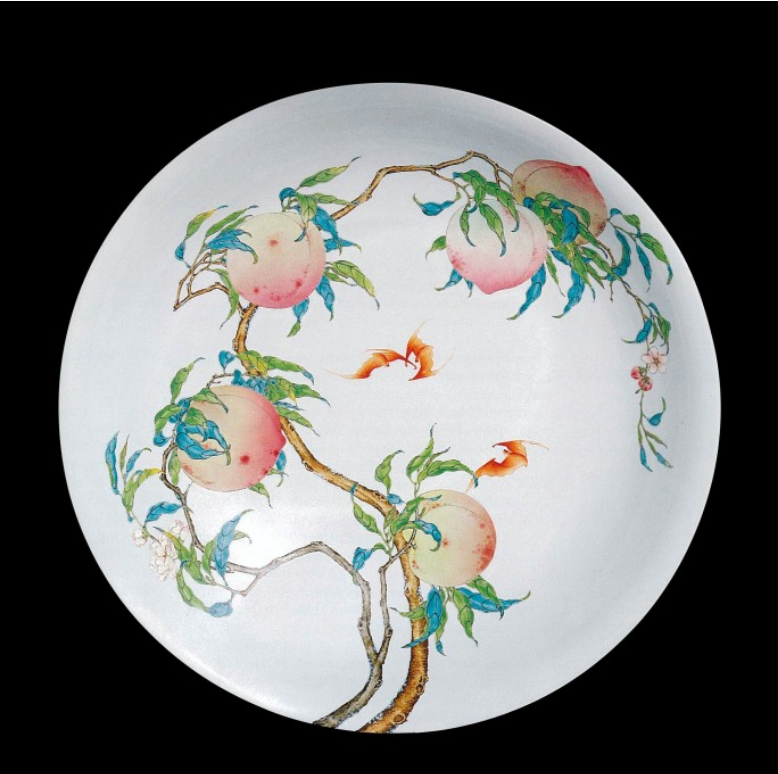
FIG. 4
A FAMILLE-ROSE DISH WITH FRUITING AND FLOWERING PEACH BRANCHES, MARK AND PERIOD OF YONGZHENG
FORMERLY IN THE COLLECTIONS OF J.PIERPONT MORGAN AND FREDERICK J. AND ANTOINETTE H. VAN SLYKE
SOTHEBY’S HONG KONG, 29 APRIL 1997, LOT 400
圖四
清雍正 粉彩蟠桃獻瑞盤 《大清雍正年製》款
J. PIERPONT MORGAN、FREDERICK J. 及 ANTOINETTE H. VAN SLYKE 舊藏
香港蘇富比1997年4月29日,編號400
自古伊始,桃乃吉祥長壽之徵,桃枝又能辟邪;而八則為吉利之數。史上有不少與桃相關的典故。陶潛(365-427)在《桃花源》序中述,一名漁人沿溪前行,入桃花林,通山中小洞,達世外仙境。《三國演義》中,劉備、關羽與張飛三英雄,於桃園結義。傳說西王母種有仙桃,「三千陽春始一花」,果實要待三千年才成熟,用以宴請眾仙。西漢有傳奇文人東方朔,機智詼諧,據說曾盜桃,吃而成仙。《西遊記》中,機靈的孫悟空也曾盜蟠桃,後受罰隨唐僧玄奘遠到印度取佛經。
《胤禛行樂圖‧東方朔偷桃》冊頁,繪雍正手執仙桃,似為靈猴剛從樹上摘下進獻(圖一)。世宗定必對這些典故瞭如指掌,因此雍正一朝,壽桃成御瓷常見紋飾之一,也屬意料中事。
早於康熙之時,清宮琺瑯作已有繪蟠桃花果之器,見故宮舊藏銅胎畫琺瑯桃蝠紋小瓶,器身繪桃樹,飾桃花果實(圖二)。瓷胎繪圖之作,或由雍正寵臣唐英(1682-1756)監督。唐英先事於北京清宮琺瑯作,1726 年被調往景德鎮,監督御瓷製作。本器上繪桃枝花果,展示新創粉彩,渲染淡雅。康熙晚期,景德鎮始創粉彩,顏色多樣,淡綠柔和,桃紅清雅,其黛紫之艷,更是前所未見。
此蓋盒上繪蟠桃瑞果,花繁葉茂,枝幹蜿蜒。敷彩濃淡有致,描繪入微,如此精緻之品,獨一無二。本蓋盒應繪於雍正初年,因此圖飾較流暢奔放。及後蟠桃紋飾漸趨形式化,屢見粉彩蟠桃天球瓶、盌、小盤等器,至乾隆年間仍續繪製。除本品外,尚有其他雍正瓷器,巧繪蟠桃紋,可資比對,如著名的粉彩蝠桃福壽紋橄欖瓶,乃 Hon Ogden R. Reid 舊藏,售於香港蘇富比2002年5月7日,編號532,現藏於上海博物館(圖三);J. Pierpont Morgan 舊藏雍正繪蟠桃紋大盤,描繪細膩,後與本品一樣收歸 Van Slyke 氏典藏,該器再售於香港蘇富比1997年4月29日,編號400(圖四)。
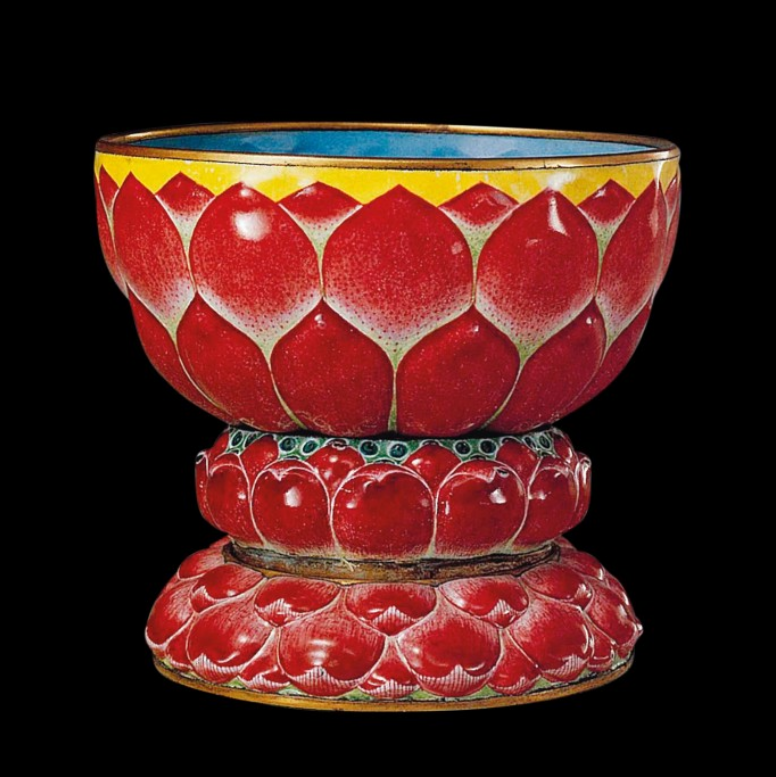
FIG. 5
A BEIJING PAINTED ENAMEL BOWL AND STAND WITH LOTUS PETALS, MARK AND PERIOD OF KANGXI
© PALACE MUSEUM, BEIJING
圖五
清康熙 銅胎畫琺瑯蓮花式盌 《康熙御製》款
清宮舊藏
© 北京故宮博物院
盒身下方繪蓮瓣紋,似與造辦處琺瑯作產製的銅胎琺瑯器同出一徹,屬雍正早期圖飾,極為罕見。蓮瓣紋飾似乎首見於清康熙銅胎畫琺瑯蓮花式盌(圖五),及另一件製於康熙晚期的蓋盌,均藏於北京故宮博物院。除本品外,蓮瓣紋鮮見於雍正御製瓷器。及至乾隆一朝,有粉彩花蝶紋葫蘆瓶,上飾相類蓮瓣紋,例子可見於玫茵堂藏器,參考康蕊君,《玫茵堂中國陶瓷》,倫敦,1994-2010年,卷2,編號962。
御製粉彩蓋盒,珍罕至極。拍賣市場迄今只見二例,器形大小均與本品相仿,蓋拱頂,惟年款分三行書:其中一個蓋盒繪鳥,並飾辛夷牡丹,同為 Van Slyke 氏舊藏,售於紐約蘇富比1989年5月31日,編號210,後屬 Goldschmidt 藏品,售於香港蘇富比1990年11月13日,編號43,曾由張宗憲珍藏,再售於香港佳士得1999年11月2日,編號519;另一個粉彩蓋盒則屬趙從衍舊藏,器上繪芙蓉牽牛,彩蝶翩翩,售於香港蘇富比1986年11月18日,編號129。
Frederick J. Van Slyke(1968年卒),居美國馬里蘭州巴爾的摩,典藏中國及歐洲瓷器,傳誦一時,部份藏品現收於巴爾的摩華特斯美術館,以及巴爾的摩藝術博物館。
参考: 佳士得
28 11月 2017| 現場拍賣 16072
詹姆斯.桑頓醫生珍藏中國重要瓷器
拍品 2808
A FINE AND EXCEPTIONAL FAMILLE ROSE ‘PEACH’ DISH
清雍正 御製粉彩過枝福壽雙全盤 雙方框六字楷書款
YONGZHENG SIX-CHARACTER MARK WITHIN DOUBLE SQUARE AND OF THE PERIOD (1723-1735)




成交價 HKD 13,900,000
估價 HKD 7,000,000 – HKD 9,000,000
清雍正 御製粉彩過枝福壽雙全盤 雙方框六字楷書款
8 1/16 in. (20.5 cm.) diam.
來源
賀璧理舊藏(1848-1939)
賀璧理中國瓷器珍藏,紐約安德森藝廊,1925年1月30-31日,拍品193號(一對之一)
Frank Caro,盧芹齋繼承人,紐約,1960年代
展覽
德州聖安東尼奧美術館,1984-2017年
此盤原為一對,另一件現藏克里夫蘭美術館,典藏編號1930.639。
狀況報告
謹請注意,所有拍品均按「現狀」拍賣,閣下或閣下的專業顧問應於拍賣前親自查看拍品以評鑒拍品之狀況。
– 整體品相良好
– 盤內一桃之釉面有些極輕微的磨損
– 足緣有些微磕,應為製造時所致
拍品專文
此類五蝠八桃盤的款識有雙方框六字款及雙圈框六字款兩種。尺寸分四種,此盤位居第二,近似例參考:南京博物院一例(口徑21公分);大英博物館一例(口徑20.6公分);John M. Crawford、區百齡及張宗憲先後遞藏一例(口徑20.9公分),2003年10月27日於香港佳士得拍賣,拍品665號;芭芭拉.赫頓舊藏一例(口徑21公分),2014年5月28日於香港佳士得拍賣,拍品2915號;以及一對於2014年5月28日於香港佳士得拍賣,拍品3319號(口徑20.7公分)。
北京故宮博物院及倫敦維多利亞和阿爾伯特博物館各藏一例尺寸最大的五蝠八桃盤(口徑50.6公分、口徑50.5公分),皆書雙圈款,與較小者書雙方框款有所區別。
這種從器內延伸至器外的畫面稱為「過枝花」,此畫法興起於雍正時期。此盤紋飾有「福壽雙全」、「洪福齊天」及「五福臨門」之祥瑞寓意,應為皇帝萬壽節而燒造。
参考: 佳士得
30 5月 2017 | 現場拍賣 14612
中國宮廷御製藝術精品/ 重要中國瓷器及工藝精品
拍品 3028
A RARE PAIR OF FAMILLE ROSE ‘FRUIT’ DISHES
THE PROPERTY OF A HONG KONG PRIVATE COLLECTOR
清雍正 粉彩果紋盤一對 雙圈六字楷書款
YONGZHENG SIX-CHARACTER MARKS IN UNDERGLAZE BLUE WITHIN DOUBLE CIRCLES AND OF THE PERIOD (1723-1735)
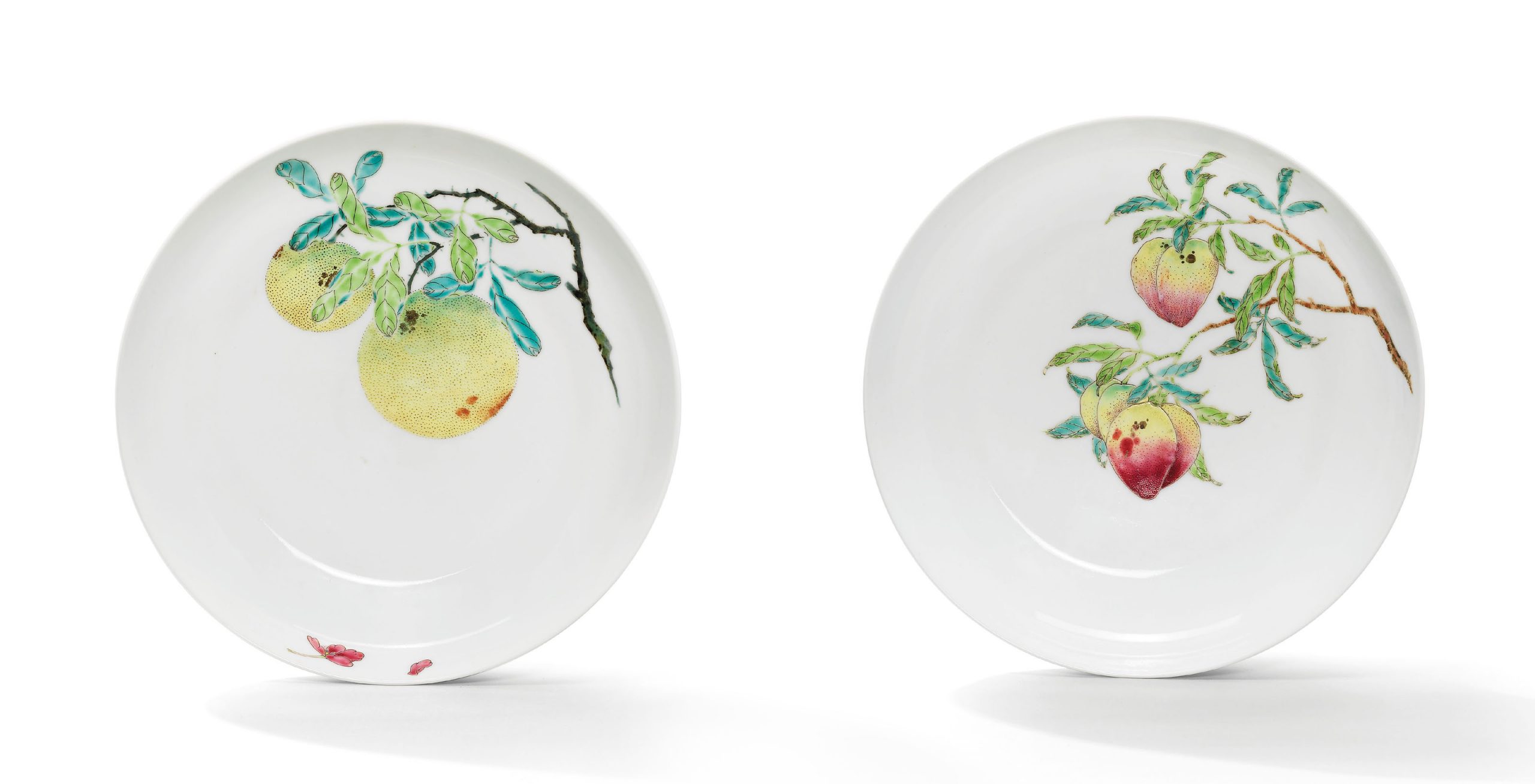
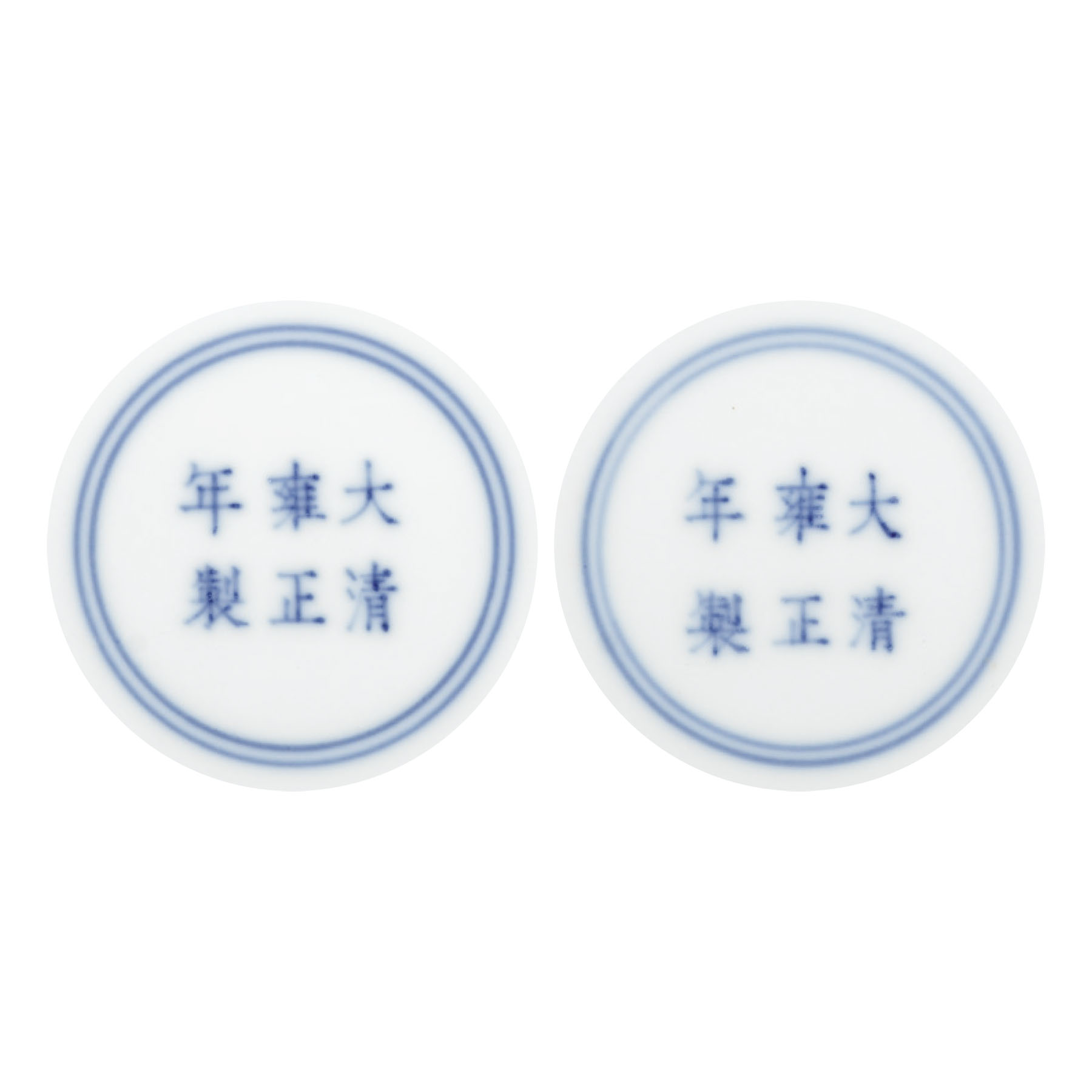
成交價 HKD 2,940,000
估價 HKD 2,400,000 – HKD 3,500,000
清雍正 粉彩果紋盤一對 雙圈六字楷書款
YONGZHENG SIX-CHARACTER MARKS IN UNDERGLAZE BLUE WITHIN DOUBLE CIRCLES AND OF THE PERIOD (1723-1735)
7 7/8 in. (20 cm.) diam.
來源
倫敦蘇富比,2008 年5 月14 日,拍品706 號
狀況報告
謹請注意,所有拍品均按「現狀」拍賣,閣下或閣下的專業顧問應於拍賣前親自查看拍品以評鑑拍品之狀況
桃紋盤:
– 內壁兩條沖,每條長約2公分
– 略有剝彩,尤見於葉子綠彩部分。
柚紋盤:
– 整體品相良好,惟略有小剝彩及盤心輕微磨傷。
拍品專文
桃為五果之首,在神話與傳說中,桃子更是神仙享用的果實。若有幸得嘗王母娘娘的蟠桃,食小桃則「成仙得道,體健身輕」,食大桃則能「與天地齊壽,與日月同庚」。正因如此,桃子亦被稱為仙桃或壽桃。而傳統信仰的福祿壽三星中象徵長生不老的壽星更手執一桃,印證桃子在中國的特殊地位。而柚或柚子,因與「有」、「有子」及「佑」諧音,則有「早生貴子」和保佑家人平安的美好寓意。
参考:佳士得
30 5月 2010| 現場拍賣 2811
中國宮廷御製藝術精品、重要中國瓷器及工藝精品
拍品 1880 清雍正 粉彩過枝福壽雙全盤一對 雙方框雙行六字楷書款
A SUPERB RARE PAIR OF FAMILLE ROSE ‘PEACH’ DISHES
THE PROPERTY OF A GENTLEMAN

成交價HKD 16,340,000
估價 HKD 8,000,000 – HKD 10,000,000
拍品專文
清雍正 粉彩過枝福壽雙全盤一對 雙方框雙行六字楷書款
A SUPERB RARE PAIR OF FAMILLE ROSE ‘PEACH’ DISHES
盤敞口,弧壁,圈足。盤心繪一株蒼茂的桃樹沿盤壁蜿蜒伸展至外壁,枝上有盛開的桃花和花蕾,八顆嫣紅的桃實,五顆在盤內,三顆在盤外,渾然連成一體。五隻蝙蝠翩翩飛舞其中。底足青花雙方框內書「大清雍正年製」楷書款。
此對盤形態嬌小,造型端莊秀雅。運用過枝花的手法在白底上從器外壁起畫,經過口沿,延續到器內壁,繪八桃五蝠,取「洪福齊天」、「福壽雙全」之意。此畫法興起於雍正時期,一直影響及道光。粉彩始創於康熙,到了雍正朝,無論在造型、施釉和彩繪方面,都得到了空前的發展,此器正是其中一例。雍正時期一般繪八桃,乾隆時多繪九桃,故有「雍八乾九」之說。
雍正時期粉彩繪八桃、五蝠的瓷盤以尺寸來看可歸為四類,如此器口徑只有13.4公分的,為同類中最小的一種,是目前傳世品中的孤品。
此器來源有緒,原為美國著名藏家BarbaraHutton的私人珍藏,後由趙從衍收藏,1987年5月19日於香港蘇富比趙從衍基金會專拍中拍賣,拍品312號。在由趙從衍收藏前,此器於1971年7月6日於倫敦蘇富比拍賣,拍品249號,1978年11月29日再次於香蘇富比拍賣,拍品315號。
來源
Barbara Hutton
Previously sold at Sotheby’s London, 6 July 1971, lot 249
T.Y. Chao Private and Family Trust Collections of Important Chinese Ceramics and Jade Carvings: Part II, sold at Sotheby’s Hong Kong, 19 May 1987, lot 312
狀況報告
– Both dishes are well enamelled and in overall good condition with exception of a shallow 1.3 cm. long x 0.4 cm. high surface chip restored to the outside of the footrim of one dish.
– The other dish with some minor wear and scratches to the interior
– The enamels are generally well preserved.
拍品專文
The present pair of dishes belongs to a group that are similarly decorated with a total of eight peaches growing flowering branches and accompanied by five bats, forming the auspicious wufu, from the Yongzheng period. Some of these dishes bear a six-character reign mark within double-squares as in the case of the present examples, or on others the marks appear within double-circles.
Peach dishes appear in four differing sizes, the present dishes are the smallest among the group (13.4 cm. diam.) and these are the only examples of this measurement. The next size is the slightly larger (15.8 cm. diam.) example from the Tianminlou Foundation, illustrated in Chinese Porcelain, The S.C. Ko Tianminlou Collection, Hong Kong, 1987, vol. 1, no. 104; and this dish is also unique in its size. Third size measures approximately 20 cm. in diameter and examples of these include the dish in the Nanjing Museum, illustrated by P. Lam in Qing Imperial Porcelain, Chinese University of Hong Kong, 1995, no. 62 (21 cm.); a dish in the British Museum collection, illustrated in Oriental Ceramics, The World’s Great Collections, vol. 5, Kodansha series, 1981, no. 226 (20.6 cm.); and from the John M. Crawford, Au Bank Ling and Robert Chang collections, sold at Christie’s Hong Kong, 27 October 2003, lot 665 (20.9 cm.). For examples of larger dishes of this pattern, see Far Eastern Ceramics in the Victoria and Albert Museum, Kodansha series, 1980, col. pl. 63 (50.5 cm.); and in the Beijing Palace Museum, illustrated in Porcelains with Cloisonne Enamel Decoration and Famille Rose Decoration, the Complete Collection of Treasures of the Palace Museum, Commercial Press, 1999, p. 66, no. 56. The reign marks of the larger dishes are written within double-circles.
It is characteristic of Yongzheng porcelains with decoration of fruiting and flowering branches that the painter starts the design at the exterior foot of the dish and then continues it over the rim and into the interior. This device is known in Chinese as guozhihua, and on dishes with this peach and bat motif, the exterior and interior may be ‘read’ together to form an overall significance of the design. Decoration of this type provides a design challenge in order to obtain a harmoniously balanced result. The current dishes are particularly successful in this regard. The decorator has made full use of the contrast between the white body and the vibrant enamels.
It is believed by many scholars that this particular design was applied to vessels made for the celebration of imperial birthdays. The composition of eight peaches and five bats is very auspicious. The eight peaches symbolise extended long life through their association Shoulao, the Star God of the Longevity, and also through association with the peaches of longevity grown in the orchard of the Queen Mother of the West. The five red bats provide rebuses both for good fortune and for the Five Blessings of longevity, health, love of virtue and a peaceful death. This decorative pattern is also known as guoqiangzhi that suggests the sound of changzhi, meaning long peace under good government, which would provide a compliment to the emperor and a wish for his reign to be a long one.
参考:佳士得
2021年 6月 11日 | 網上拍賣 20202
古今網上拍賣-中國藝術3213
拍品 3213
亞洲家族私人珍藏
清雍正 粉彩過枝福壽雙全盤 雙圈六字楷書款 粉彩或為後加
YONGZHENG SIX-CHARACTER MARK IN UNDERGLAZE BLUE WITHIN A DOUBLE CIRCLE AND OF THE PERIOD (1723-1735), THE ENAMELS POSSIBLY LATER
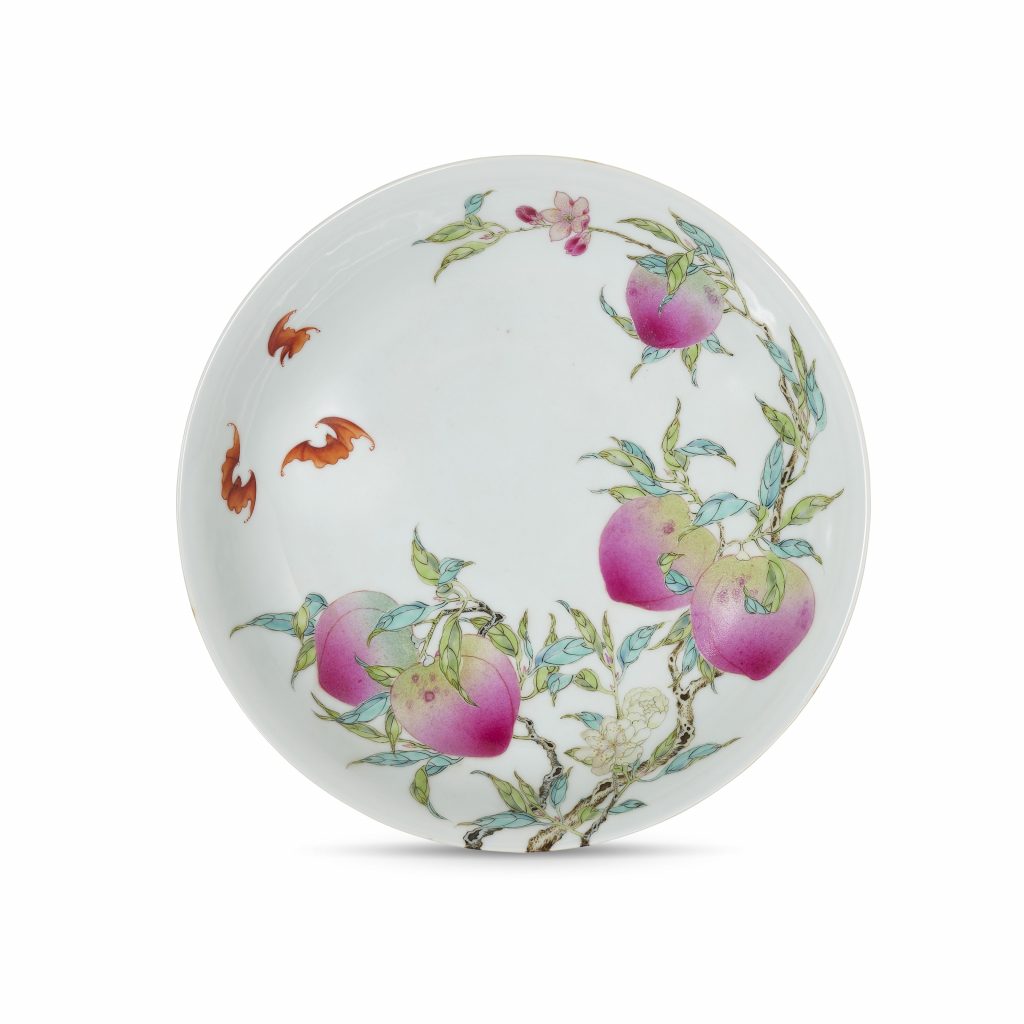
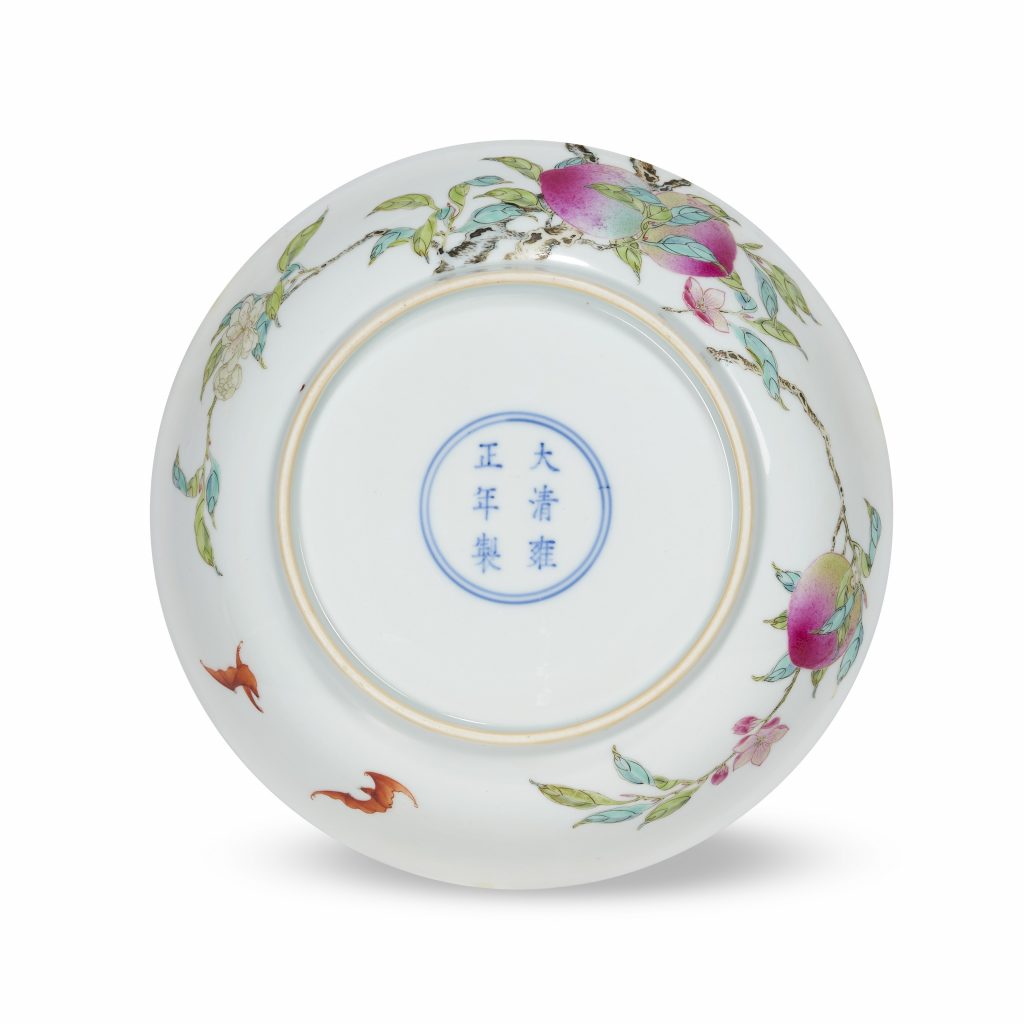
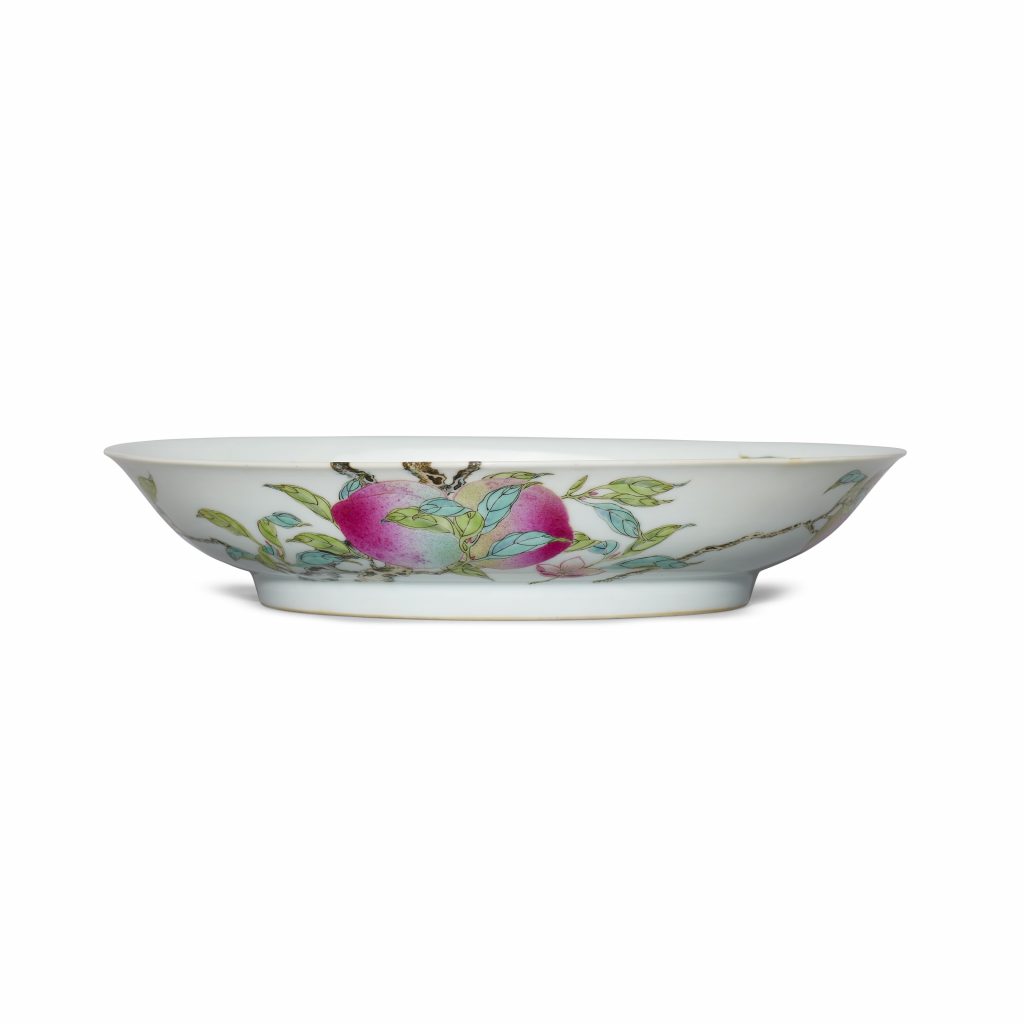
成交價 HKD 3,750,000
估價 HKD 300,000 – HKD 500,000
清雍正 粉彩過枝福壽雙全盤 雙圈六字楷書款 粉彩或為後加
YONGZHENG SIX-CHARACTER MARK IN UNDERGLAZE BLUE WITHIN A DOUBLE CIRCLE AND OF THE PERIOD (1723-1735), THE ENAMELS POSSIBLY LATER
詳情
盤心應刻有暗花八吉祥紋,惟僅有法輪及法螺依稀可見,其他被覆蓋於粉彩紋飾之下。
81⁄8 in. (20.8 cm.) diam., box
請注意,此拍品為私人藏家所有。
來源
香港家族珍藏,建立於1970 年代末至1990 年代初
狀況報告
拍品的狀況可能存在極大差異,而由於其性質使然,拍品難以處於完美無瑕的狀態。拍品均以拍賣時的狀況出售。
謹請注意,所有拍品均按「現狀」拍賣,閣下或閣下的專業顧問應于拍賣前親自查看拍品以評鑒拍品之狀況。
-口沿有三處修補最大一處約9公分,並經修復及補色
参考:佳士得
27 5月 2014| 現場拍賣 3320
紫闕琳瑯 – 美國精粹收藏珍品
拍品 2915
AN EXCEPTIONAL IMPERIAL FAMILLE ROSE ‘PEACH’ DISH
清雍正 粉彩過枝福壽雙全盤 雙方框六字楷書款
YONGZHENG SIX-CHARACTER MARK WITHIN DOUBLE SQUARES AND OF THE PERIOD (1723-1735)





成交價 HKD 5,080,000
估價 HKD 5,000,000 – HKD 7,000,000
細節
盤侈口,淺弧壁,圈足。器面內外飾粉彩過枝福壽紋,兩株桃幹自外壁舒展延伸至盤心,枝上桃花綻開、八枚蟠桃肥碩嬌豔,另繪五隻礬紅蝙蝠翩翩飛舞。底雙方框內書「大清雍正年製」楷書款。
來源
芭芭拉.赫頓(1912-1979)珍藏 倫敦蘇富比,1971 年7 月6 日,拍品267 號 倫敦蘇富比,2004 年6 月9 日,拍品218 號
狀況報告
– There are two chips to the mouth rim, the larger measuring approx. 2.9 cm. wide x 1.8 cm. deep, which has two associated hairlines, with the longer measuring approx. 3.5 cm. long.
– The enamels are very well preserved with the exception of some minor wear and losses.
拍品專文
此盤紋飾有「福壽雙全」、「洪福齊天」及「五福 臨門」之祥瑞寓意,應為皇帝萬壽節而燒造。據《清 檔》記載,乾隆三年六月二十五日,乾隆皇帝欽命 以雍正「五彩過牆福壽七寸盤」為樣本,燒造乾隆 朝同類品種。海外知名公私營收藏均不乏近似例, 如一件藏上海博物館,見1996 年上海出版《上海博 物館中國古代陶瓷館》,圖版83 號;一件藏香港中 文大學文物館,見1995 年香港出版《清瓷萃珍》, 圖版62 號;一件藏大英博物館,見1982 年京都出版 《東洋陶磁大觀》,第五冊,圖版226 號;一件為天 民樓珍藏,載於1987 年香港出版《天民樓藏瓷》, 圖版104 號。 亦見近似例經拍賣:一件先後經John M. Crawford Jr.、 區百齡及張宗憲珍藏,2003 年10 月27 日於香港佳士 得拍賣,拍品665 號;一件2002 年10 月28 日於香港 佳士得拍賣,拍品729 號;一件經C. Oswald Liddell、 Charles Russell 及古樂軒珍藏,1993 年6 月8 日於倫敦 蘇富比拍賣,拍品91 號;一件為英國鐵路基金會舊 藏,1989 年5 月16 日於香港蘇富比拍賣,拍品88 號。 乾隆朝亦有燒造,一例經盧芹齋及玫茵堂珍藏,2005 年11 月28 日於香港佳士得拍賣,拍品1346 號,2012 年4 月4 日再於香港蘇富比拍賣,拍品27 號。
参考:佳士得
27 5月 2014 | 現場拍賣 3322
中國宮廷御製藝術精品
拍品 3319 清雍正 粉彩桃纹盘 对
THE PROPERTY OF A GENTLEMAN
A MAGNIFICENT AND FINE PAIR OF IMPERIAL FAMILLE ROSE PEACH DISHES
YONGZHENG SIX-CHARACTER MARKS WITHIN DOUBLE SQUARES AND OF THE PERIOD (1723-1735)
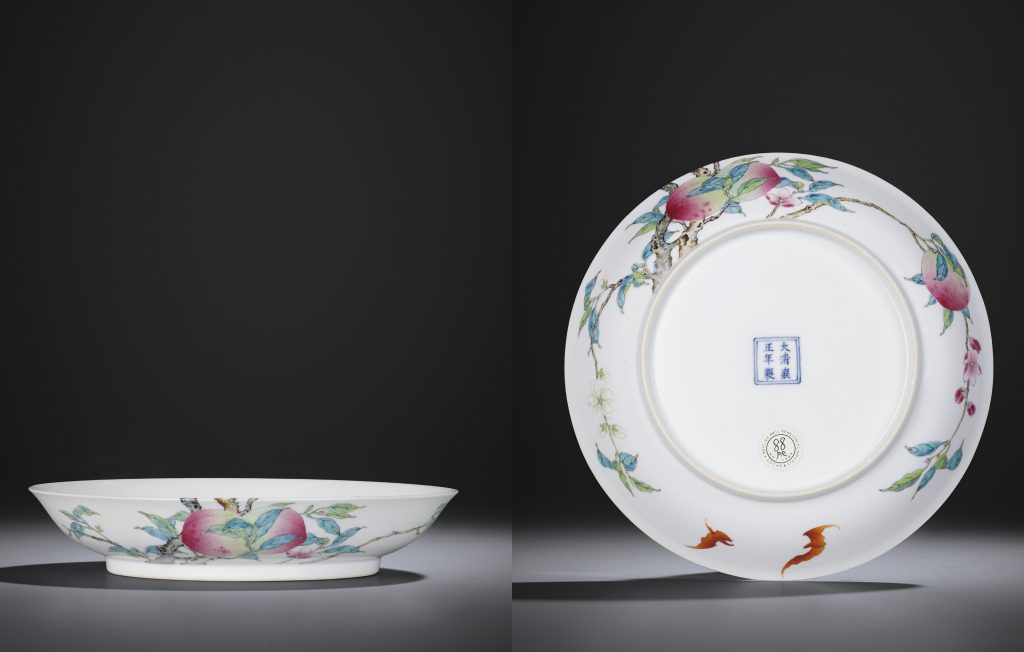
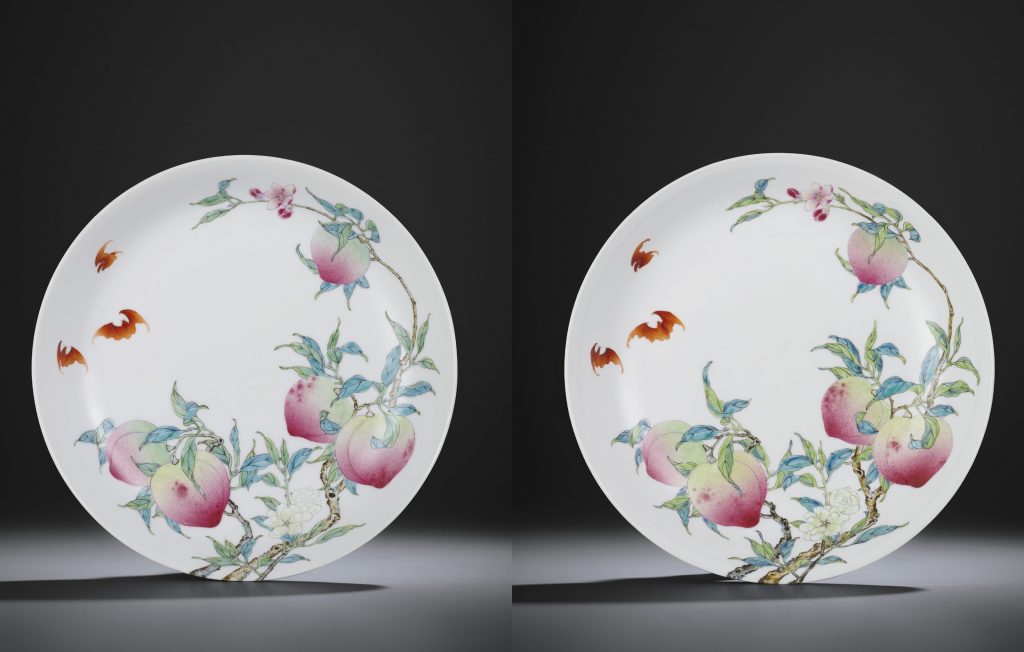
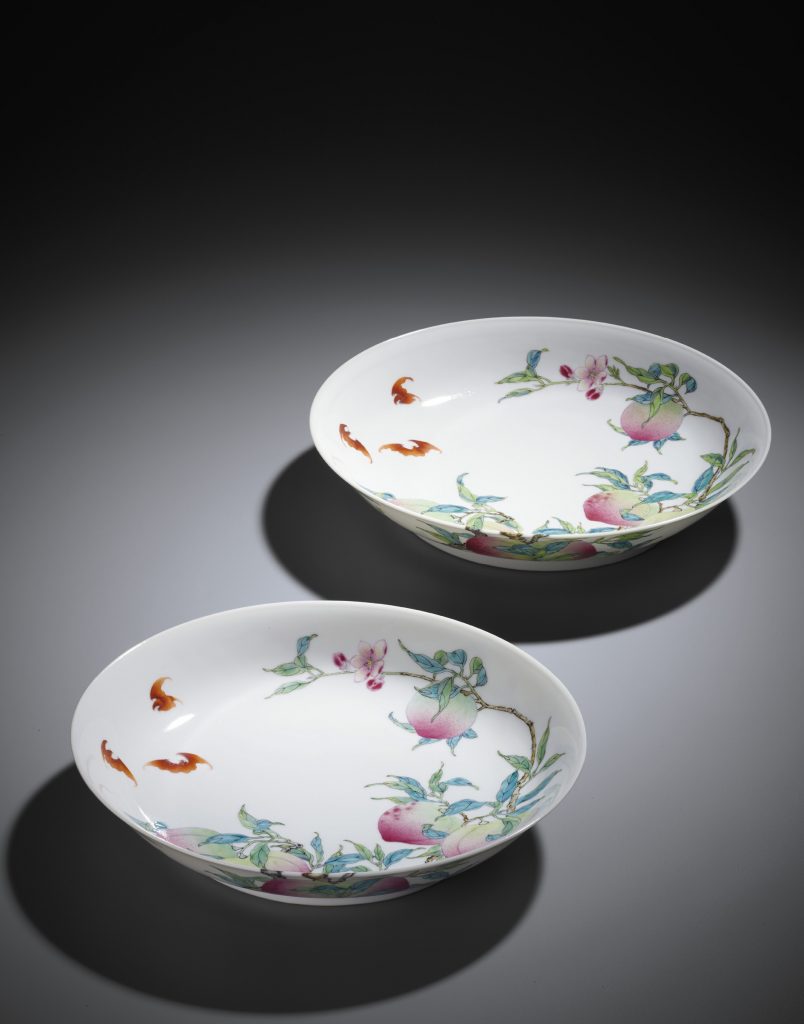
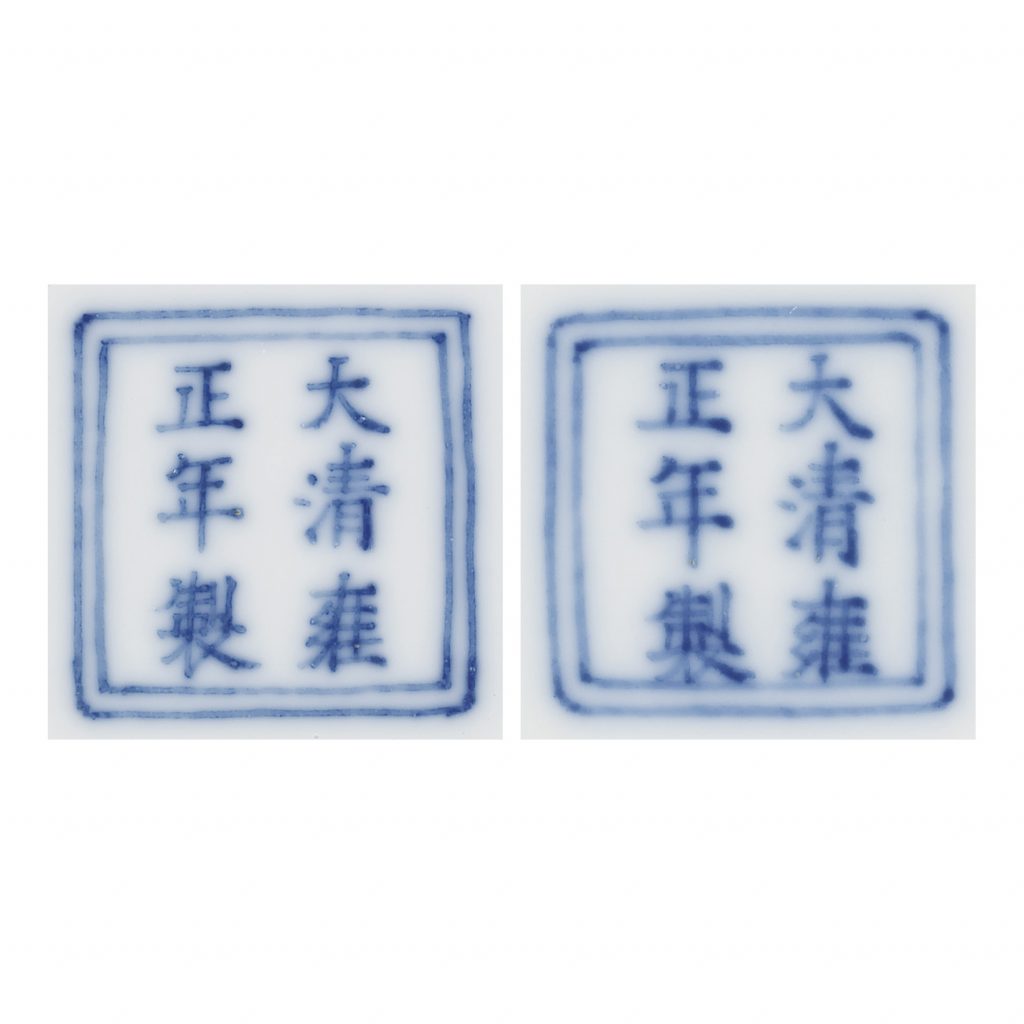
成交價HKD 46,040,000
估價HKD 40,000,000 – HKD 60,000,000
A MAGNIFICENT AND FINE PAIR OF IMPERIAL FAMILLE ROSE PEACH DISHES
YONGZHENG SIX-CHARACTER MARKS WITHIN DOUBLE SQUARES AND OF THE PERIOD (1723-1735)
Each dish is thinly potted with low rounded sides rising from a shallow foot ring to an everted rim with a gently rounded edge. Both are superbly enamelled in varying shades of pink, green, brown, yellow, white, black and iron-red. Each of the exterior is designed with three peaches on growing on flowering branches beside two bats. The design continues over the rim and into the interior with a further five peaches and three bats.
8 1/8 in. (20.7 cm.) diam., Japanese wood box (2)
來源
Barbara Hutton (1912-1979)
Sold at Sotheby’s London, 6 July 1971, lot 265
Bluett & Sons, London
Sold at Sotheby’s London, 8 July 1974, lot 408
Hugh Moss
Sold at Sotheby’s Hong Kong, 29 November 1977, lot 160
The British Rail Pension Fund
Sold at Sotheby’s Hong Kong, 16 May 1989, lot 88
出版
Sotheby’s Hong Kong Twenty Years, Hong Kong, 1993, p. 202, no. 276
展覽
On loan at the Dallas Museum of Art, 1985-1988
瀏覽狀況報告
– In excellent overall condition.
拍品專文
The present pair of dishes belongs to a group that are decorated with a total of eight peaches growing flowering branches and accompanied by five bats, forming the auspicious wufu, from the Yongzheng period. Some of these dishes bear a six-character reign mark within double-squares as in the case of the present examples, or on others the marks appear within double-circles.
Peach dishes appear in four differing sizes, the present dishes are second largest in size among the group, and similar to the dish in the Nanjing Museum, illustrated by P. Lam in Qing Imperial Porcelain, Chinese University of Hong Kong, 1995, no. 62 (21 cm.); a dish in the British Museum Collection, illustrated in Oriental Ceramics, The World’s Great Collections, vol. 5, Kodansha series, 1981, no. 226 (20.6 cm.); and from the John M. Crawford, Au Bank Ling and Robert Chang collections, sold at Christie’s Hong Kong, 27 October 2003, lot 665 (20.9 cm.).
For examples of largest dishes of this pattern, see Far Eastern Ceramics in the Victoria and Albert Museum, Kodansha series, 1980, col. pl. 63 (50.5 cm.); and in the Beijing Palace Museum, illustrated in Porcelains with Cloisonne Enamel Decoration and Famille Rose Decoration, the Complete Collection of Treasures of the Palace Museum, Commercial Press, 1999, p. 66, no. 56. It is interesting to note that the reign marks of the largest dishes (those over 50cm diam.) are written within double-circles, and not rectangles as with the cited smaller examples.
It is believed by many scholars that this particular design was applied to vessels made for the celebration of imperial birthdays. The composition of eight peaches and five bats is very auspicious. The eight peaches symbolise extended long life through their association Shoulao, the Star God of the Longevity, and also through association with the peaches of longevity grown in the orchard of the Queen Mother of the West. The five red bats provide rebuses both for good fortune and for the Five Blessings of longevity, health, love of virtue and a peaceful death.
参考:故宫博物院【粉彩过枝桃树纹盘】
清代瓷器装饰大都借助自然景物寓意吉祥,今日介绍的“粉彩过枝桃树纹盘“亦是如此。“过枝花”是指从器内延伸至器外的画面俗称,如”过墙龙“、“过墙凤”等,粉彩过枝桃树纹盘形体硕大,高8.4cm,口径50.6cm,足径18.1cm,盘内底彩绘一株桃树沿盘壁蜿蜒伸展至外,其树桃花盛开,果实累累,结有9颗桃实,其中6颗在盘内,3颗在盘外,枝旁飞舞数只红蝙蝠,圈足内施白釉。外底署 “大清雍正年制“六字青花楷书,外围青花双线圈。
我们都知道桃代表“寿“,蝙蝠代表”福“。此盘纹饰主题寓意”福寿双全“。以九桃纹装饰瓷器虽是雍正官窑瓷器的题材和样式,但雍正官窑粉彩瓷器上所绘蟠桃多绘八只,而乾隆时则多绘九只桃实,因此有”雍八乾九“之说。此粉彩过枝桃树纹盘保存于故宫博物院,为雍正官窑,绘有九只桃实实属珍贵。
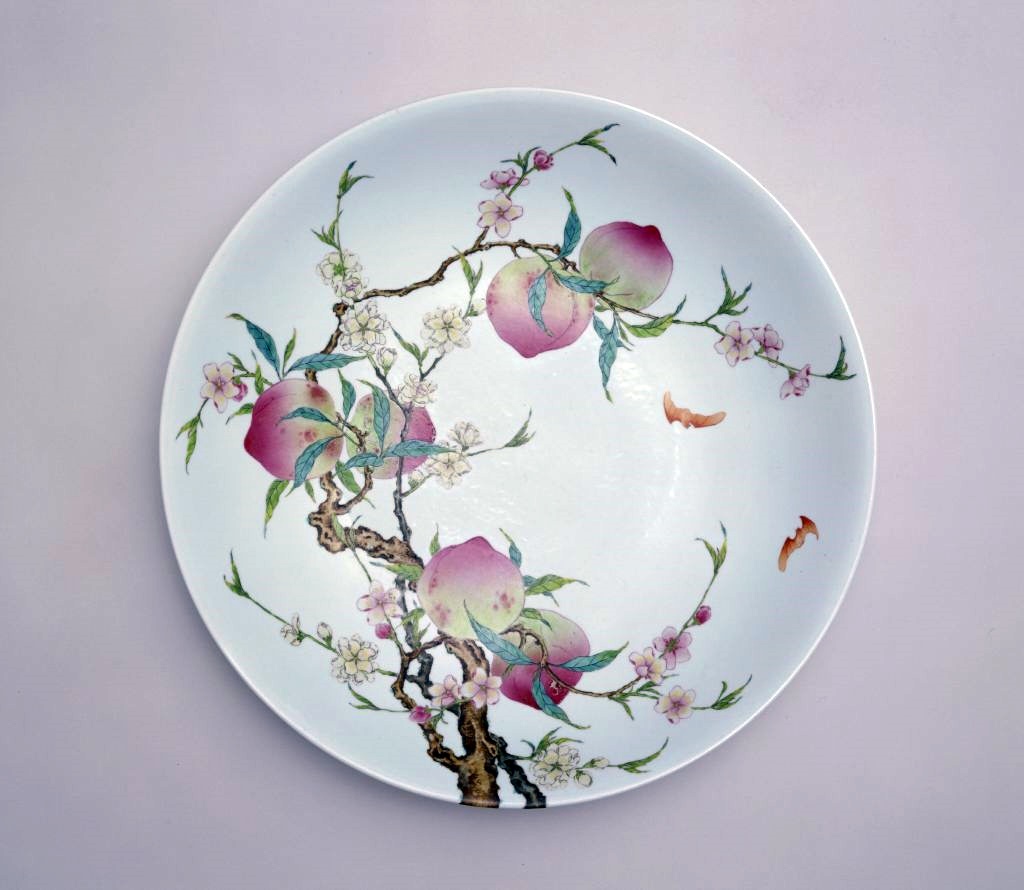


粉彩过枝桃树纹盘,清雍正,高8.4厘米,口径50.6厘米,足径28.1厘米。
盘撇口,弧壁,圈足。内底彩绘一株桃树沿盘壁蜿蜒伸展至外壁,上结有9枚桃实,6枚在盘内,3枚在盘外。枝旁飞舞数只红蝙蝠。桃花盛开,果实累累,红色的桃实,粉色的桃花,嫩绿的枝叶,画面喜庆吉祥。圈足内施白釉。外底署青花楷书“大清雍正年制” 双行六字款,外围青花双线圈。
此盘形体硕大,造型端庄,纹饰主题寓意“洪福齐天”、“福寿双全”。这种从器内延伸至器外的画面俗称“过枝花”。清末寂园叟撰《陶雅》曰:“庚子后,所出五彩过枝之盘碗甚多,有桃实八枚缀于枝上者,索价亦甚巨。过枝云者,自此面以达于彼面。枝干相连,花叶相属之谓,皆雍正官窑也。”此种画法起源于清康熙时期,一直影响及道光时期,亦见有“过墙龙”、“过墙凤”等。晚清以后这种画法不多见。
撰稿人:郑宏
关键词: 粉彩 青花 五彩
Peach Blossoms
Charming peach blossoms rival the apricot flowers in beauty in March.

Often flowering in March, peach blossoms are regarded as the sign of spring because they appear before the leaves sprout. And they are often associated with love and marriage, because spring is traditionally regarded as a season of romance. The ancient Chinese also believed that peach wood could protect people from spectral evils, and peach fruits could help improve health and prong life.
Peach blossoms have been the muses of Chinese literati and poets for a long time. They considered peach blossoms as the prelude to spring in their poems and celebrated the vitality of the flowers possessed.
参考:
The Cleveland Museum of Art
Dish with Bats and Peaches
China, Jiangxi province, Jingdezhen kilns,
Qing dynasty (1644-1911), Yongzheng mark and reign
(1722-35)
Porcelain with famille rose overglaze enamel decoration

China, Jiangxi province, Jingdezhen kilns,
Qing dynasty (1644-1911), Yongzheng mark and reign
Diameter: 20.6 cm (8 1/8 in.)
Worcester R. Warner Collection 1930.639
EXHIBITION HISTORY
Arts of China from The Cleveland Museum of Art, Mansfield Art Center, Feb. 27-April 10, 1983
A Study Exhibition of Chinese Textiles of the Ming and Ch’ing Periods. The Cleveland Museum of Art, Cleveland, OH (organizer) (December 12, 1947-October 9, 1948).
Meaning of Nature in Chinese Art. The Cleveland Museum of Art, Cleveland, OH (organizer) (April 9-June 1, 1954).
参考:春季拍卖会
北京保利十二周年秋季拍卖会
御工美器——私家藏明清工艺精品
5940 清嘉庆 粉彩九桃盘 (一对)

尺寸 直径19.5cm
创作年代 清嘉庆
估价 800,000-1,200,000
成交价 RMB 1,092,500
“大清嘉庆年制”款
撇口,弧壁,平底,圈足。粉彩装饰,盘内、外壁绘桃蝠纹,一株桃树枝繁叶茂,由盘外壁弯曲盘内,粉花绿叶,八枚嫣红熟透的硕桃悬挂枝头,五只红蝠展翅飞舞。外底矾红书“大清嘉庆年制”六字三行篆书款。为嘉庆官窑器物,成对保存,甚为稀见。
“过枝花”是瓷器纹饰的一种特殊构图方式,这种内外壁或器身与器盖的纹饰相连,浑然一体,似花枝越过墙头,故称为“过墙花”,装饰技法别致新颖,有独特艺术风格。许之衡《饮流斋说瓷》记过枝花画法“成化开其先”,但传世器未见成化时期的器物。目前传世品以康熙朝斗彩“御赐纯一堂”款凤竹纹碗为最早。清代雍正、乾隆时期较为流行,有过枝花卉、花果及龙纹等。道光、光绪时期有过枝葡萄、赖瓜纹常见。
粉彩瓷始创于清康熙朝,雍正、乾隆时期迅猛发展,嘉庆时期粉彩袭承乾隆御窑精华之大成。画面多为福寿吉庆纹饰。蝠桃图为清代粉彩瓷器装饰典型的吉祥图案,雍正乾隆两朝均有烧制,画意内容相同,图案寓有“蟠桃献寿”之意,嘉庆粉彩过枝八桃纹盘十分罕见。此类福寿纹器应是万寿节的用品。器胎薄体轻,纹样疏密有致,敷彩新嫩,清新隽雅,纹饰绘制精工,画意生动。
备注:彼得凯姆(Peter Kemp)收藏,1980年代购于伦敦
参考:赤峰博物馆
典藏文物
清乾隆款粉彩九桃盘

入藏日期 1975-01-01
鉴定日期 2004-06-01
鉴定意见 定为一级文物
尺寸 口径46.3,高9.2,底径30.3(cm)
形态特征 敞口,浅腹,圈足。盘内外绘粉彩过枝桃花纹,褐色枝,绿叶,粉红色桃花间饰一对蝙蝠。盘内外共九桃,底有“大清乾隆年制”红彩楷书款。
完残状况 完整
参考:北京秋拍瓷器之王
十面灵璧山居旧藏「雍正粉彩八桃五蝠大盘」RMB 3,850万成交




来到北京秋季拍卖尾声,瓷器之王终于出炉。
直径达50 cm的「雍正 粉彩八桃五蝠大盘」于保利上阵,RMB 3,350万落槌,连佣RMB 3,852万易手,成交价冠绝在香港、北京两地拍卖周登场的古玩瓷器。
此盘卖方为「十面灵璧山居」,乃北美重要藏家,也就是早前以逾RMB 5亿天价成交的《十面灵璧图》旧主。
Lot 1763|清雍正 粉彩过枝福寿双全八桃五蝠大盘 「大清雍正年制」款
直径:50.5 cm
来源:
亚洲重要私人收藏
香港佳士得,1994年5月2日,编号675(封面),成交价HK$4,420,000
德善堂家族收藏
香港苏富比,2004年10月31日,编号143,成交价HK$12,942,400
北美十面灵璧山居收藏,编号EK257
估价:RMB 16,000,000 – 26,000,000
落槌价:RMB 33,500,000
成交价:RMB 38,525,000
拍卖官蓝晨以RMB 1,400万起拍,迅速获得各方热烈竞投,连获18口叫价后已达至RMB 2,500万水平。此时,场内有客户喊出超越竞价阶梯的RMB 3,000万,获得一片掌声。
不过争夺战并未就此结束。
叫价至RMB 3,300万时,金额或许已经和大家预算相约,所以竞价阶梯降至RMB 10万、乃至RMB 5万一口。最终拍官以RMB 3,350万落槌,连佣RMB 3,852万售出。
盘心粉彩绘苍茂桃树,沿盘壁蜿蜒伸展至外壁,枝上雅绘盛开桃花,缤纷花蕾。八颗嫣红桃实 – 五颗盘内,三颗盘外。桃枝盈间,以矾红绘就三只蝙蝠飞舞盘心,另有两只绘于外壁,底足青花双方框内书「大清雍正年制」六字三行楷书款。
粉彩过枝福寿双全乃雍正、乾隆两朝御窑瓷器的著名纹饰。清宫御器除了工艺上巧夺天工,最重视的莫过于吉祥寓意。
一般而言,雍正朝多绘「八桃」,正如此大盘一样,乾隆朝则多画「九桃」。蝙蝠方面,通常都是「五蝠」,取「五福」音谐,指高寿、富贵、康宁、好德、善终;「倒」音谐「到」,蝙蝠倒飞实为福到之意。 「过墙枝」音谐「长治」,借喻政通人和、长治久安。



整个图纹加起来,取「福寿双全」、「洪福齐天」之意,既有歌功颂德之心,亦含祝圣上万寿无疆。
2018年北京春季拍卖,保利曾有一对「雍正 粉彩过枝八桃五蝠盘」拍卖,为晚清重臣胡湘林旧藏,连佣RMB 5,060万售出。
至于是次拍卖的雍正粉彩盘,于1994年首度在佳士得拍卖易手,归入德善堂家族收藏。 10年以后,粉彩盘再度在香港亮相,HK$1,294万成交,后成为「十面灵璧山居」雅蓄。
参考:保利
种桃种李种春风——清宫御窑与珍玩集萃



D20.2cm
“大清雍正年制”款
备注:上海晚清重臣胡湘林先生及其家族旧藏
本品盘为一对,敞口,弧壁,圈足。盘心以粉彩绘一株苍茂桃树,沿盘壁蜿蜒伸展至外壁,枝上雅绘盛开桃花,缤纷花蕾,八颗嫣红桃实,五颗于盘内,三颗于盘外,浑然一体;桃枝盈间,以矾红绘就三只蝙蝠飞舞于盘心,另有两只绘于外壁,底足青花双倭角方框内书“大清雍正年制”六字三行楷书款。
文献中记载:王母命侍女以玉盘盛仙桃七颗,大如鸭卵,形圆青色,王母以三颗与帝,帝食之甘味,收核欲种之,王母曰:“此桃三千年一生实,中夏地薄,种之不生如何!”帝乃止。于坐上酒觞数过,王母乃命侍女王子登弹八琅之璈,又命侍女董双成吹云龢之笙,又命侍女石公子击昆庭之钟,又命侍女许飞琼鼓震灵之簧,侍女阮凌华拊五灵之石,侍女范成君击洞庭之磬,侍女段安香作九天之钧。于是众声澈朗,灵音骇空。

左:清雍正 粉彩福寿双全橄榄瓶 上海博物馆 张永珍博士捐赠
右:清雍正 粉彩折枝三果花卉纹梅瓶 The Walters Art Museum

台北故宫博物院

2015年4月7日,编号112
成交价89,800,000
此对盘,其上以精湛的笔法工笔写出一颗桃树,其枝干虬错矫健,蜿蜒而生,时而乍然转折,却总与碗形相得益彰。花蕊及花苞以细笔淡墨勾勒,突显其高洁清雅,密而不乱,充分表现画家功力。形态端庄秀雅,运用过枝花的手法在白底上从器外壁起画,经过口沿,延续到器内壁,绘八桃五蝠,取“洪福齐天”、“福寿双全”之意,雍正时期一般绘八桃,乾隆时多绘九桃,故有“雍八乾九”之说。本品布局构图之妙见于“过枝”技法之运用。过枝又称“过墙”,即花绘布局将碗盘内和外壁相连通,图案自盘外壁攀延过盘边伸展铺陈于盘心,使内外图案既独立成章又浑然一体。


本品寿桃之上所用彩料,应为西洋金红彩所描绘。此种金红彩为用金红玻璃粉末,水,胶或油调制而成。此技法,为在纤细透明玻璃热溶液中加入金作为着色剂,并以特殊油剂调和。由于使用纯金作为着色剂,金纳米颗粒于五十倍以上的放大镜下,可清晰观瞧出细微金属的析出。可见红彩放大一定倍数之后,星星点点黄金颗粒析出。而调制珐琅彩料的油剂,据清宫档案记载,为进贡而来,称为“多尔纳门油”,由于此油剂为进贡之物,数量极罕,后来慢慢就被“芸香油露”所取代,此种芸香油露应为国内开发来代替进口油料,同时,清档文献中亦提到“西洋冰片油”,如雍正时期便可查档案,提及此类西洋冰片油所剩状态之说法。


本对盘之纹样画工,细腻典雅,施彩技术亦妙至毫巅。每朵桃花均用极细的深色线勾勒轮廓,既层次分明,又无损花瓣之娇美。花瓣本身的颜色粉中泛黄,向花芯处的渐变深浅有致,纤细的花蕊用蛋黄料彩厚涂而成,甚具立体效果。此式填涂方法,与两岸故宫所藏,雍正时期瓷胎画珐琅之式颇为一致。
本对雍正八桃五蝠福寿双全盘,为胡湘林家族,历经三朝变迁,秘藏百年,配有原装楠木匣箧,初次面世,殊为珍重。
胡湘林
胡湘林(1857~1925年),又名湘霖,字揆甫,号竹泉,江西南昌新建县联圩乡治坪洲人。道光时期都察院左都御史,胡家玉第四子。胡湘林幼承庭训,精通经史,为光绪元年(1875年)乙亥科举人,光绪三年(1877年)丁丑科会试中二甲六十一名进士,钦点翰林院庶吉士。八国联军攻打北京,慈禧太后与光绪帝向西逃往西安,曾向慈禧太后应答西安城详情,使胡湘林得到重用。档案记载,同年十月,胡湘林升授延榆绥道,留办供直,之后又升为陕西布政使、藩台,兼任凤邠法道。之后胡湘林仕途顺畅,一路迁升至两广总督的职位。据《新建县历史名人》记载,1907年4月,清廷两次任命胡湘林为署理(代理)两广总督兼海关税务。1909年,胡湘林奏请扩充广东制造军械厂告成,后又奏请为广东制造军械厂购买制快炮机器,积极为增强国力而奋斗。胡湘林乃中国近代海军创始人之一、北洋水师推动者。晚清时期,洋务运动、变法图强几乎席卷了整个中国,然而终究因种种原因不得善终。胡湘林曾经被邀请出任中华民国副总理等职务,因他的政治主张和当局有一定的差异,便拒绝出任民国政府的任何职务。晚期,定客居上海。1925年,胡湘林先生在上海去世,葬于上海法华乡,享年六十九岁。

![[临渊阁]天地一家春](https://www.antiquekeeper.ca/wp-content/uploads/2023/03/antiquekeeper_banner_image_2-4.jpg)
